Blue Carbon
This briefing outlines the current understanding of carbon captured and stored in Scotland's coastal and marine environment, known as blue carbon. This briefing outlines the known threats to blue carbon stores, and compares their carbon storage capacity to Scotland's well-known terrestrial carbon stores: peatland and forestry. In addition, this briefing explores Scottish policy areas relevant to the protection of blue carbon stores on the basis of their contributions to biodiversity and climate change mitigation.
Summary
What is blue carbon?
Blue Carbon refers to carbon captured (sequestered) and stored in the marine and coastal environment. In Scotland, living (biological) marine and coastal habitats (such as saltmarshes, sand dunes, seagrasses, kelp beds, and biogenic reefs) and geological sedimentary stores (such as seafloor and sea loch sediments) store carbon.
Collectively, Scotland's blue carbon environments store 9,636 Mt CO2-eq (Megatonnes of CO2-equivalent). This is roughly equivalent to the total of carbon stored in Scotland’s land-based ecosystems (9, 546 Mt CO2-eq) such as peatlands12, forestry3and soils4.
Annually, Scotland's blue carbon stores sequester 28.4 Mt CO2-eq5, which is approximately three times greater than the annual carbon sequestration of Scottish Forestry (9.6-11 Mt CO2-eq per year67).
Geological seafloor and sea loch sediments store 99.84% of Scotland's blue carbon. Scotland's biological habitats and species store the remaining 0.16% of Scotland's blue carbon. Despite their small contribution to Scotland's blue carbon sequestration and storage, biological habitats and species play a crucial role in supporting Scotland's biodiversity and resilience to climate change.
Climate Change & Blue Carbon:
1) Protecting current blue carbon stores
The main threats to Scotland's blue carbon are physical disturbances, climate change, and land-use and land management changes. If unprotected from threats, blue carbon habitats may release their stored carbon, becoming a future source of carbon emissions.
Some Scottish blue carbon habitats are protected from threats, based on their contributions to Scotland's biodiversity, mainly in the form of marine protected areas (MPAs). This is also reinforced in the 2019 Climate Change Act, which requires Ministers to set proposals and policies in their Climate Change Plan that consider carbon storage in the marine environment when designating MPAs.
2) Enhancing blue carbon sequestration
Blue carbon environments can contribute to climate change mitigation by sequestering additional carbon through their expansion and restoration (nature-based solutions) or deliberate large-scale manipulation (geoengineering).
Several blue carbon habitats (in particular, biogenic reefs) annually sequester more carbon on a per area basis, compared to terrestrial habitats. Scottish saltmarsh restoration has been shown to increase carbon sequestration, climate change resilience and biodiversity. However research is ongoing to determine the impact of restoration projects on carbon sequestration in Scotland.
There are currently no policies in Scotland’s Climate Change Plans to promote the restoration of blue carbon habitats, in comparison to peatlands and forestry which have well-developed policies for restoration and expansion.
What is Blue Carbon?
Blue carbon refers to carbon captured (sequestered) and stored in coastal (where land meets the sea) and marine (sea) environments. In this briefing, blue carbon refers to carbon sequestered and stored in both living, biological habitats and species and geological sedimentary stores.
Definition of Blue Carbon
The 'blue carbon' concept was introduced as a metaphor aimed at highlighting that coastal ecosystems, in addition to terrestrial 'green' carbon stores, contribute significantly to carbon sequestration1. The definition of blue carbon is still highly debated. The Intergovernmental Panel on Climate Change (IPCC) primarily considers vegetated coastal ecosystems (mangroves, saltmarshes and seagrasses) as blue carbon habitats2. Other definitions, such as that of the Scottish Blue Carbon Forum, include carbon stored in both living marine and coastal habitats and geological sedimentary stores.
Biological blue carbon stores
Biological blue carbon in this briefing encompasses carbon sequestered and stored in coastal habitats (saltmarshes, sand dunes and machair) and marine species and habitats (phytoplankton, kelp, seagrasses, and biogenic reefs). Mangroves are also an important biological blue carbon habitat but are not discussed in this briefing as they do not exist in Scotland.
Biological blue carbon habitats and species directly sequester carbon from the atmosphere and store the carbon in living biological material and, in some cases, in the underlying soil or sediment. These habitats store carbon from just a number of months to thousands of years. After this time, the living biomass decays, releasing the stored carbon back into the water column or atmosphere. Some of the carbon in living material may escape decay after death and become buried in geological blue carbon stores, thereby entering long-term carbon storage.
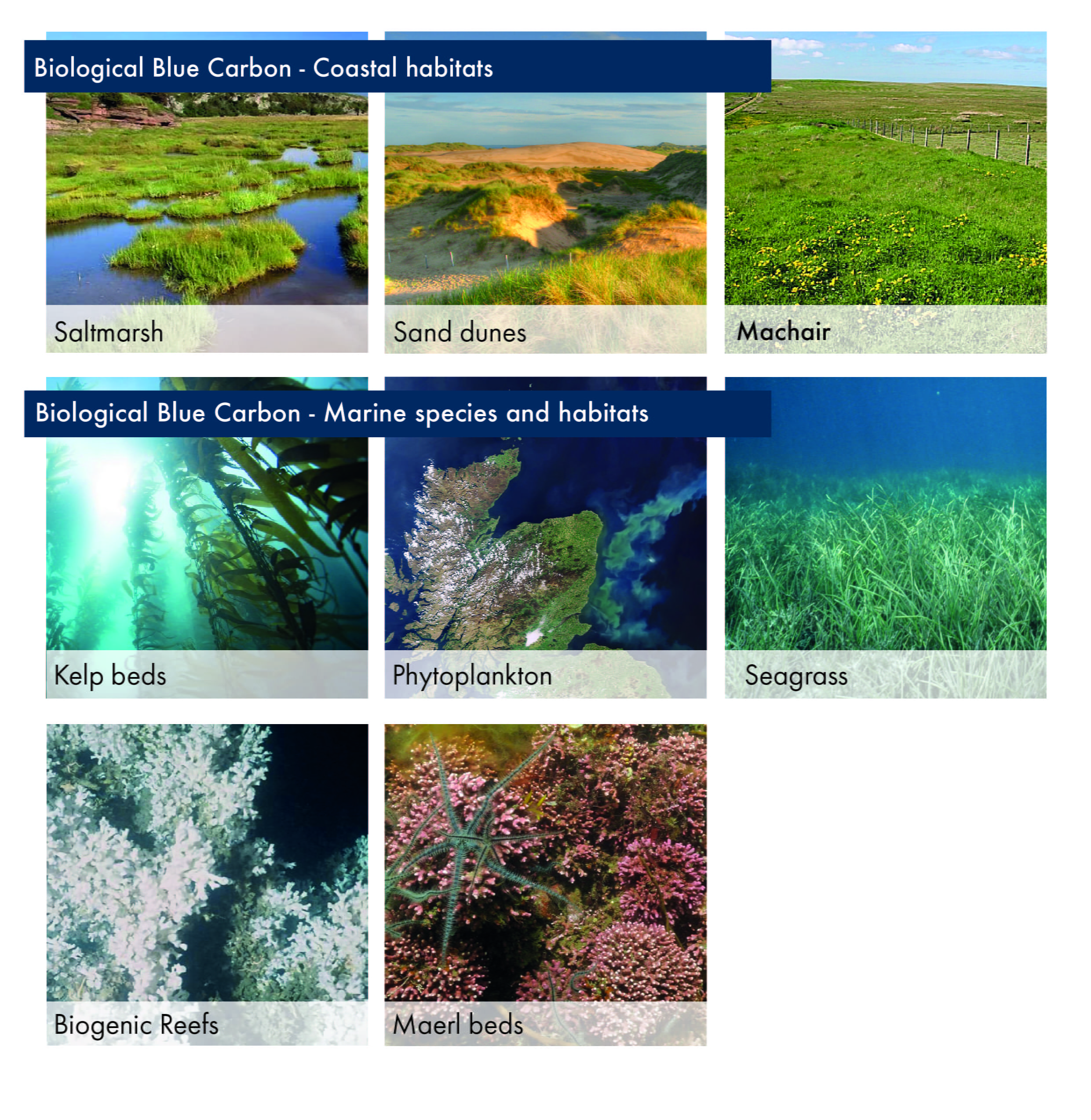
Geological blue carbon stores
Geological blue carbon refers to carbon stored in sediments across Scotland's seafloor or sediments in sea lochs. Geological blue carbon stores contain carbon derived from dead biological material from the marine environment (biological blue carbon) and the terrestrial environment - transported by rivers. Geological systems do not directly sequester carbon from the atmosphere but rather receive carbon from once-living biological systems. Therefore biological and geological blue carbon stores are linked but operate on different timescales. Geological blue carbon stores store carbon for 1,000s - 100,000s of years and are therefore long-term carbon stores.
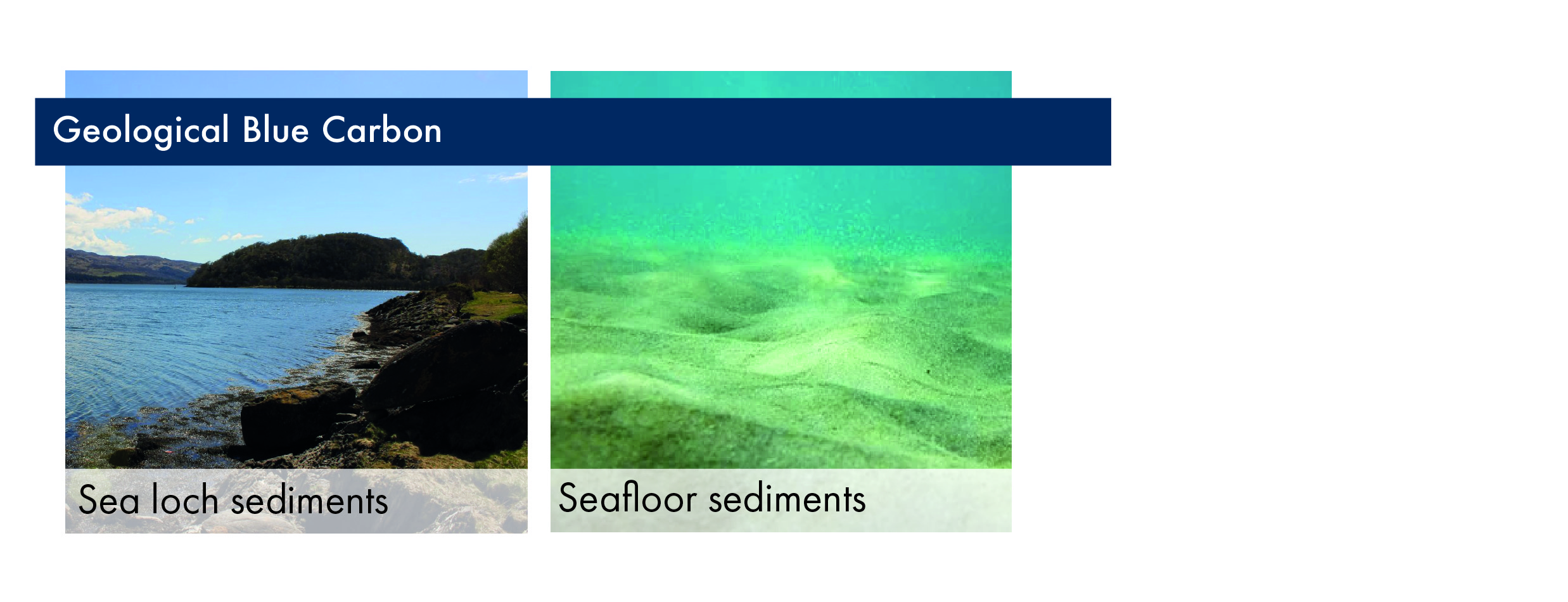
Carbon Stores and Sequestration
Carbon is distributed between environmental stores such as the atmosphere, the biosphere (living organisms), oceans or rocks. Carbon stores are typically measured in megatonnes (Mt) of CO2-equivalent (eq). To convert from carbon stored or sequestered to the equivalent carbon dioxide value, carbon masses or rates are multiplied by 3.67.
Carbon sequestration is when carbon (usually as carbon dioxide - CO2) is captured from the environment and stored in biological or geological stores. Carbon sequestration is a rate: Mt CO2 equivalent (eq) per year.
Carbon sequestration in this policy briefing refers to carbon that a habitat or species captures, either directly or indirectly, and stores for at least 100 years - typically in underlying soils, sediments or dead shell material. As kelp and phytoplankton only store carbon in their living biomass, carbon sequestration in these ecosystems refers to the contribution of dead kelp/phytoplankton biomass to carbon burial in sediments (See kelp or phytoplankton for further discussion).
Scotland's Blue Carbon
Geological blue carbon: carbon stored in seafloor sediments or sea loch sediments.
Biological blue carbon: carbon stored in living biological habitats, such as saltmarshes, seagrasses, kelp, phytoplankton, maerl beds, or biogenic reefs.
Scotland's largest blue carbon store is seafloor sediments.
Geological blue carbon stores contain 99.84% (9,620 Mt CO2-eq) of Scotland's blue carbon 1 which exceeds estimates of the total carbon stored in the terrestrial environment.
Scotland's geological blue carbon stores sequester greater quantities of carbon (28.35 Mt CO2-eq per year) than biological blue carbon habitats and species (0.06 Mt CO2-eq per year) and any terrestrial environment. This is primarily due to the large spatial extent of sediments over Scotland's sea floor, which is around six times greater than Scotland's land area.
Biological blue carbon habitats contribute significantly less to Scotland's blue carbon storage but are important for biodiversity and climate change resilience.
Biological blue carbon habitats and species store 0.16% of Scotland's total blue carbon (15.7 Mt CO2-eq).
Some biological blue carbon habitats and species, particularly biogenic reefs, have higher carbon sequestration rates on a per unit area basis than geological blue carbon stores or terrestrial habitats. However, their overall contribution to Scotland's annual carbon sequestration is small due to their small spatial extent.
Biological blue carbon habitats and species make important contributions to Scotland's biodiversity and resilience to climate change.
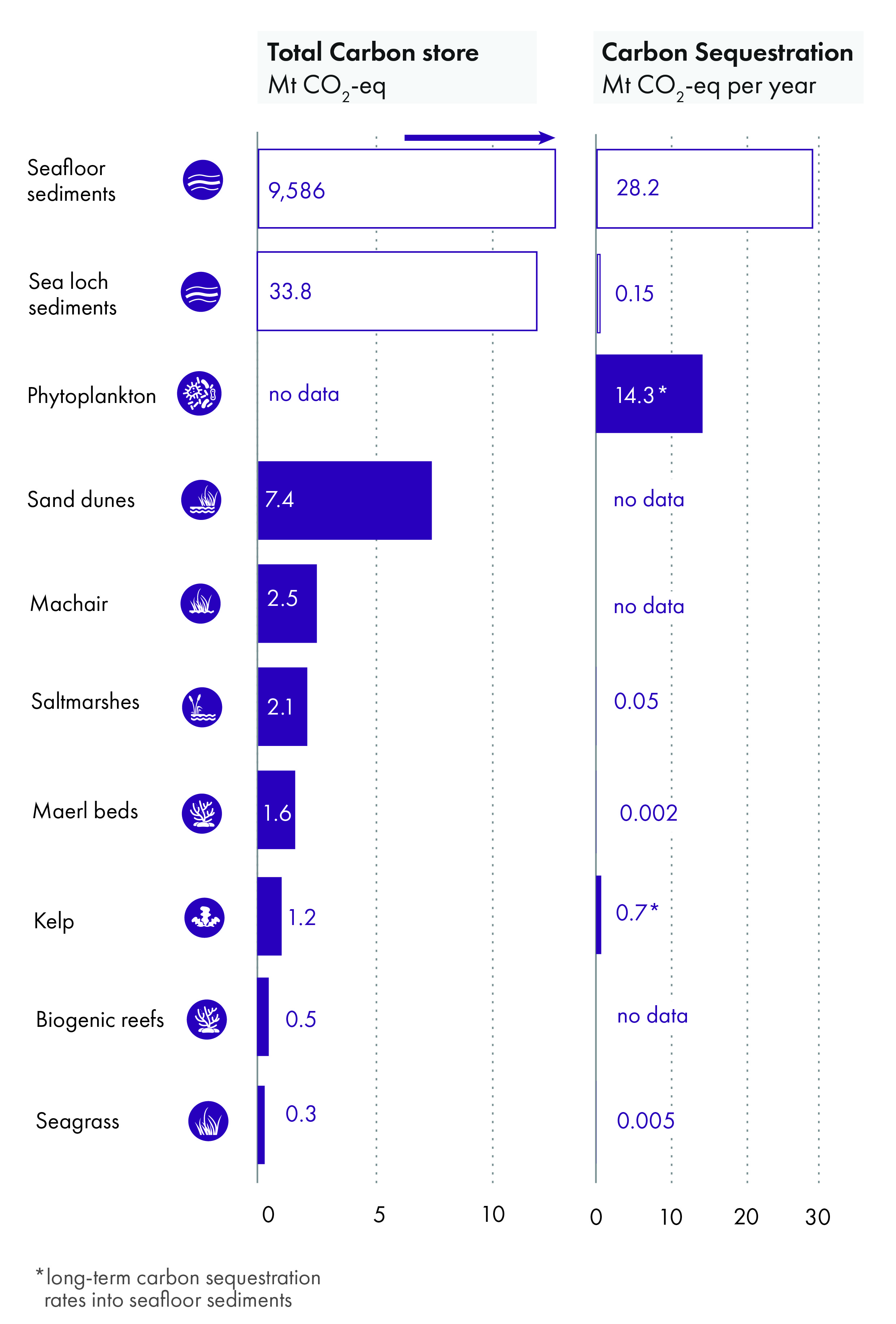
Biological Blue Carbon
Carbon stored and sequestered by biological blue carbon habitats and species remains an active research area, including within the Scottish Blue Carbon Research Forum.
Inorganic versus organic carbon
Living biological systems can sequester and store carbon in two chemical forms: organic and inorganic carbon. Some organisms can harvest the sun's energy (photosynthesis) to produce sugars made of organic carbon. Some organisms can also produce shells or exterior structures (e.g. corals) made of calcium carbonate, through calcification. This carbon is inorganic carbon.
Coastal habitats
Saltmarshes
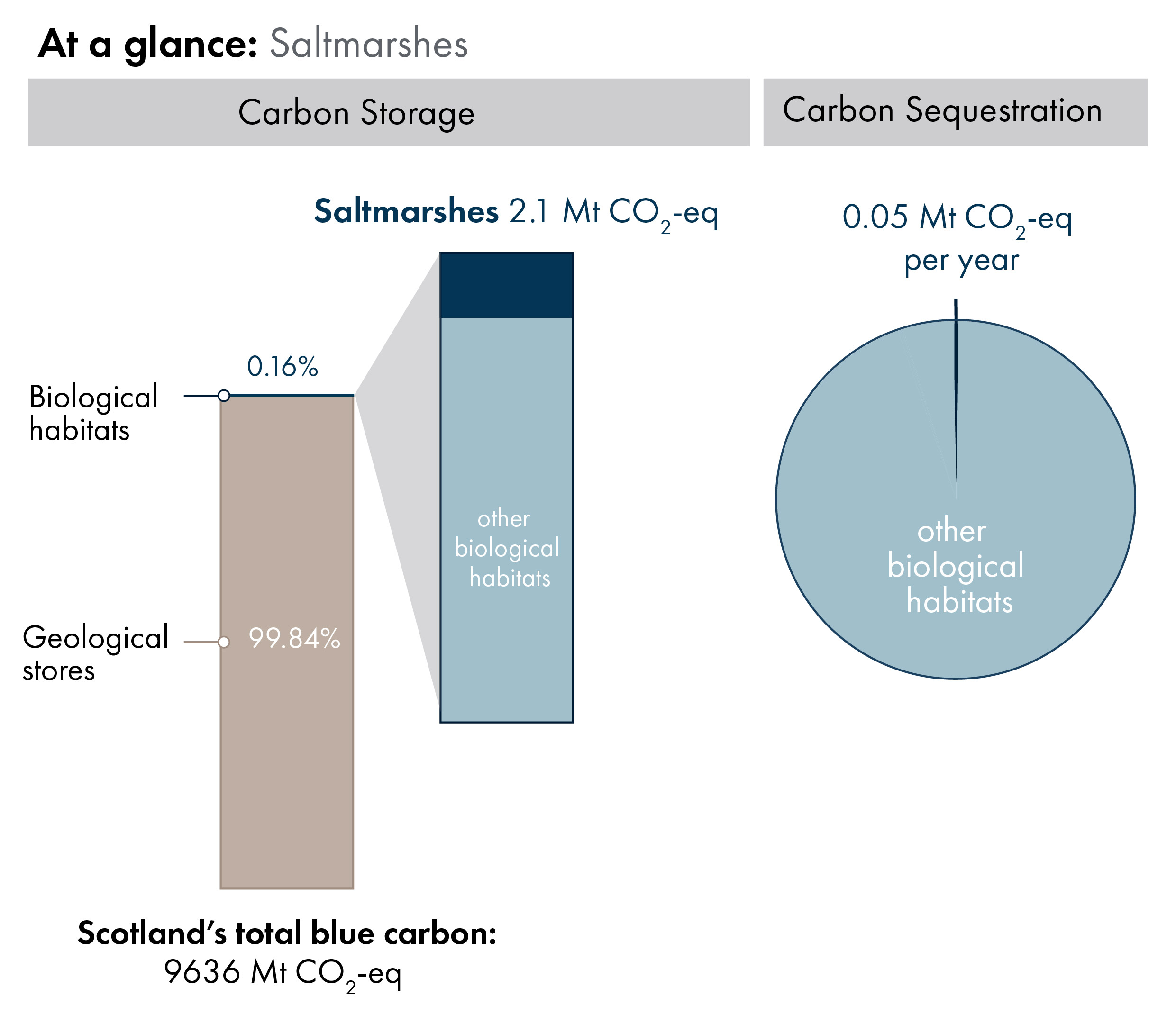
Saltmarshes are wetland habitats dominated by salt-tolerant vascular plants. Saltmarshes are regularly flooded and drained by salt water brought in by tides. Saltmarshes store carbon in their underlying sediments for up to thousands of years. An assessment of Scottish saltmarshes at Loch Laxford and Kyle of Tongue suggest these environments store carbon for around 1600 years3.
Distribution
The Scottish Saltmarsh Survey, conducted between 2010-2012, estimated that saltmarshes cover 77.04 km2 of Scotland's coast4. The largest saltmarshes in Scotland are located in the Solway Firth and Moray Firth. Many smaller saltmarshes are located at the head of sea lochs, bays, and on beaches in northwest Scotland.
Carbon Storage and Sequestration
Carbon storage and sequestration by Scotland's saltmarshes is an active research area through projects like the C-side project and the Scottish Blue Carbon Research Forum. Scotland's saltmarshes store an estimated 2.1 Mt CO2-eq12. This estimate uses averaged organic matter density and saltmarsh depth values, both of which vary spatially across Scotland's saltmarshes.
There are currently no direct measurements of carbon sequestration by Scottish saltmarshes. Based on estimates of carbon sequestration in English saltmarshes7, Scotland's saltmarshes sequester approximately 0.05 Mt CO2-eq per year2. This value is potentially an overestimation as it uses an outdated estimate of Scottish saltmarsh area.
Wider importance of saltmarshes
Saltmarshes deliver numerous physical and biological ecosystem benefits. For example, saltmarshes dampen wave energy to reduce flood risk9 and filter pollutants from land run-off10. Providing there is an adequate sediment supply, saltmarshes can keep pace with sea-level rise making their expansion a natural strategy to manage coastlines. In the 2020 Challenge for Scotland's Biodiversity, the Scottish Government highlighted the important role of saltmarshes in resilience and adaptation to climate change.
Saltmarshes also support various bird, plant and invertebrate species and provide key habitats for juvenile fish species11. Coastal saltmarshes are not generally rich in plant species but are critical for breeding, wintering and migrating birds. The biodiversity richness of saltmarshes makes them popular landscapes for recreational activities such as walking and bird watching.

Sand dunes
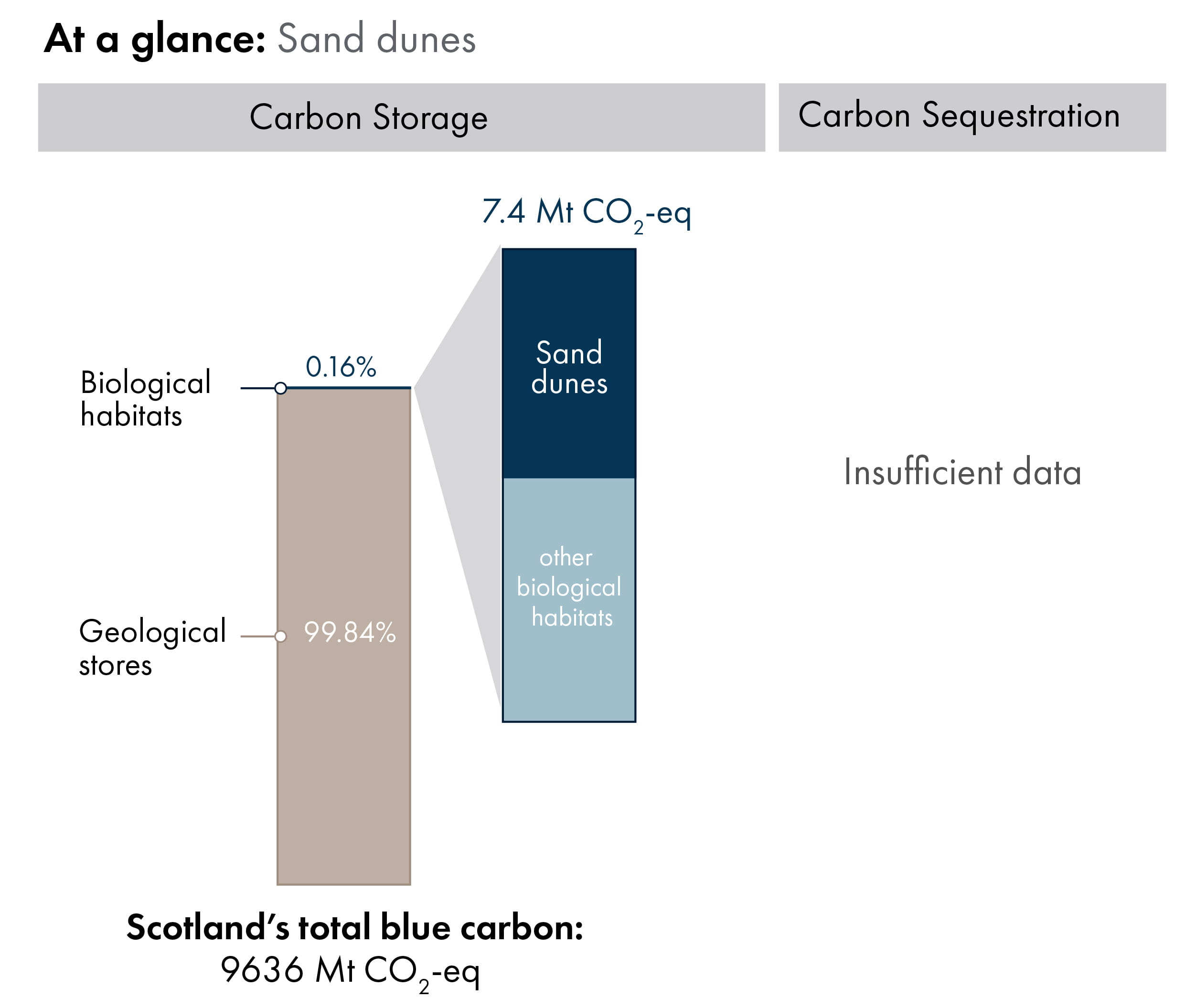
Distribution
Coastal sand dunes are habitats formed by sand blown inland from beaches, stabilised by vegetation. Sand dunes cover an estimated 495 km2 of Scotland's coast line1, representing 71% of the UK's sand dunes by area3.
Carbon Storage and Sequestration
Scotland's sand dunes store an estimated 7.4 Mt CO2-eq1. This estimate considers the carbon stored to a depth of 15 cm in slack (low-lying depressions between dunes), mobile and semi-fixed dune systems. There are currently no estimates for the total carbon sequestration rates across Scotland's sand dunes. However, other UK sand dunes sequester carbon at an estimated rate of 217 g CO2-eq per m2 per year5(for comparison, see Annual Carbon Sequestration per unit area).
Wider importance of sand dunes
Sand dunes provide a rich habitat for biodiversity, supporting birds, reptiles, insects, vascular plants, bryophytes, lichens and fungi. Numerous species listed on the Scottish Biodiversity List, species of conservation priority in Scotland, are found in sand dune habitats.

Machair
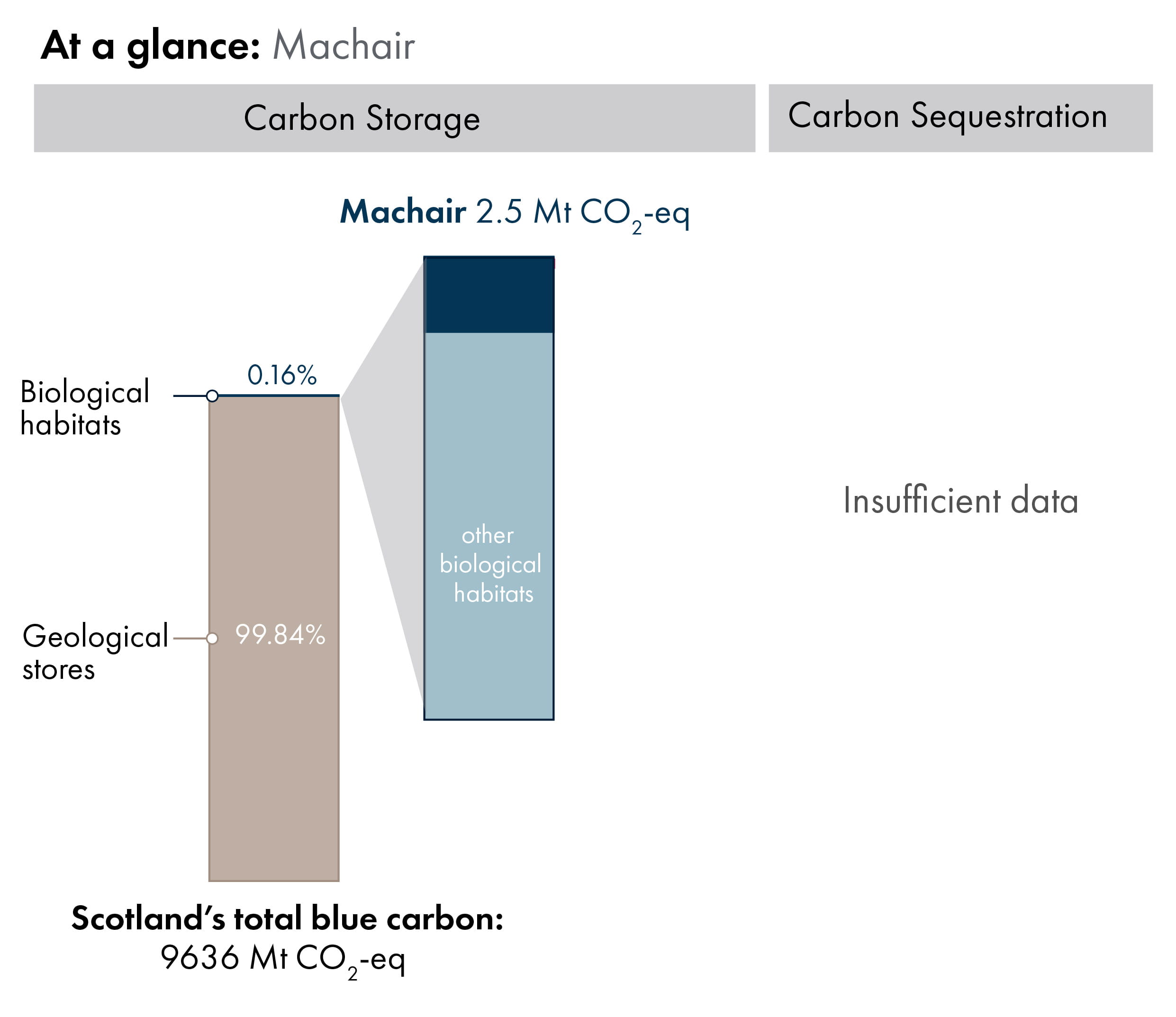
Distribution
Machair is a form of low-lying dune grassland found in shell-rich sands and is unique to the north-western coasts of Scotland and Ireland2. Machair is a highly dynamic habitat and varies in response to climate variations and changing land-use. Scotland has an estimated 200 km2 of machair, mainly in South Uist (a designated Special Area of Conservation3).
Carbon Storage and Sequestration
Scotland's machair environments store approximately 2.50 Mt CO2-eq1 based on machair samples to 0.15 m depth. There are no estimates of carbon sequestration rates across the total area of Scotland's machair. However, work is ongoing by NatureScot to produce better estimates of machair carbon sequestration.
Wider importance of Machair
Machair supports high plant and animal diversity, most notably flowers and birds. Machair contains many rare flower species such as lesser-butterfly orchid, Hebridean spotted orchid and marsh orchid. Machair is an important breeding ground for birds such as lapwing, redshank, snipe and dunlin in wetter areas and oystercatcher and ringed plover on cultivated areas.

Seagrasses
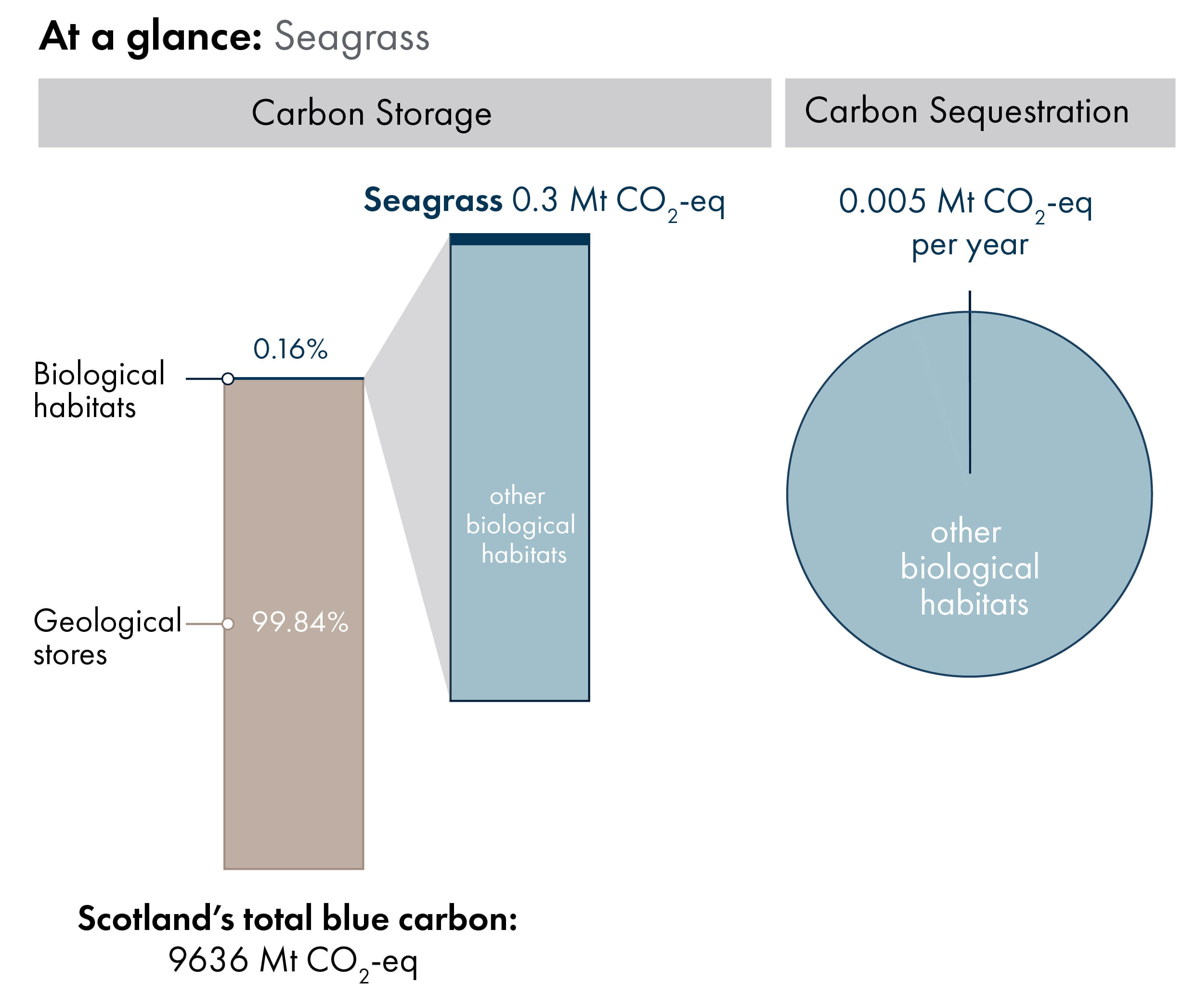
Distribution
Seagrasses (also known as eelgrasses) are flowering plants that form dense meadows or beds under the sea. Seagrasses can also occupy the intertidal zone (the area of land covered at high tide and uncovered at low tide). Recent estimates predict that Scotland's seagrass area is 21.64 km2, 95% of which is found in the Scottish Highlands3. This area represents a 58% reduction in seagrass coverage since 19363 driven by changes in land-use.
Carbon Storage and Sequestration
Scottish seagrass carbon storage and sequestration remains an ongoing area of research. The majority of carbon in seagrass ecosystems is stored within the underlying sediment rather than in the living seagrasses5. Scotland's seagrasses store an estimated 0.3 Mt CO2-eq1.
Based on global seagrass sequestration rates, Scottish seagrasses sequester approximately 0.005 Mt CO2 -eq per year2. This estimate is uncertain as seagrass sequestration rates depend on species, and have not been directly measured in Scottish seagrasses.
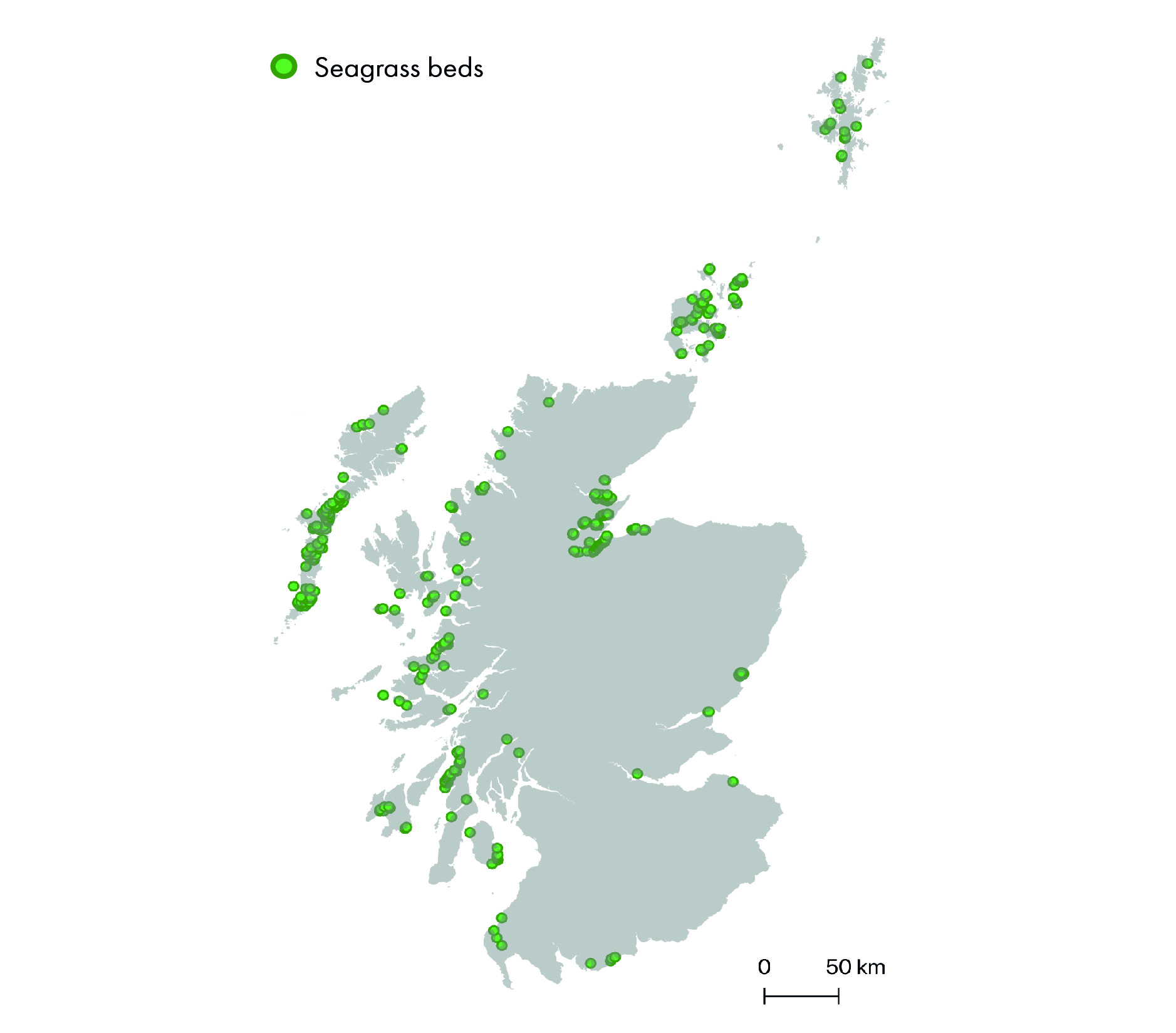
Wider importance of seagrass
Seagrass meadows provide habitats, nursery areas, food and shelter for a diverse range of species, such as the pipefish (a relative of the seahorse) and commercial fish like cod, plaice, pollock, and oysters8. Seagrass roots also stabilise the underlying sediment and absorb wave and current energy, thereby reducing coastal erosion and playing a role in climate change resilience9.
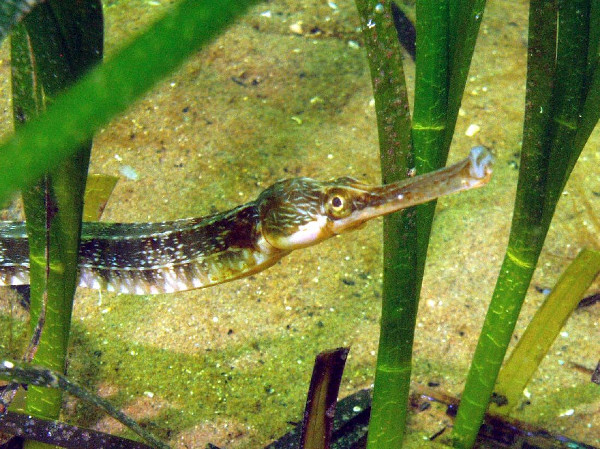
Biogenic reefs
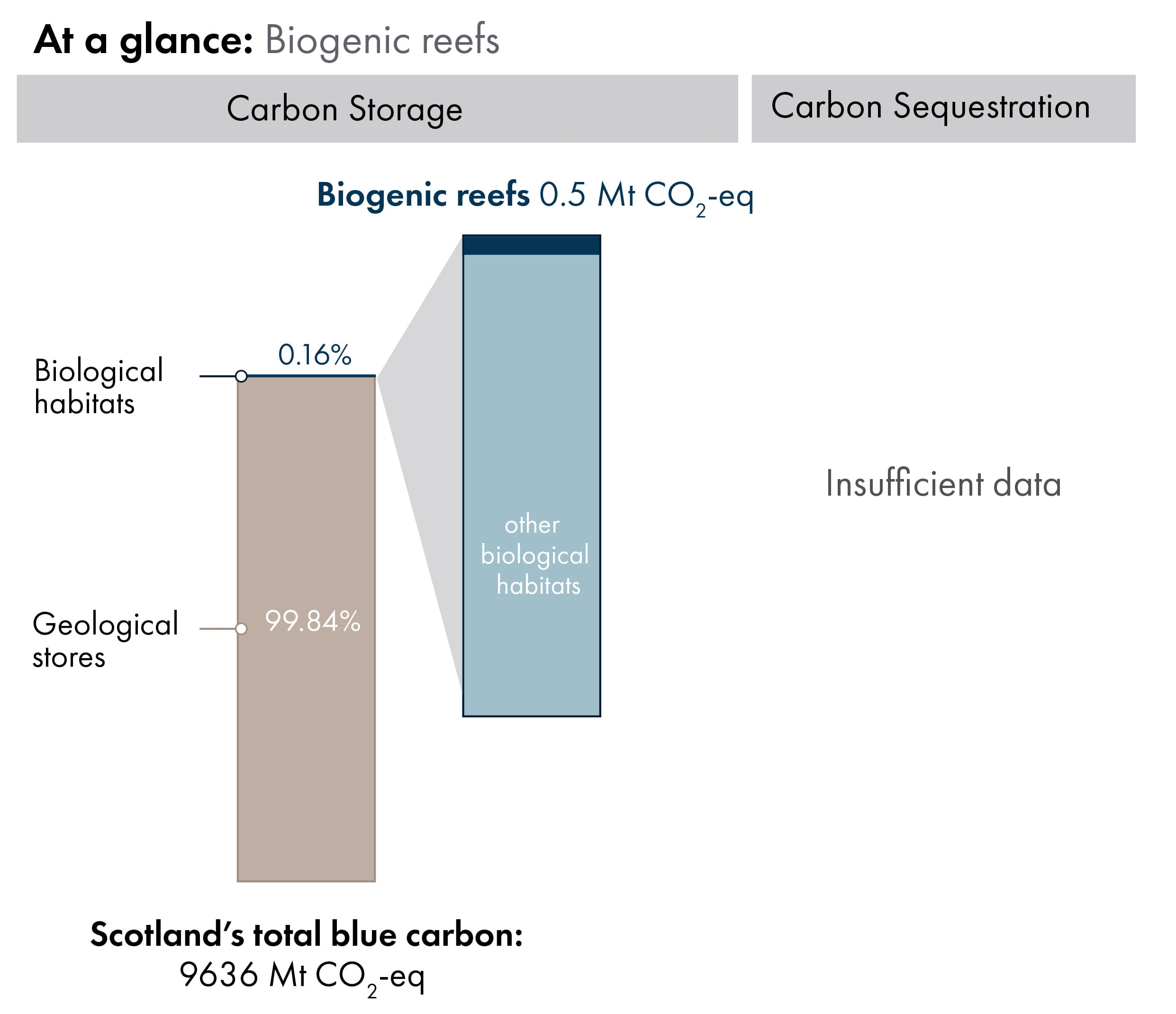
Biogenic reefs are solid structures raised above the sea bed formed by accumulations of organisms that build dense inorganic carbon (calcium carbonate) structures, which acts as the predominant carbon store. The following marine habitats in Scottish waters are considered biogenic reefs:
Maerl and Maerl beds (See Maerl beds)
Cold-water coral reefs
Tubeworm reefs (also known as serlupid reefs or aggregations)
Flame shell beds
Horse mussel beds
Blue mussel beds
Brittlestar beds
Native oyster beds
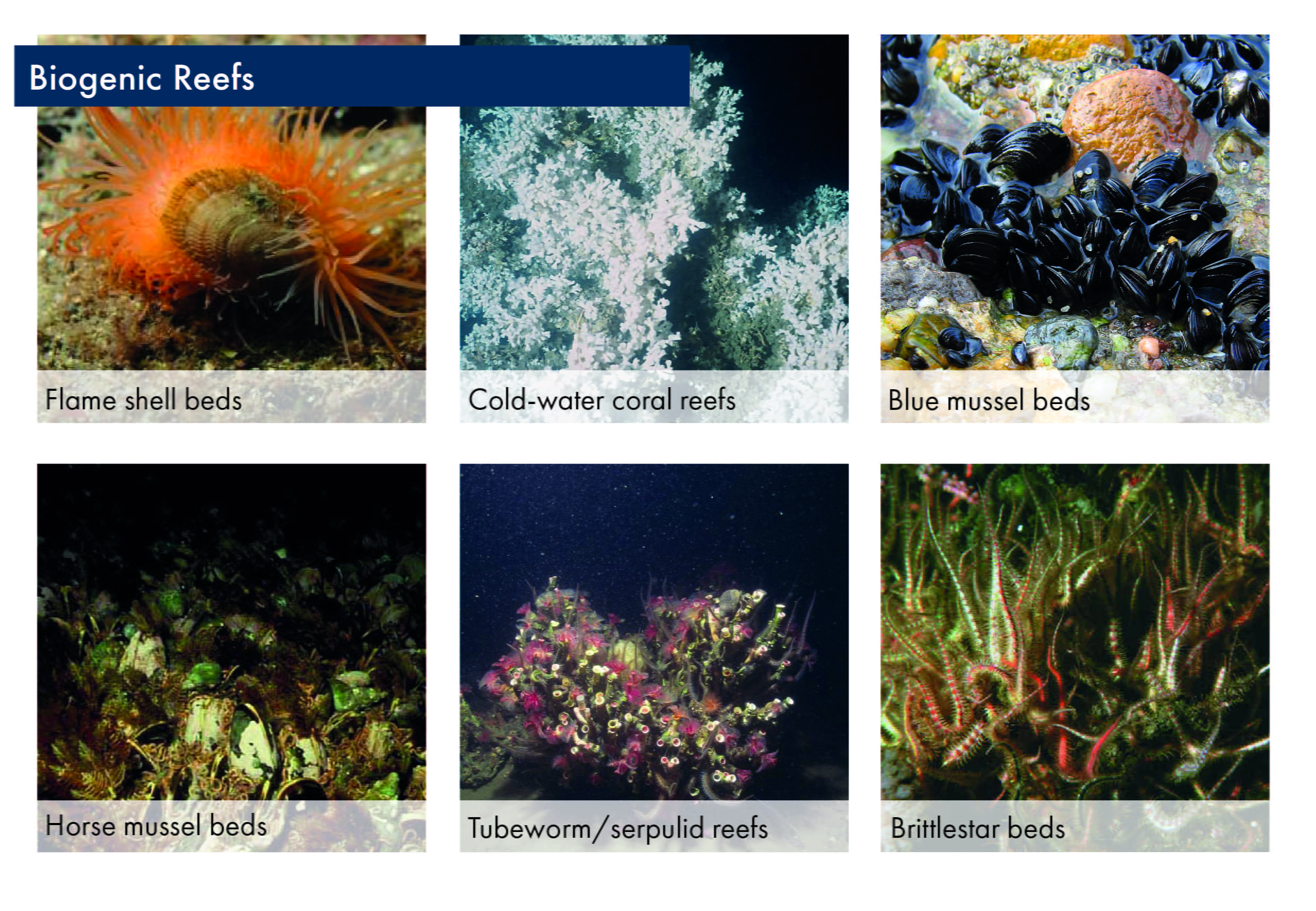
Distribution
Biogenic reefs form at a range of depths from the shallow waters to the deep sea (up to 1500m). The total extent of biogenic reefs in Scotland's seas remains uncertain, as there has yet to be a comprehensive assessment of their distribution. This is especially true in Scotland's deep sea (100 - 1500 m). Reefs can also form in lochs. For instance, tubeworm reefs cover 1 km2 in Loch Creran2. Based on available records, biogenic reefs (excluding maerl beds considered later in this briefing) cover an estimated 20.5 km2 in Scottish waters. However total biogenic reef area is highly uncertain and remains an ongoing research area1.
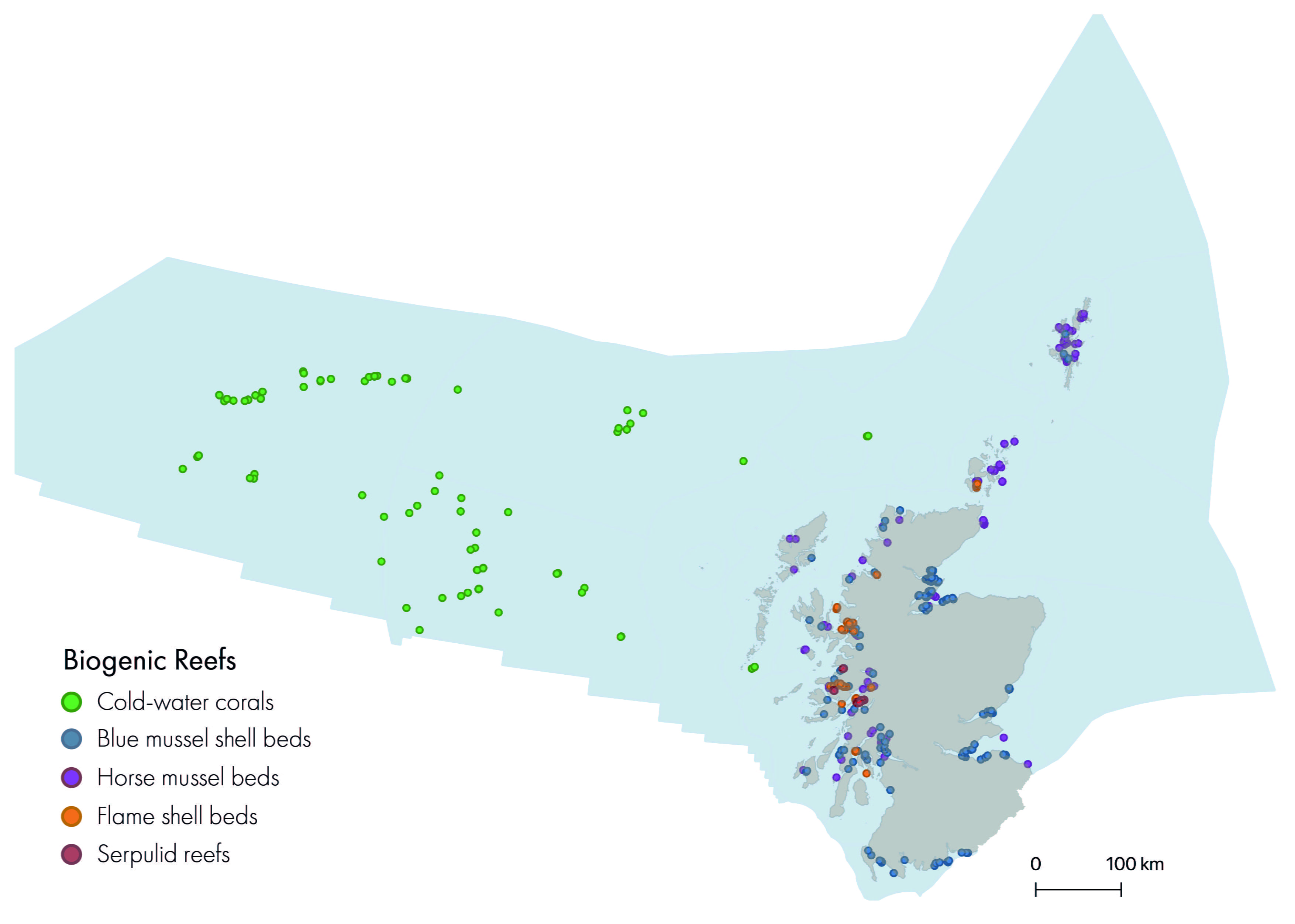
Carbon Storage and Sequestration
Biogenic reefs (excluding Maerl beds) store an approximate 0.5 Mt CO2 -eq1. However, this value remains uncertain as the true spatial extent of biogenic reefs is not known. There are little area and carbon storage data of blue mussel beds, the native oyster, and brittlestar beds. Cold-water corals alone are estimated to constitute 86% of the estimated carbon storage of biogenic reefs. The majority of this carbon storage is found in the Darwin Mounds, a Special Area of Conservation, situated off Scotland's north-west coast.
There is currently no estimate of the total carbon sequestered annually by biogenic reefs across Scotland's seas (this does not include Maerl beds). This is primarily due to the uncertainty of biogenic reef spatial extent. However, estimates of biogenic reef sequestration rates per unit area do exist and range between 129-1541 g CO2-eq per m2 per year16. These values indicate that on a per unit basis biogenic reefs have some of the highest carbon sequestration rates of all blue carbon and terrestrial habitats.
Wider importance of biogenic reefs
Biogenic reefs support high levels of biodiversity and maintain the health of the marine environment. Biogenic reefs are often local biodiversity hotspots, providing nursery and breeding habitats for fish. For instance, horse mussel beds are important nursery habitats for the commercially important whiting, poor cod and queen scallops7. Biogenic reefs formed by bivalve species (molluscs with a hinged shell) such as oysters can improve water quality, remove suspended particulate matter and increase water clarity 8. This in turn increases the abundance of aquatic vegetation and reduces the likelihood of toxic algal blooms9. Besides supporting biodiversity, biogenic reefs contribute to shoreline stability by reducing wave and tidal energies - ultimately leading to lower coastal erosion10.
Maerl beds
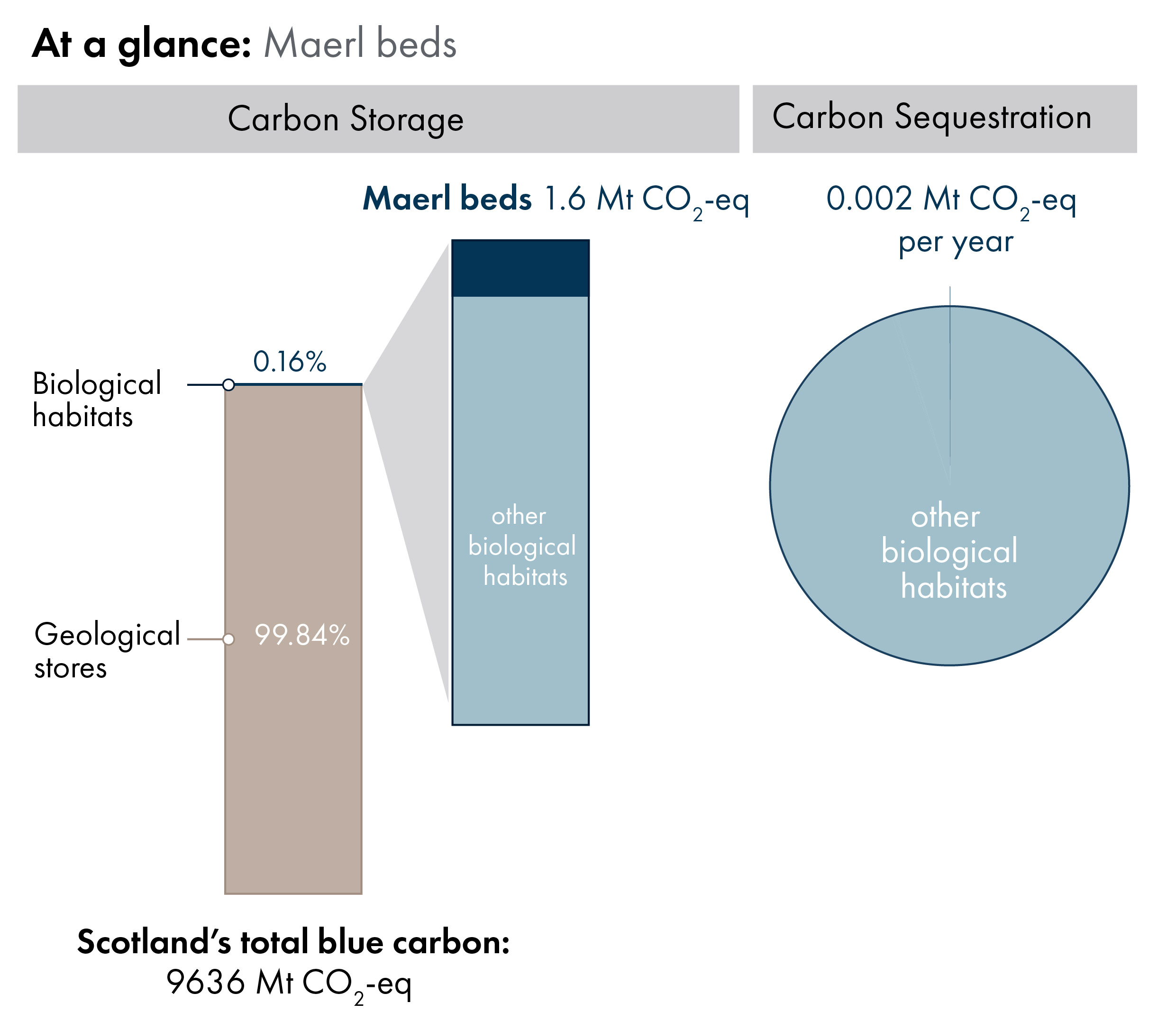
Maerl is the collective name for pink-purple algae that produce hard, inorganic carbon exterior skeletons. Maerl form extensive 3D underwater deposits known as maerl beds, formed of living and dead maerl. Similarly to phytoplankton, maerl store carbon in their soft biomass (organic carbon) and in their external skeletons (inorganic carbon). Living maerl is extremely slow-growing (around 0.25 mm per year)2 and can live for up to 100 years6. Scottish maerl beds can be thousands of years old - a maerl bed in the Sound of Iona is estimated to be around 4,000 years old7.
Distribution
Maerl and maerl beds occur in abundance along Scotland's west coast, Orkney and Shetland, but are nearly absent from the east coast8. Based on the 353 records of maerl beds in Scotland, maerl and maerl beds cover an estimated 7.06 km2. This value is potentially an underestimate if some maerl beds remain undiscovered, which is likely.
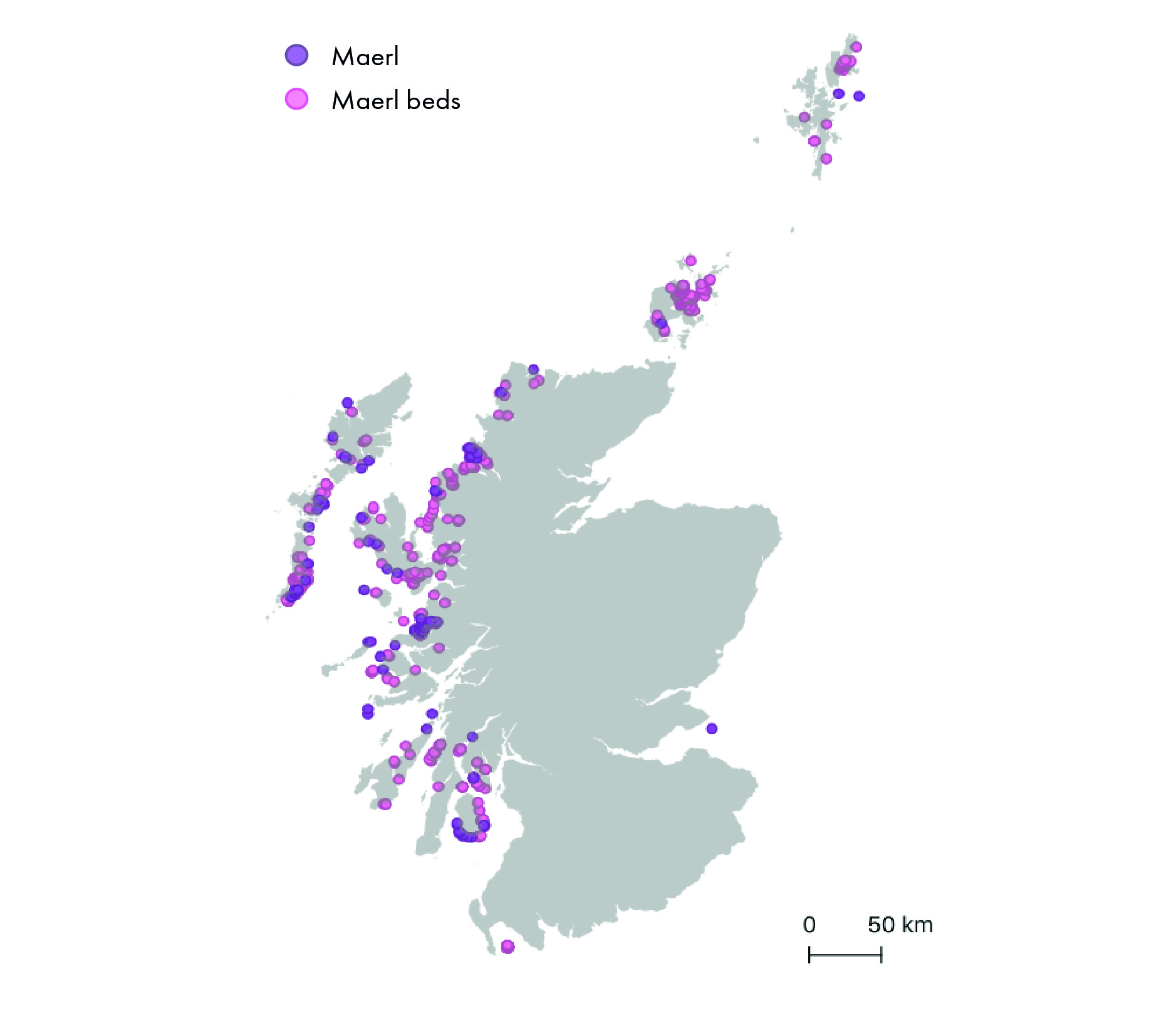
Carbon Storage and Sequestration
Maerl beds store an estimated 1.6 Mt CO2-eq12, predominately as inorganic carbon in live and dead maerl skeletal material. Maerl bed carbon storage estimates depend on bed thickness, for which very little extensive data exist. Current estimates use an average bed thickness of 60 cm2, but beds can be thicker: beds as thick as 125 cm are documented in the Wyre Sound1213. In addition, a large volume of dead maerl deposits are washed up as beach sediments and are therefore not included in the calculation of maerl carbon stores. These uncertainties indicate that maerl and maerl bed carbon storage is potentially underestimated.
Maerl beds sequester an estimated 0.002 Mt CO2-eq per year21. Carbon sequestration rates depend on the percentage of living maerl within maerl beds, for which no extensive data currently exist. Current estimates use a value of 50% living maerl in carbon sequestration rate calculations. However, observations show that living maerl in the bed surface layer can vary between 5%-100%2indicating that this is a source of uncertainty in sequestration rate calculations.
Wider importance of maerl beds
Maerl beds are ideal conditions for developing diverse communities of plants and animals on, between, and under maerl pieces. Other seaweeds, sea firs (hydroids), sea urchins, brittle stars, starfish, sea anemones and scallops may colonise the surface of the bed. Small crabs, queen scallops, and juvenile fish can hide inside the bed while burrowing crabs, worms, and bivalves live in the sediment below. For example, in the Firth of Clyde, greater numbers of cod were found in shallow sheltered areas where the seabed was composed of maerl-containing gravels and pebbles17. Maerl beds are also a nursery habitat for commercially important shellfish, such as scallops18.
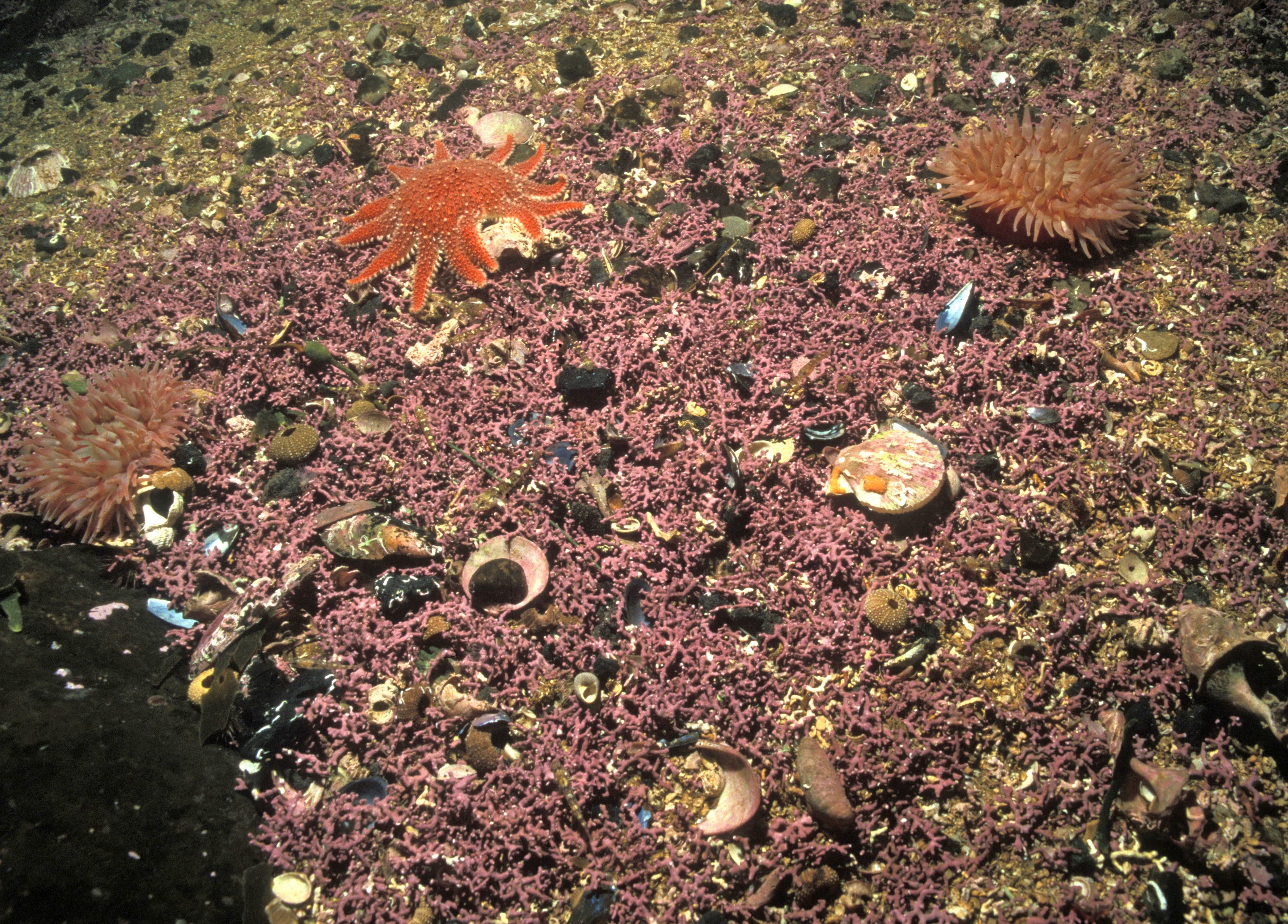
Phytoplankton
![Pie chart showing, out of all biological habitats, the proportion which is sequestered annually by phytoplankton. This is alongside statement which reads 'rapid turnover of phytoplankton biomass precludes accurate assessment [of carbon storage]'.](/~/media/digitalpublications/spice/1590/27213/AAG_phytoplankton.jpg)
Distribution
Phytoplankton are microscopic, single-celled marine algae (seaweed) that live in the sea surface. Phytoplankton are ubiquitous in Scotland's seas and therefore cover the total extent of Scotland's seas (469, 960 km2).
Carbon Storage and Sequestration
Phytoplankton sequester both organic and inorganic carbon. Phytoplankton rapidly degrade in surface waters and therefore it is difficult to estimate the carbon stored by phytoplankton biomass at any given time. As such, there are currently no accurate estimates of living phytoplankton carbon storage.
Following death, around 90% of phytoplankton biomass degrades, releasing carbon back into the seawater and atmosphere2. The remaining 10% of phytoplankton biomass escapes degradation and is buried in seafloor sediments, thereby contributing to long-term carbon storage. Phytoplankton biomass entering long-term (sediment) carbon storage sequesters an estimated 14.3 Mt CO2-eq per year12. The key uncertainty in this estimate is the proportion of phytoplankton biomass which escapes degradation and is buried in seafloor sediments. This remains an ongoing research area.
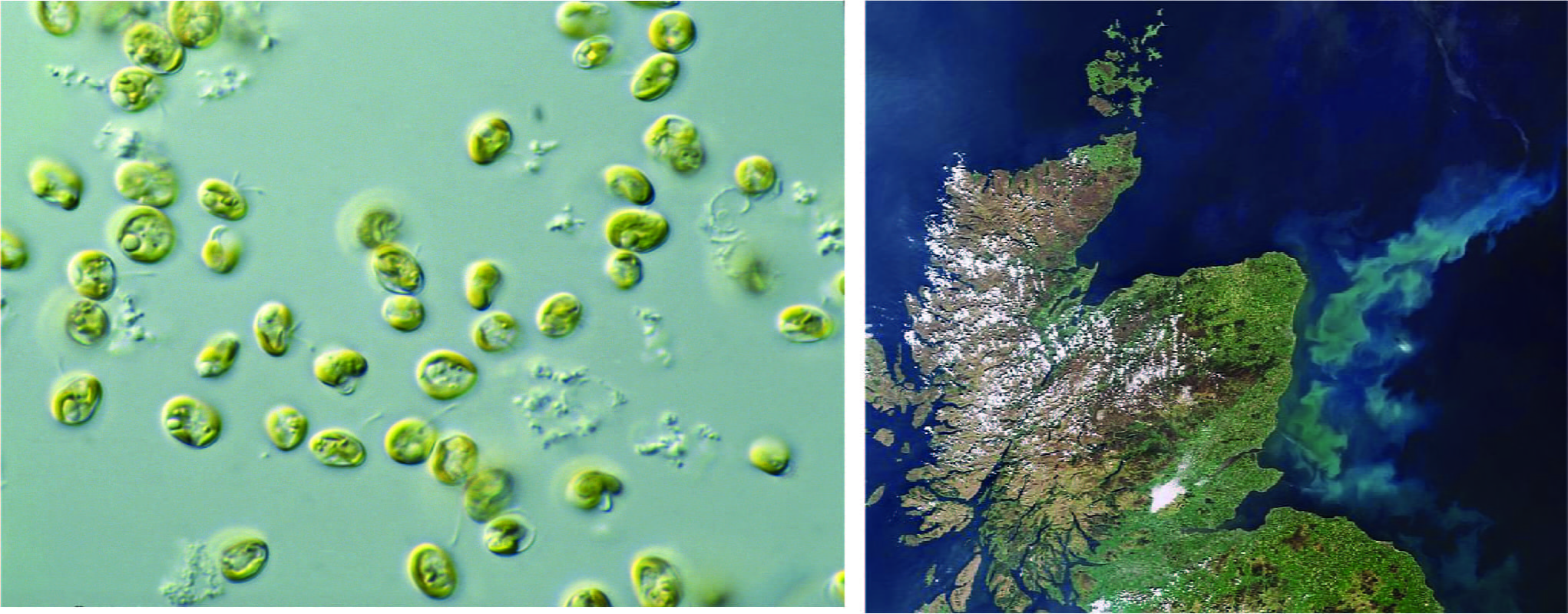
Kelp
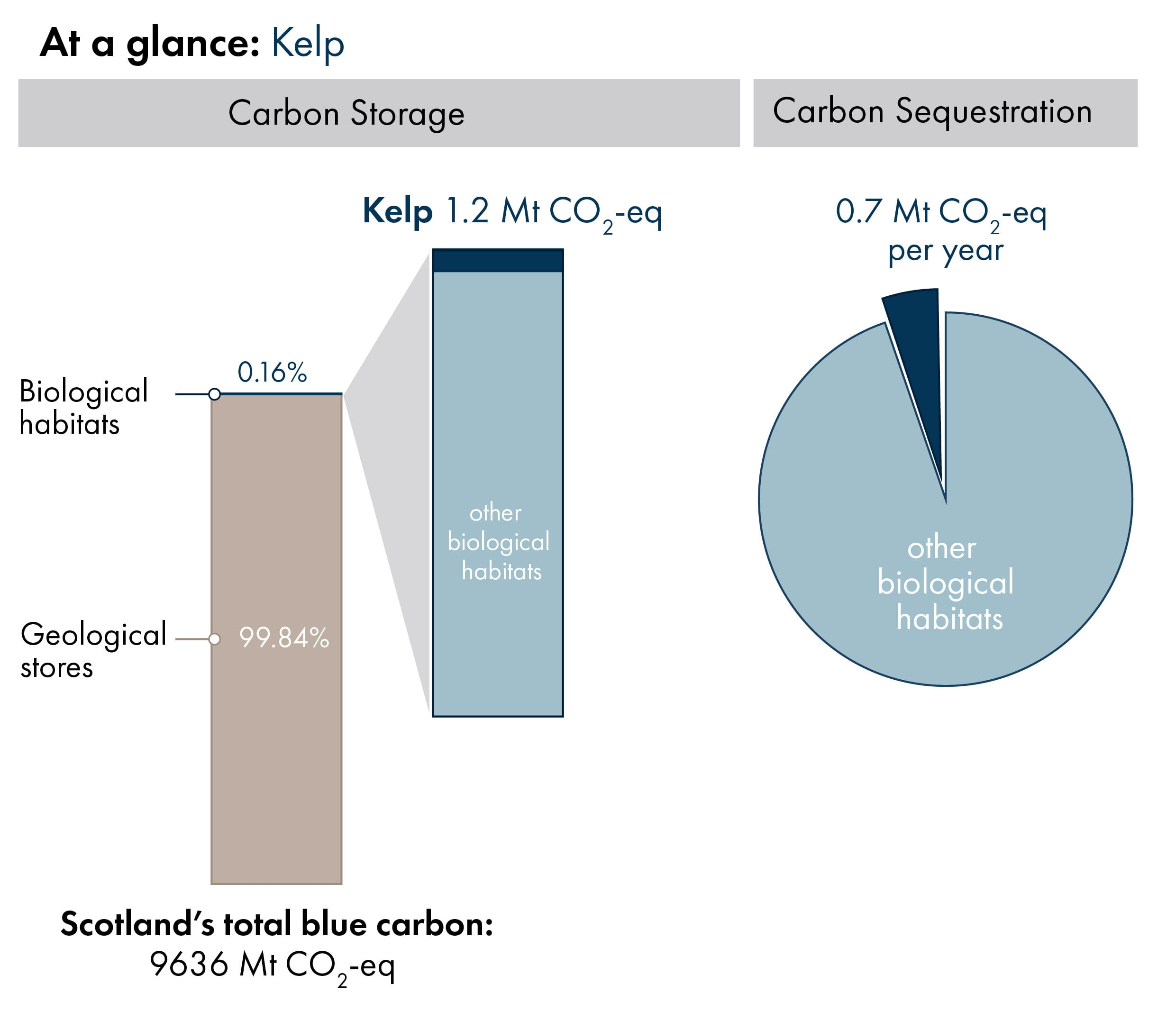
Distribution
Kelp is the generic name for several species of large, brown (macro)algal seaweed. Kelp grows in underwater communities known as kelp forests or beds. Kelp also accumulates near to or just below the shore on sediments (known as sublittoral sediments). Kelp beds are widely recorded around the coasts of Scotland's mainland and islands, covering an estimated 3747 km2 of Scotland's coast1.
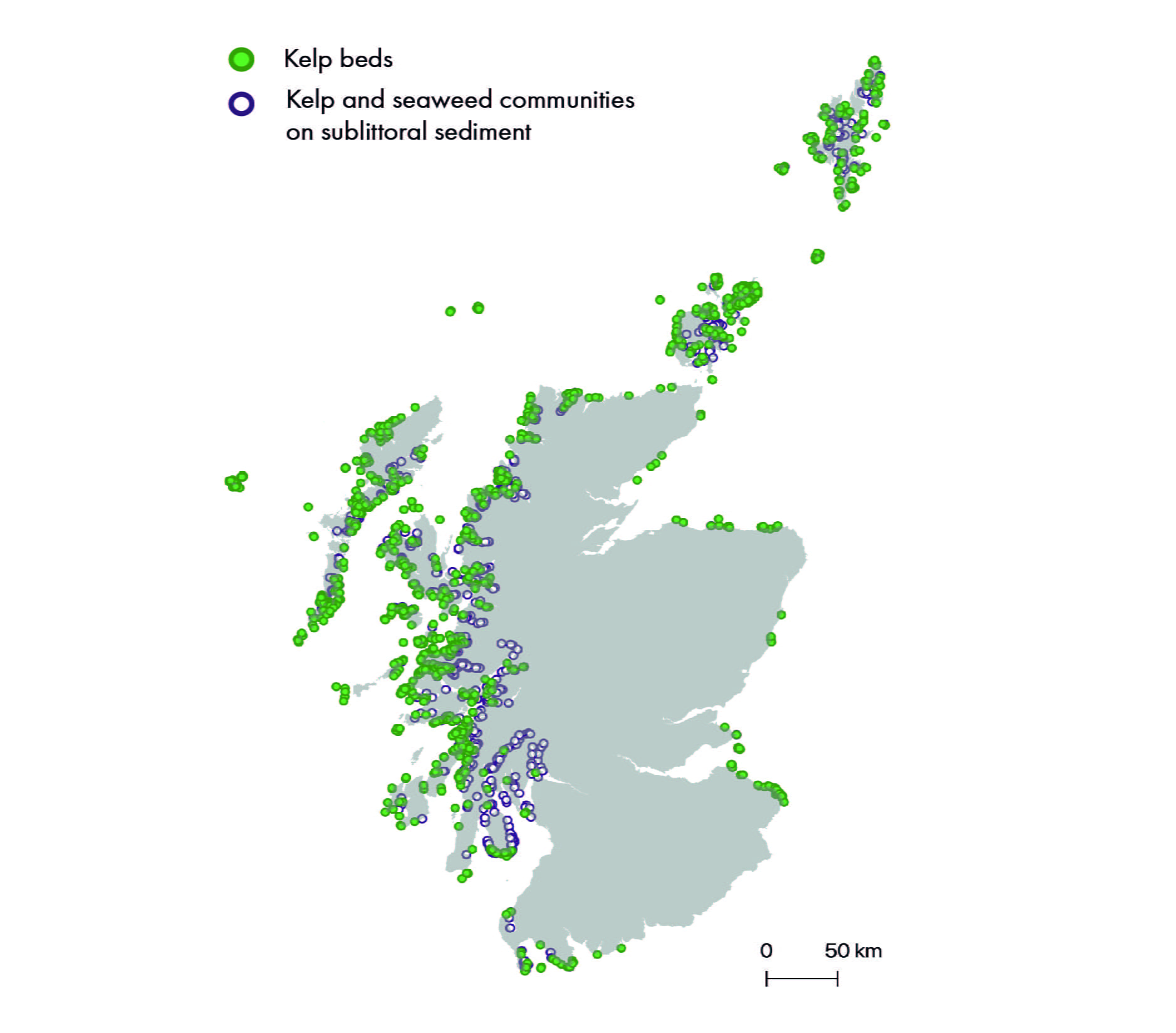
Carbon Storage and Sequestration
Carbon is only stored in the living kelp and not in the underlying beds and sediments. Living kelp in Scotland stores an estimated 1.2 Mt CO2-eq2. This value is uncertain as kelp productivity depends on algal species, habitat, depth, light and nutrient levels345. Research is ongoing to improve estimates of carbon stored in Scotland's living kelp.
Following death, the carbon in kelp biomass can enter the wider marine microbial food web. As with phytoplankton, the majority of kelp-derived carbon degrades, releasing the stored carbon. A much smaller proportion of kelp escapes degradation and is buried in seafloor sediments, contributing to long-term carbon sequestration67. Globally, an estimated 11.4% of kelp-derived carbon enters long-term storage, which results in a kelp sequestration rate of 0.7 Mt CO2-eq per year26.
Wider importance of kelp
Kelp carbon storage and sequestration is only one aspect of their importance. The sheltered areas beneath kelp are important habitats for marine biodiversity. Kelp beds support a range of species, including sea anemones, sea firs, sea squirts, sponges and a variety of other seaweeds. Within the UK alone, more than 1800 species of flora and fauna have been recorded from kelp-dominated habitats4. Kelp forests also provide nursery grounds for commercial fish and shellfish and can support species at higher trophic levels (further up the food chain), including cetaceans, seals, otters and birds11. Kelp-based ingredients are widely employed in agricultural, chemical, cosmetic and food applications. Kelp harvesting is the subject of another SPICe briefing.
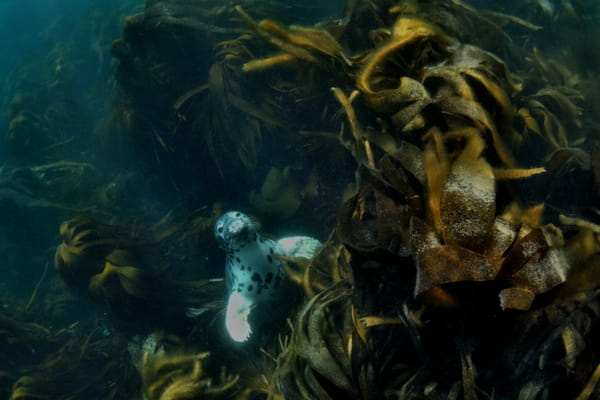
Geological Blue Carbon
Marine sediments accumulating on the ocean floor store large quantities of carbon over long periods, typically between thousands to hundreds of thousands of years. Marine sediments do not directly sequester carbon but receive organic and inorganic carbon from biological blue carbon habitats or terrestrial environments.
While terrestrial carbon stores, such as forests, are well-mapped and have robust protocols for carbon stock assessments and accounting1, relatively little of the seabed has been mapped2. Ongoing research within the Scottish Blue Carbon Forum aims to quantify carbon sequestration and storage in Scottish seafloor and sea loch sediments3456.
Seafloor sediments
.jpg)
Carbon storage
The top 10 cm of seafloor sediments covering Scotland's seas store an estimated 9586 Mt CO2-eq1. The majority of the carbon in seafloor sediments (85%) is inorganic carbon derived from dead shell material. The remaining 15% is organic carbon.
The density of carbon in Scotland's seafloor sediments (measured in kg carbon per cubic meter) is highly variable. The greatest carbon densities surround Scotland's Northern Isles (inorganic carbon) and the inshore marine environment off Scotland's western coast (organic carbon)1. The total carbon stored deeper than 10cm is uncertain, as there are limited data available on sediment thickness and carbon density below surface sediments. This remains an ongoing research area within the Scottish Blue Carbon Research Forum. The carbon storage estimate of 9586 Mt CO2-eq is therefore potentially only a fraction of full-thickness sedimentary carbon stocks.
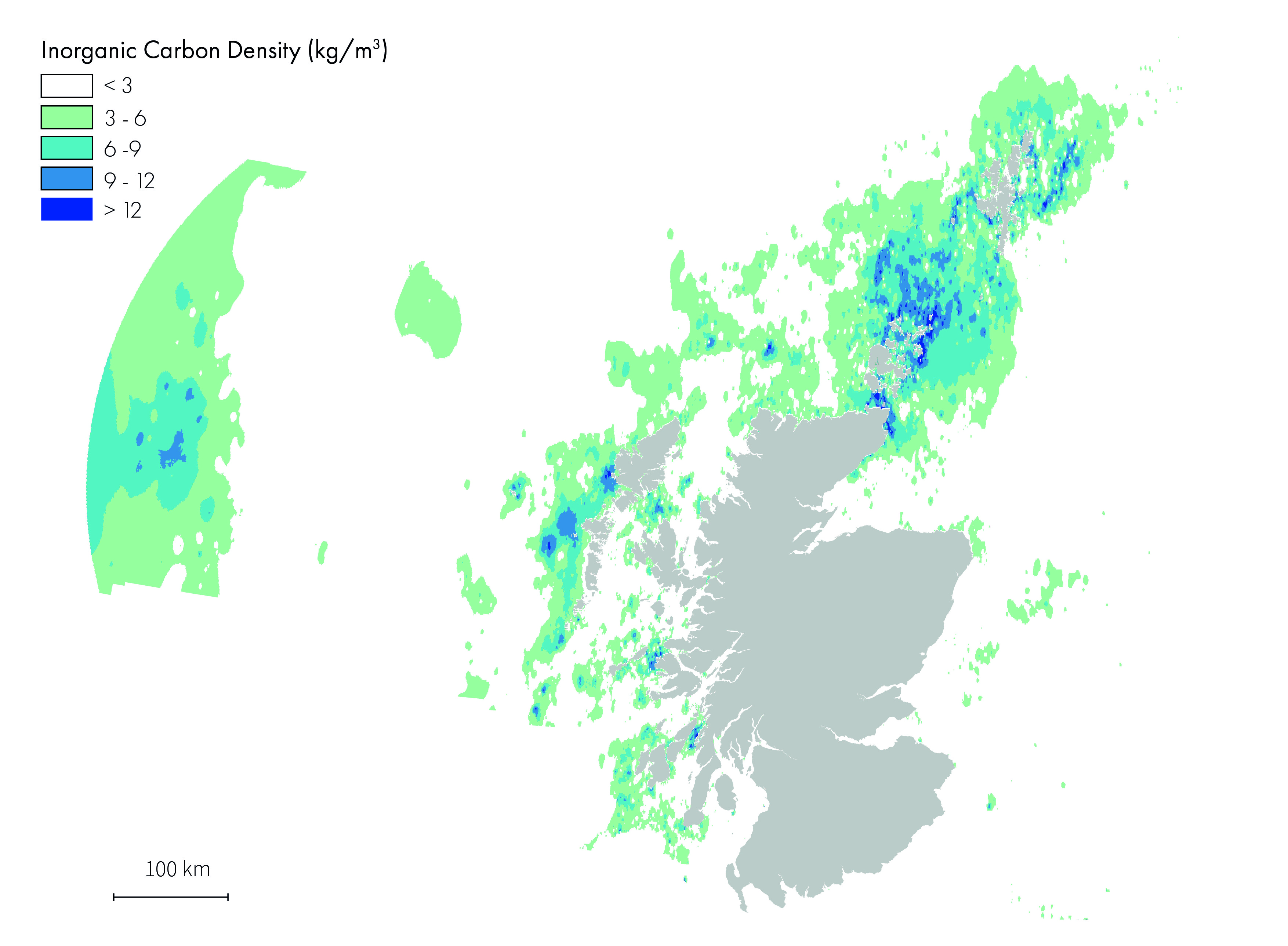
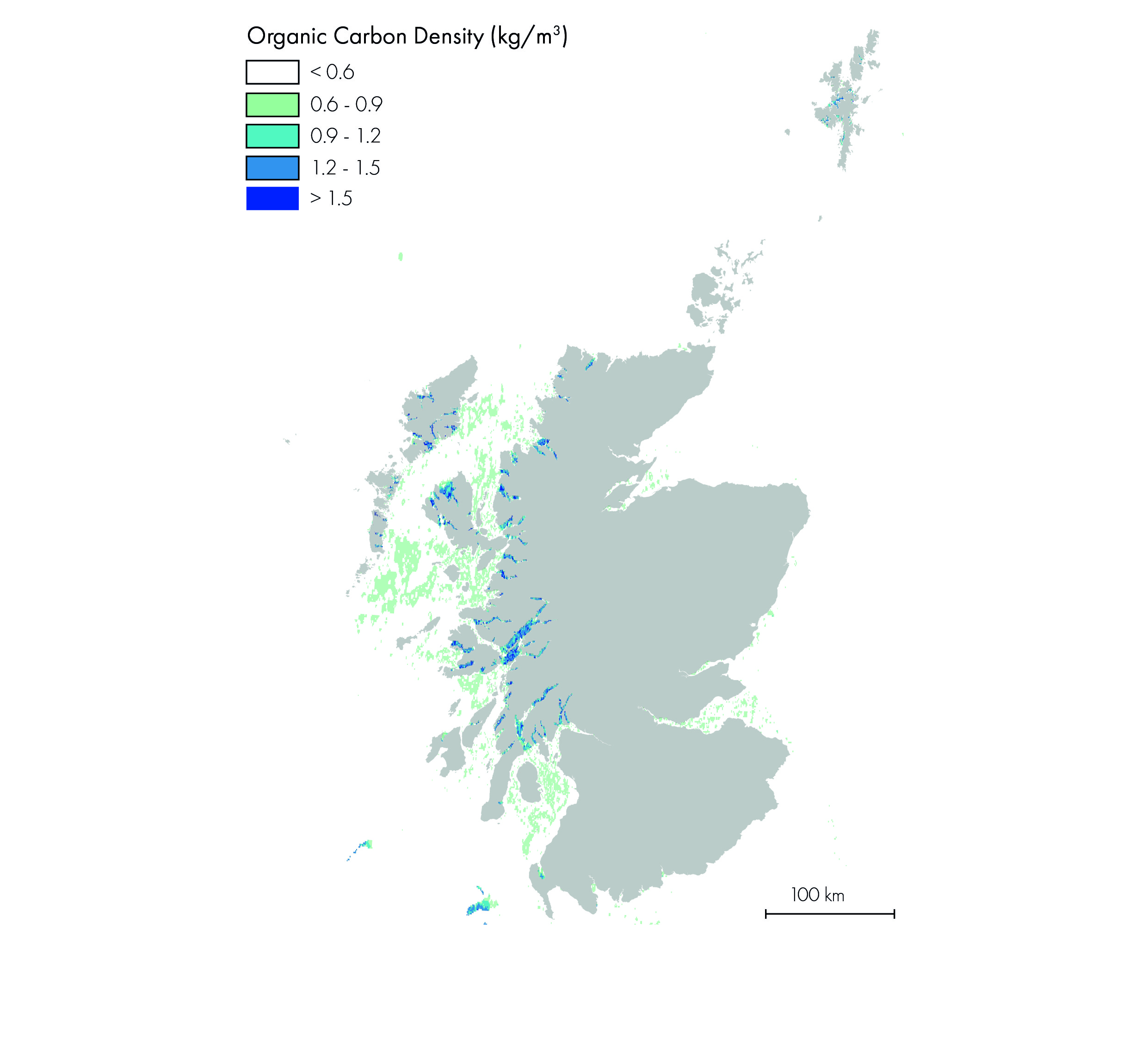
Carbon sequestration
Seafloor sediments sequester an estimated 28.2 CO2-eq per year1. There is a degree of uncertainty in this value as it is based on sequestration rates in Northern European seas (e.g. Norway) and isolated measurements from single studies1. The majority of seafloor carbon sequestration is from organic carbon (26.4 CO2-eq per year), with a lower contribution from inorganic carbon (1.8 CO2-eq per year)1. Most of the organic carbon sequestration into seafloor sediments is from phytoplankton (68.4%) biomass, with the remaining carbon derived from kelp1. However, the precise contribution of these sources to organic carbon sequestration in sediments remains a key source of uncertainty and is an area of ongoing research.
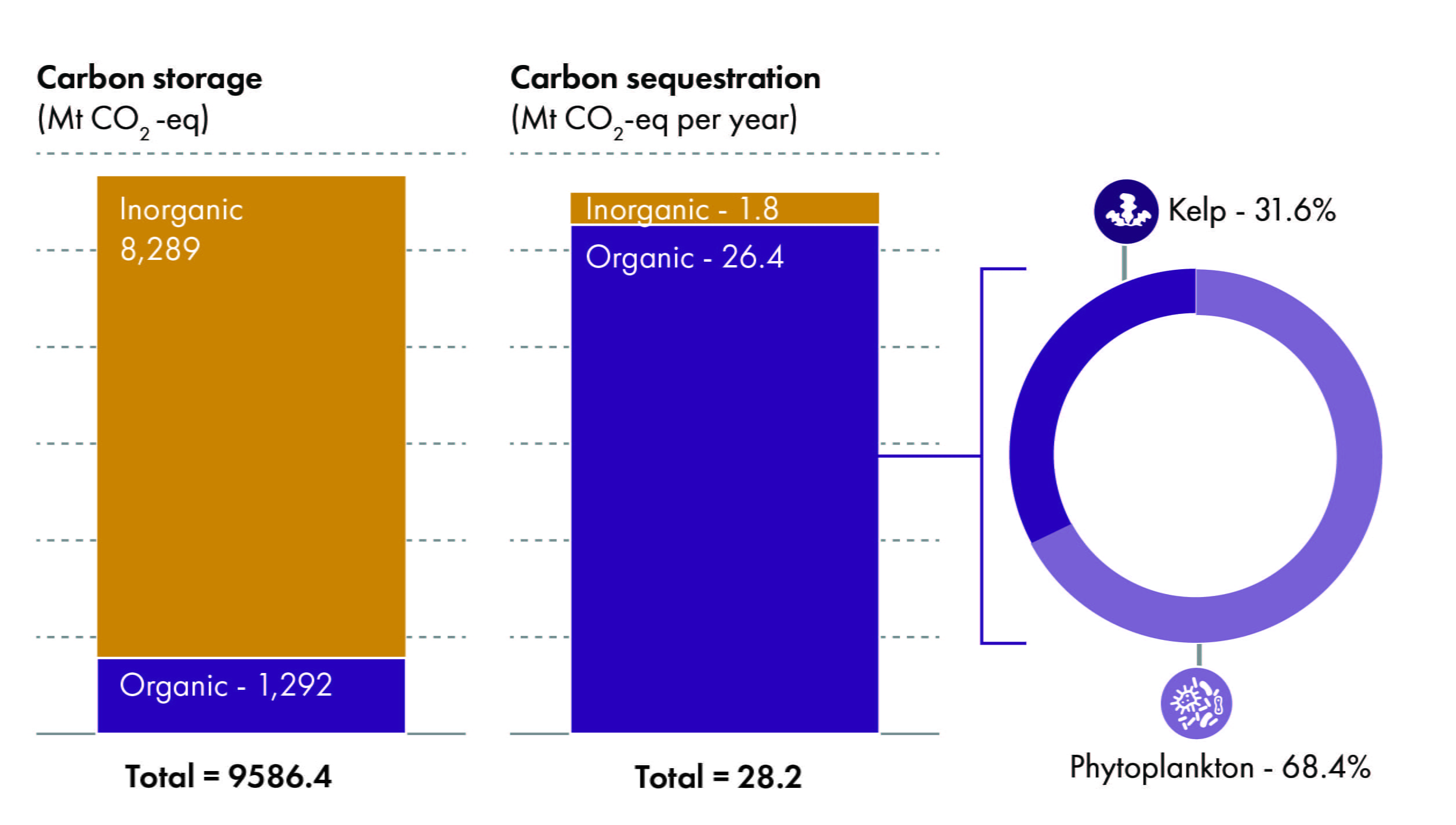
Sea loch sediments
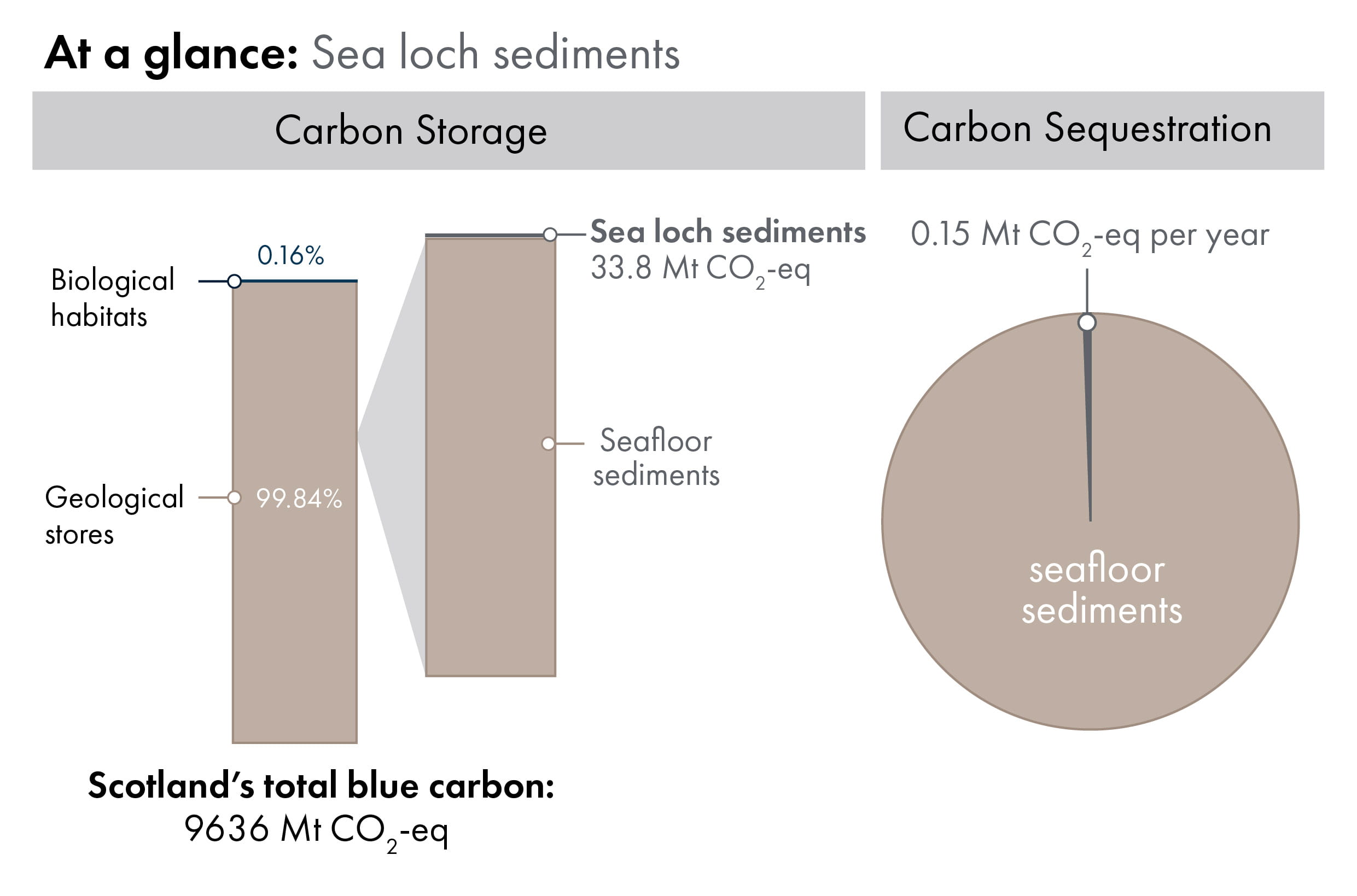
Sea lochs or fjords (herein referred to as sea lochs) are sea inlets that extend inland. Scotland's sea lochs cover 2,608 km21 primarily along Scotland's western coast and islands.
Carbon Storage and Sequestration
Sea lochs are long-term stores of both inorganic and organic carbon, storing carbon for thousands to tens of thousands of years. Sea lochs store an estimated 33.8 Mt CO2-eq1. As with seafloor sediments, sea loch carbon density varies over their area, depending mainly on sediment type6.
Scotland's sea lochs have greater organic carbon densities than Scotland's seafloor sediments78 and as such sea lochs are considered organic carbon 'hotspots'1. The proximity of sea lochs to the terrestrial environment allows them to capture organic material from forest and peatland ecosystems as it is washed out to sea7. Up to 40% of organic carbon in sea lochs originates from terrestrial ecosystems7. Sea lochs are prone to periods of low oxygen, which further promotes organic carbon preservation in sediments12. The high proportion of organic carbon in sea loch sediments means that they are sensitive to carbon release through physical disturbances. Sea loch sediments sequester an approximate 0.15 Mt CO2-eq per year7.

Comparison with Terrestrial Carbon Stores
Kelp and phytoplankton sequestration rates
The following comparison splits blue carbon storage and sequestration into geological stores and biological species and habitats. However, biological carbon sequestration does not consider kelp and phytoplankton as the rates presented here reflect dead kelp/phytoplankton incorporation into seafloor sediments. Therefore kelp and phytoplankton sequestration is encompassed under geological carbon sequestration rates (See kelp and phytoplankton sections for more details). Living kelp is, however, considered a biological carbon store.
Carbon Stores
Geological sediments (seafloor and sea loch sediments) store the majority (99.84%) of Scotland's blue carbon, totalling 9,620.2 Mt CO2-eq1. This exceeds estimates of carbon storage in Scottish peatlands 23(5,945 Mt CO2-eq), forestry (2,050 Mt CO2-eq in living trees and underlying soil)4 and non-peatland soils (1,550 Mt CO2-eq)26.
Annual Carbon Sequestration
Scotland's geological blue carbon stores (seafloor sediments and sea loch sediments) sequester an estimated 28.35 Mt CO2-eq per year7. Biological blue carbon habitats and species (e.g. seagrass, maerl beds,biogenic reefs, saltmarshes) sequester significantly less (0.06 Mt CO2-eq per year) primarily due to their much smaller area.
Current estimates predict that Scotland's forests sequester 9.6-11 Mt CO2-eq per year89. This value only considers living trees and is likely to be greater if forestry soil is included. Healthy peatlands can sequester large quantities of carbon, but currently around 80% of Scottish peatland are in a degraded state10. As such, Scottish peatlands are a carbon source; it is estimated that peatlands emit 6-10 Mt CO2-eq per year11. New preliminary estimates published in February 2021 suggest that Scotland's peatlands emitted 7.7 Mt CO2-eq in 201812, with a final estimate expected to be published by the Scottish Government in June 2021.
For comparison, Scotland's annual greenhouse gas (GHG) emissions in 2018 were 41.6 Mt CO2-eq per year13. It is important to note that Scotland's GHG emissions and peatland emissions also include other forms of carbon, such as methane (CH4).
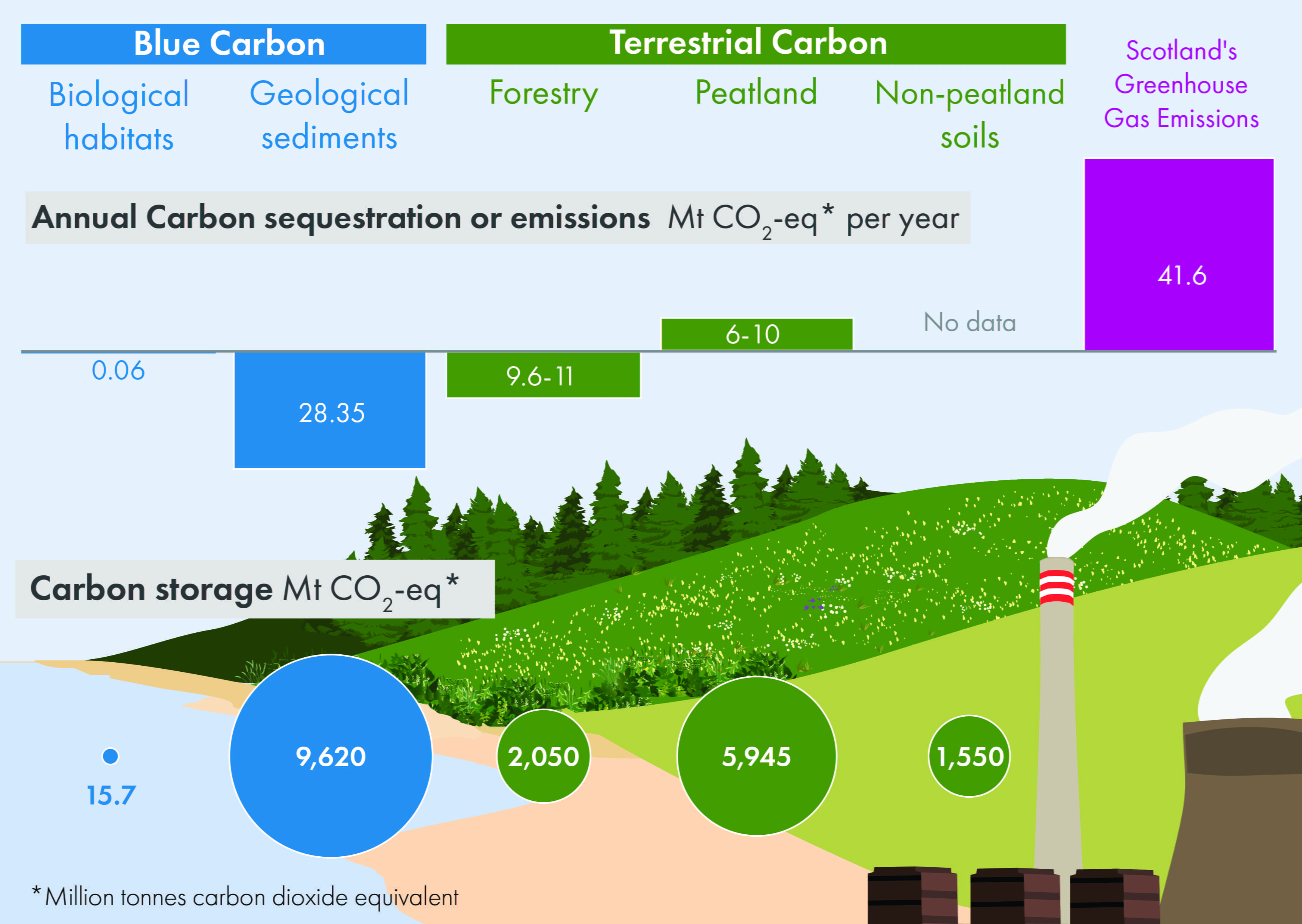
Carbon Sequestration on a per area basis
Annual carbon sequestration rates (Mt CO2-eq per year) depend on the blue carbon habitat area, which remains uncertain for some habitats in Scotland's seas (e.g. biogenic reefs). It is useful to also compare annual carbon sequestration per square metre (measured in grams CO2 per m2 per year), which does not require an estimate of total habitat area. Annual carbon sequestration per unit area is also a useful indicator of how carbon sequestration density varies between terrestrial and marine habitats. In other words, this metric can identify which environments are the most efficient at sequestering carbon on a per unit area basis.
Uncertainty in carbon sequestration rates per unit area
It is important to note carbon sequestration per unit area depends on biological and environmental factors such as biological species and ecological health. Therefore, the values stated herein are subject to some degree of uncertainty and are the focus of ongoing research.
Biological blue carbon sequestration rates are highly variable, ranging between 128.1 (Machair) to 1541.4 g CO2-eq per m2 per year (Tubeworm reefs). Despite displaying some of the highest carbon sequestration rates on a per unit area basis, these habitats contribute minimally to Scotland's overall carbon sequestration due to their small spatial extent in Scotland's seas.
Of the geological carbon stores, sea lochs sequester 3.5 times more carbon (on a per unit area basis) compared with seafloor sediments (both inshore and offshore sediments). Seafloor sediments in inshore environments sequester a greater amount of carbon annually per square metre (159.3 g CO2-eq per m2 per year) compared to sediments in offshore environments (3.85 g CO2-eq per m2 per year).
| Carbon Store | Area | Carbon sequestration per unit area | Total carbon sequestration |
|---|---|---|---|
| km2 | g CO2-eq per m2 per year | Mt CO2-eq per year | |
| Geological Blue Carbon Stores | |||
| Seafloor sediments (offshore) | 434,7331 | 3.852 | 28.22 |
| Seafloor sediments (inshore) | 39,3251 | 159.32 | |
| Sea loch sediments | 2,6081 | 569.8 (organic carbon only)2 | 0.158 |
| Biological Blue Carbon Stores | |||
| Sand dunes | 4959 | 21710 | |
| Machair | 2009 | 1282 | |
| Saltmarshes | 77.0413 | 4409 | 0.059 |
| Seagrasses | 21.6416 | 50717 | 0.00518 |
| Biogenic Reefs - | |||
| Cold-water corals | 20.52 | 1292 | |
| Tubeworm reefs | 15412 | ||
| Flame shell beds | |||
| Horse mussel beds | 14722 | ||
| Brittlestar beds | 30023 | ||
| Native oyster beds | 18424 | ||
| Maerl beds | 7.062 | 271. 62 | 0.002272 |
Terrestrial Environments
Scottish Forestry estimates that healthy Scottish forestry (not including soil carbon sequestration) can sequester between 190 - 700 g CO2 per m2 per year29. Currently, 80% of Scottish peatlands are in a degraded state30. However, healthy, restored peatlands can sequester 48 - 280 g CO2 per m2 per year3132.
Taken together, these estimates indicate that numerous blue carbon habitats (in particular, biogenic reefs) annually sequester more carbon on a per unit basis, compared to terrestrial habitats. As such, blue carbon habitats are globally considered to be attractive nature-based solutions to climate change, but research is still ongoing in Scotland to determine their viability as a climate change mitigation strategy.
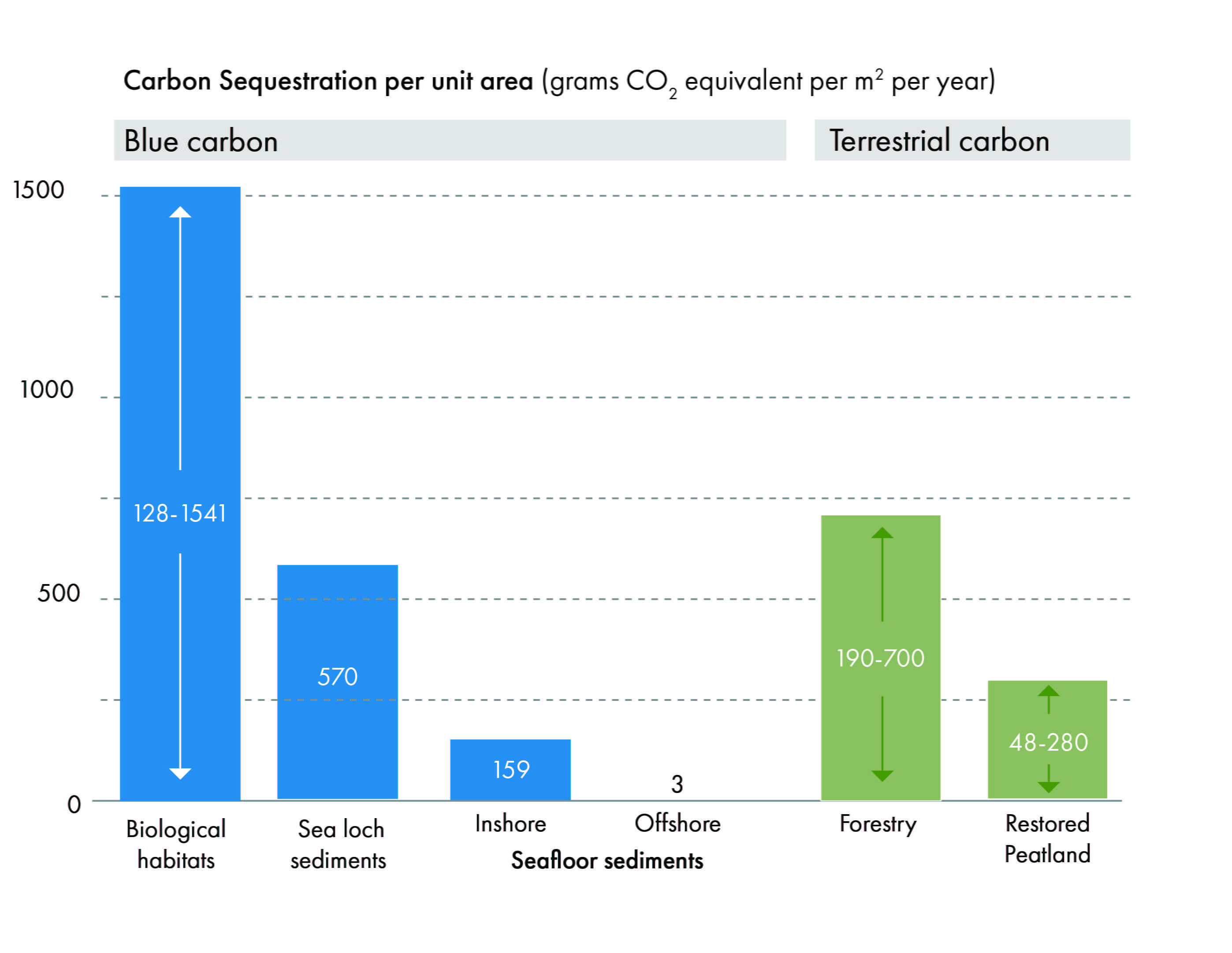
Blue Carbon Threats
Assessment of Scotland's Blue Carbon
National Marine Plan
The Marine (Scotland) Act 2010 and Marine and Coastal Access Act 2009 (collectively referred to as the Marine Acts) require Scottish Ministers to prepare and adopt a National Marine Plan (NMP), which must provide:
An assessment of the condition of the Scottish marine area or, as the case may be, Scottish marine region at the time of the plan's preparation
A summary of significant pressures and the impact of human activity on the area or region.
The most recent assessment is The Scotland Marine Assessment 2020, which provides the scientific basis to inform the 2021 review of the NMP. The Marine Assessment represents a cooperative effort between Marine Scotland, SEPA, NatureScot, Crown Estate Scotland and others.
Regional Marine Assessments
Regional Marine Assessments provide a more localised assessment of the marine environment to inform Marine Management Schemes (outlined in further detail under MPA management) and are a requirement of Section 5 of the Marine (Scotland) Act 2009. Examples include the Clyde Region Marine Assessment and the Shetland Islands Marine Region State of the Environment.
Other Assessment measures
Ongoing assessment of the health of (some) blue carbon habitats is additionally provided by the OSPAR commission, The Dynamic Coast National Coastal Change Assessment and the Biodiversity Duty.
The OSPAR Commission
The OSPAR Commission is an inter-governmental body responsible for overseeing the 1992 Convention for the Protection of the Marine Environment of the North-East Atlantic (OSPAR Convention) - to which the UK is a party. The OSPAR Commission carries out an assessment of the broader North-East Atlantic marine region. The latest assessment product (OSPAR 2017 Intermediate Assessment) outlines the biodiversity status and pressures from human activities and climate change in the North Atlantic OSPAR regions.
To meet its commitment of identifying species and habitats in need of protection, the OSPAR Commission developed the List of Threatened and/or Declining Species and Habitats. These species and habitats are a priority for the work of the Commission.
The list reports that seagrass, biogenic reefs, and maerl beds are under threat in all areas across the wider North-East Atlantic area, including in Scottish seas. The list additionally reports that seagrasses are under decline in the North Sea. The OSPAR Commission outlines that human activities are causing damage to habitats like maerl beds1.
The Dynamic Coast National Coastal Change Assessment
The Scottish Government commissioned The National Coastal Change Assessment to deliver an assessment of coastal changes in support of Scotland's Climate Change Adaptation Programme (A requirement of the Climate Change Acts). The work was undertaken by Dynamic Coast and supported by other key agencies. The assessment summarised the last 130 years of coastal change across all of Scotland’s erodible shores (i.e. coastal environments) and projected the changes forward to 2050.
Biodiversity Duty
As outlined in Section 2A of the Conservation (Scotland) Act 2004, every public body in Scotland is required to produce a publicly available report on compliance with the Biodiversity duty. The report must contain details of actions to increase understanding of human impacts on biodiversity.
Threats
The key threats to and pressures on biological and geological blue carbon stores are those associated with:
Physical disturbance to habitats arising from:
Fishing activities (e.g. bottom trawling, dredging, deployment of moorings)
Recreational boating and shipping (e.g. anchors)
Installation of infrastructure (e.g. installation of renewable energy platforms, cable laying)
Aquaculture (e.g. Mechanical harvesting)
Changes in land management and land-use change
Coastal land-use change and reclamation for development activities (infrastructure, industrial, recreational, agriculture, and tourism)
Groundwater drainage
Human developments (e.g. flood defences which prevent coastal habitats from migrating landward as sea level rises)
Pollution
Climate change, which is associated with a range of environmental changes, including:
Ocean Acidification (decrease in ocean pH)
Ocean warming
Deoxygenation (a loss of oxygen from the ocean)
Sea-level rise
Increased storminess (increased wave energy).
These pressures can change the suitability of the marine environment for biological species and ecosystems, and therefore impact their ability to sequester and store carbon. Studies examining the current and future effect of climate change on Scottish marine ecosystems are ongoing.
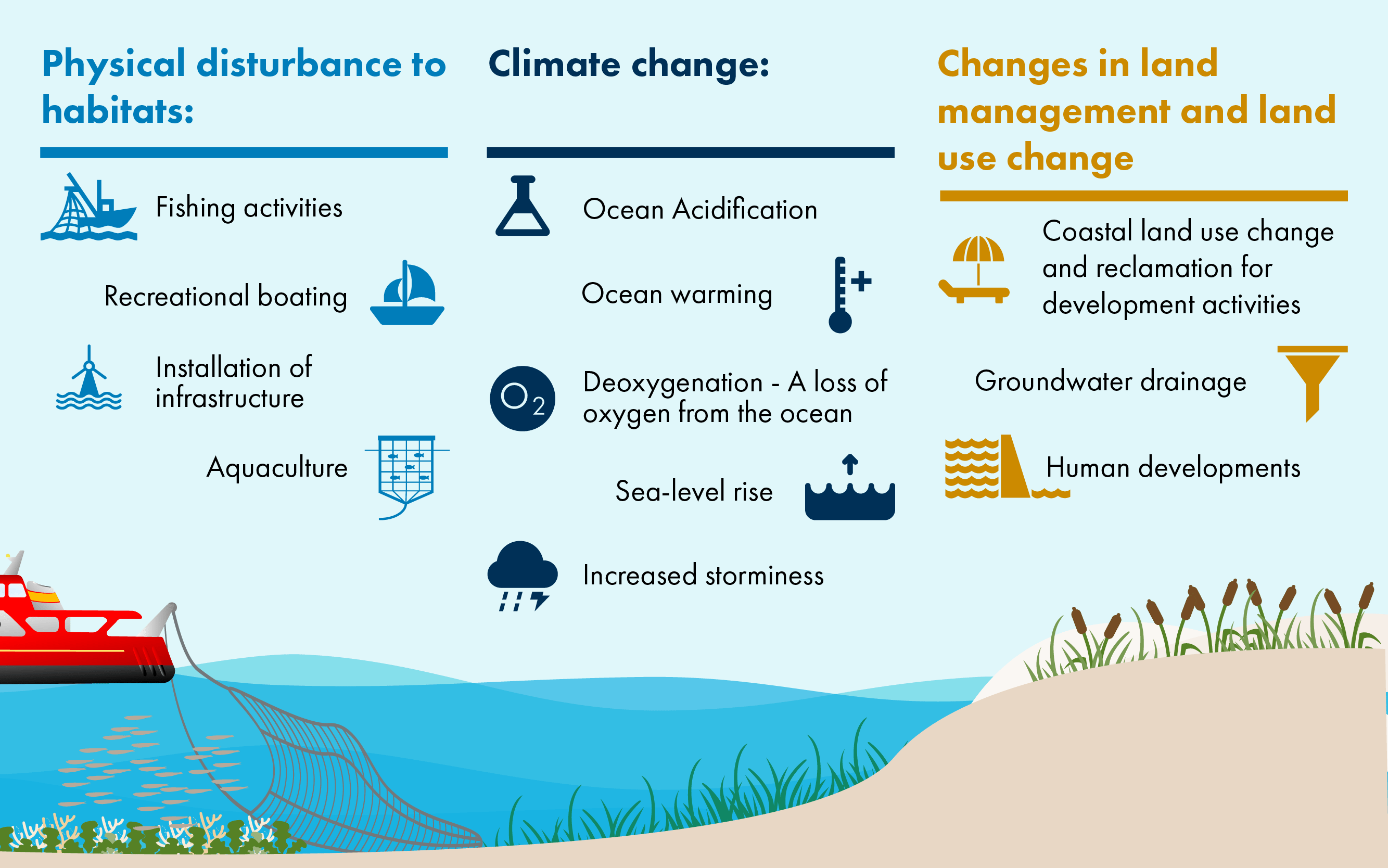
Physical disturbance
Geological Carbon Stores
Aside from their impacts on biodiversity, human activities such as bottom-towed fishing can physically disturb seafloor sediments12.
The effect of physical disturbance on sediment carbon release remains an area of ongoing research. Physical disturbance to sediments can release stored carbon back into the water column and has been demonstrated in North Sea sediments3. The impact of physical disturbance intensity remains unclear but holds implications for determining whether the majority of carbon release occurs from single incidences or repeated disturbance through human activities.
Research shows that organic carbon density varies over Scotland's seas4, suggesting that the effect of physical disturbance on carbon release depends on location5. Sea loch sediments and inshore seafloor sediment have high organic carbon densities47, and as such may be more sensitive to carbon release following physical disturbance - however this is an ongoing area of research.
Biological blue carbon species and habitats
Some human activities physically impact biological blue carbon species and habitats, including:
Large-scale mechanised kelp harvesting, whereby the whole kelp plant is removed and prevents kelp regrowth8. There are restrictions on the mechanical removal of kelp for commercial use as part of the Scottish Crown Estate Act 2019.
Cable deployment and maintenance can also cause some physical damage to seabed habitats, but this disruption is minimal9.
Boating and anchoring activities in seagrass meadows may kill seagrasses and diminish the underlying soil's carbon-storing capacity1011.
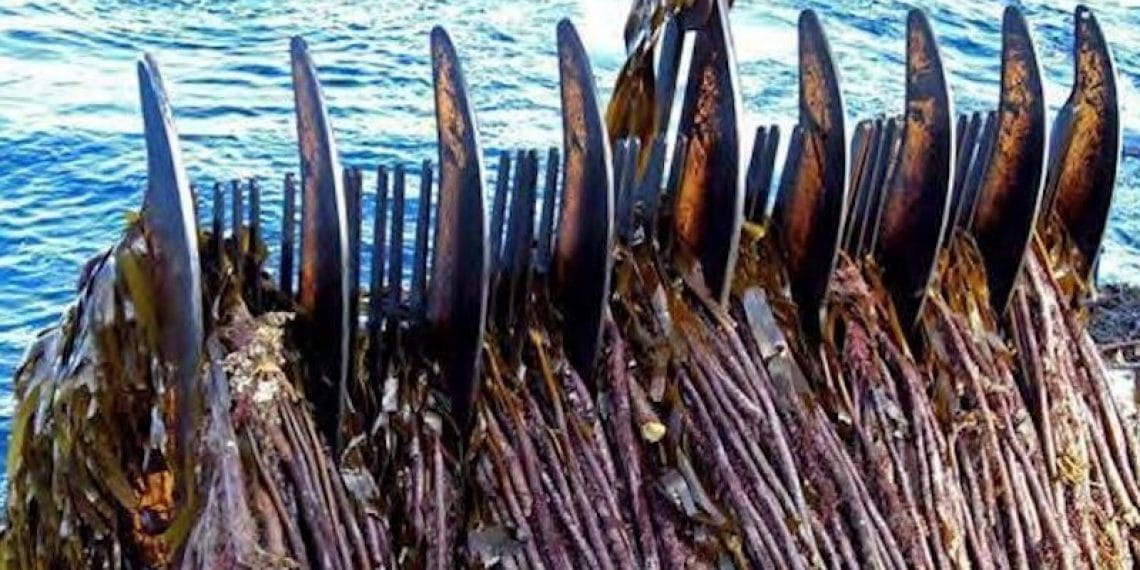
Bottom-towed fishing
Bottom trawling is a fishing method that involves dragging a net along the seafloor to catch fish such as pollock, cod, flounder and prawns. Dredging involves dragging a heavy frame with an attached mesh bag along the seafloor to catch animals living on or in the mud or sand; catches include scallops, clams and oysters.
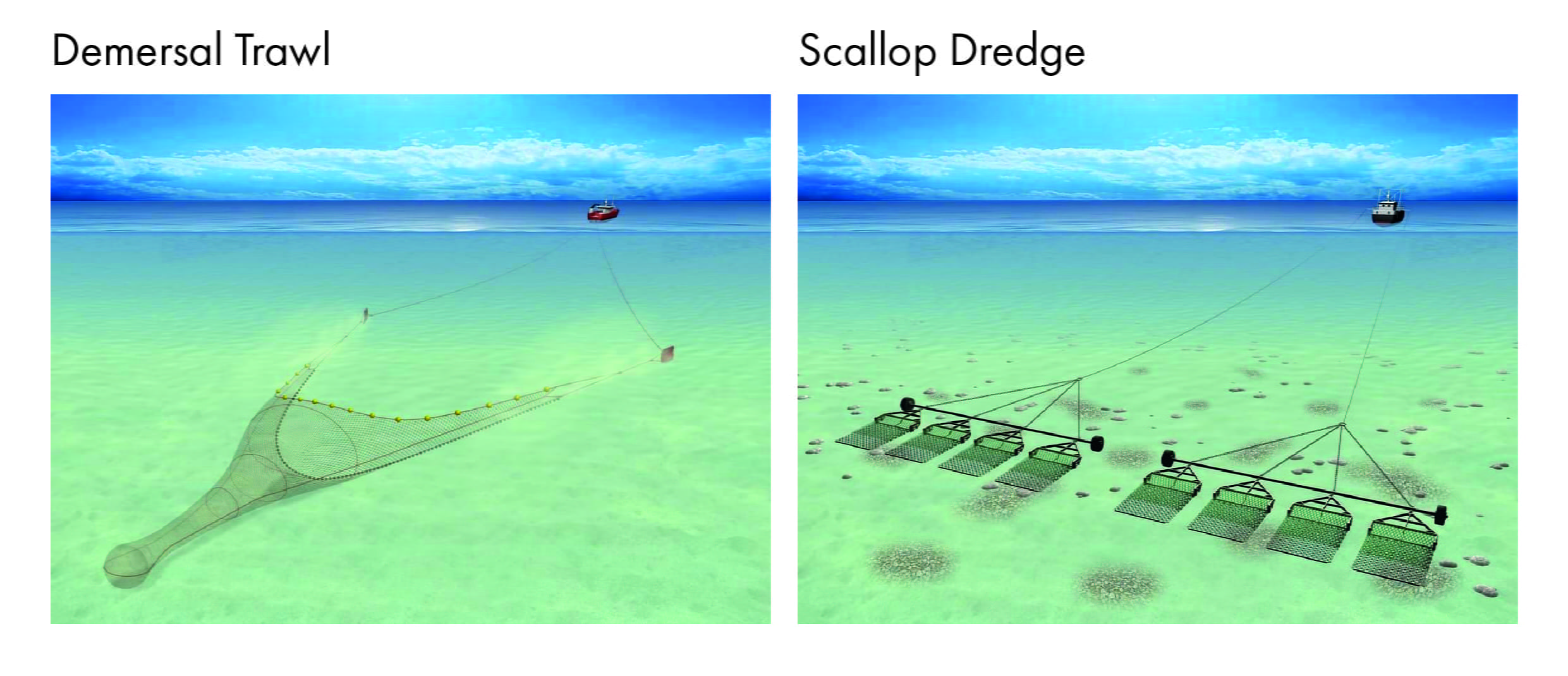
Bottom trawling and dredging is one of the main causes of seabed disturbance in the UK's seas and globally12. Scotland's Marine Assessment 2020 concluded that disturbance caused by towed, bottom-contacting fishing was widespread across most Scottish Marine Regions and Offshore Marine regions. The analysis considered disturbance from surface and sub-surface abrasion caused by fishing vessels over 12 m in length using Vessel Monitoring System (VMS) (reporting vessels) fishing with bottom contacting gears. The analysis predicted that seafloor habitats are in poor condition across more than half of their area in nine out of 21 Scottish Marine regions, and some level of damage is likely in all regions.
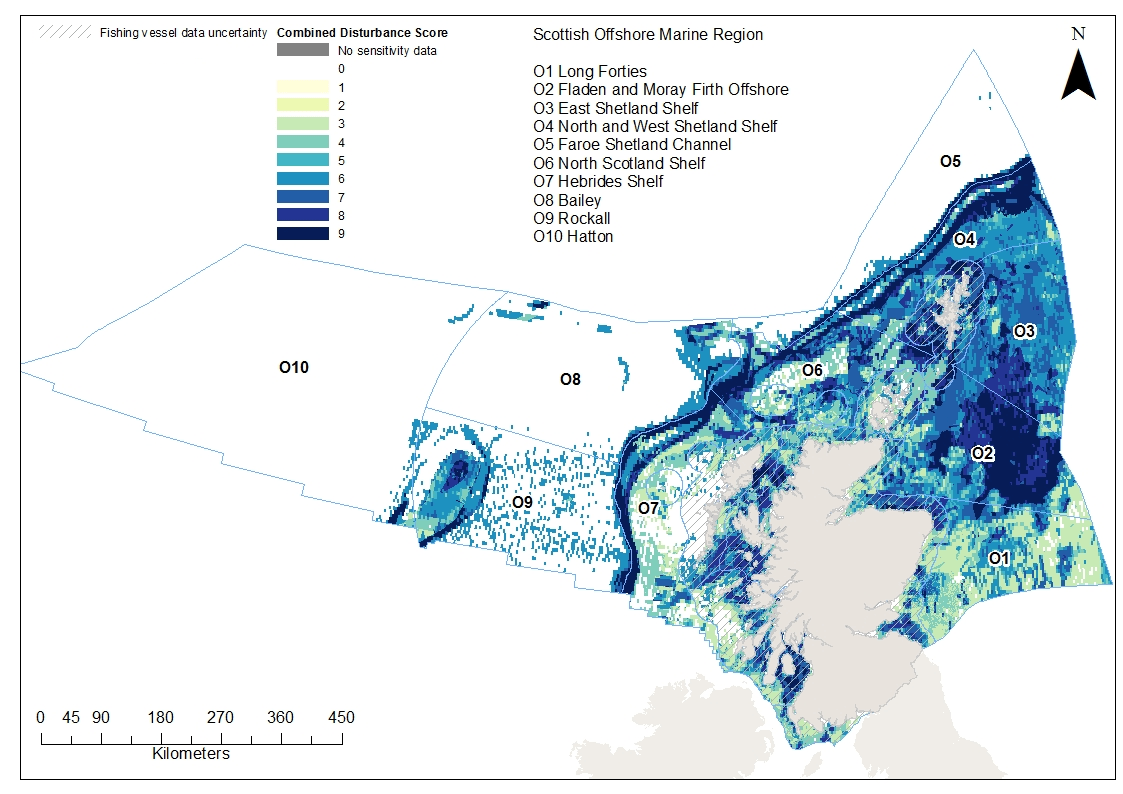
Static fishing gears
Static fishing gears (equipment which allows fish to swim into it, or attracts fish by bait and consequently become caught by the gear i.e. nets, long lines and traps) can also cause physical damage to blue carbon habitats, specifically biogenic reef-forming ecosystems and maerl beds. Reefs can become entangled in ropes, lines or nets or be plucked off the seabed during hauling3.
Management of bottom-towed fishing
The designation of an MPA does not automatically introduce fisheries restrictions4. However, a number of restrictions on fishing in MPAs have been established to avoid threats to protected features. Fishing in MPAs can be regulated using powers under the Inshore Fishing (Scotland) Act 1984, which allows Scottish Ministers to prohibit fishing within particular areas or through introduction of a Marine Conservation Order under the Marine (Scotland) Act 2010. Currently, 2.5% of regions found within MPAs are subject to management measures that restrict or ban mobile bottom-towed fishing5.
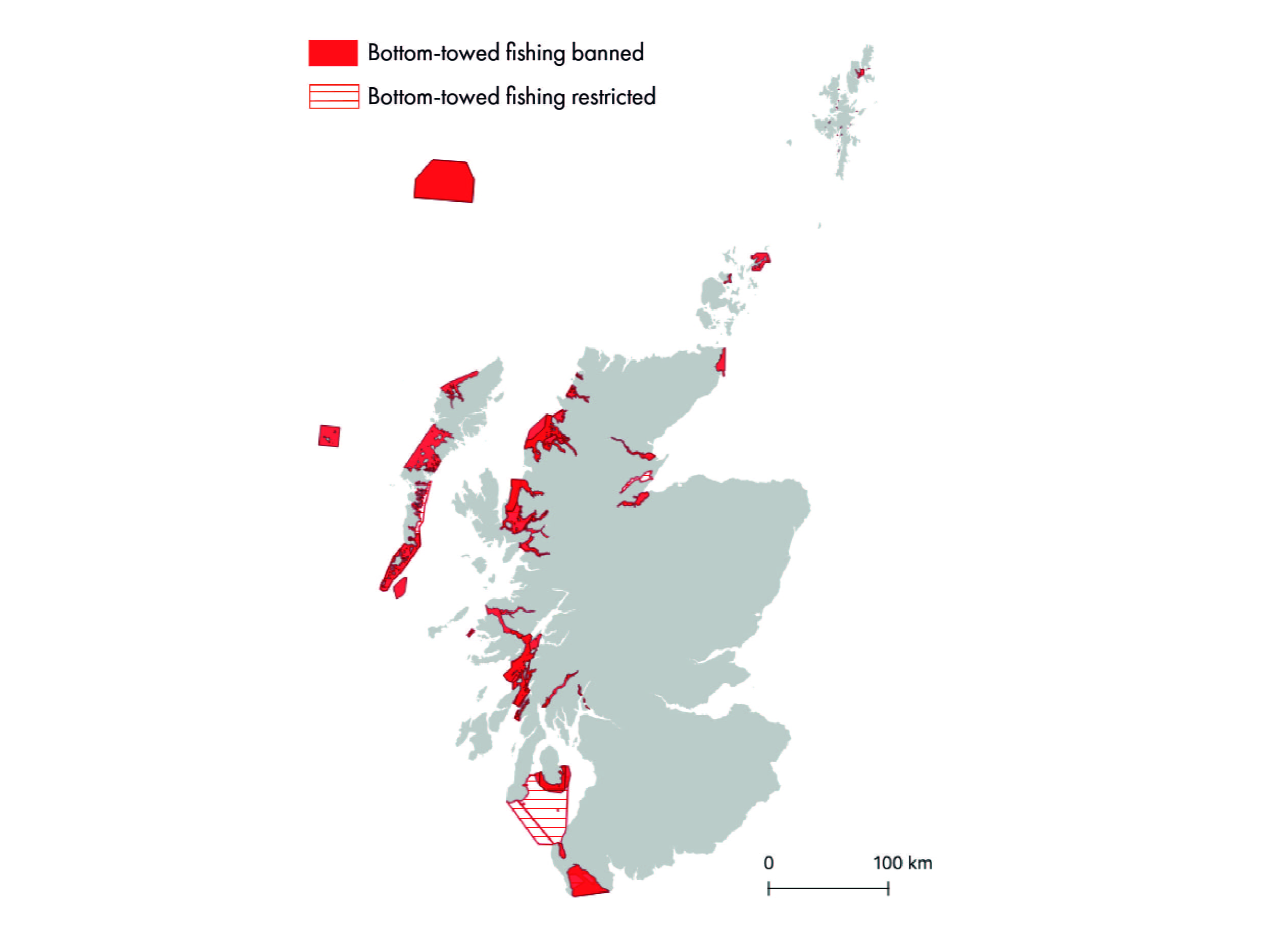
Geological Blue Carbon Stores
The effect of bottom-towed fishing on carbon release from sediments remains an ongoing research area. Initial estimates predict that a single trawl pass releases 0.07 tonnes of CO2-eq per hectare6. As with all physical disturbances, the quantity of carbon release will depend on the sediment type and carbon density.
A recent study estimates that 90% of the UK's Exclusive Economic Zone is within the top 10% of the global ocean that should be safeguarded through MPA networks for it's sediment carbon stores7. Currently, only a small proportion of Scotland's seafloor sediment organic carbon stores are within regions where bottom-trawling or dredging activities are restricted or banned completely. Scottish Ministers have powers to manage marine geological carbon stores as part of Marine Protected Areas, in recognition of their role in mitigating climate change.
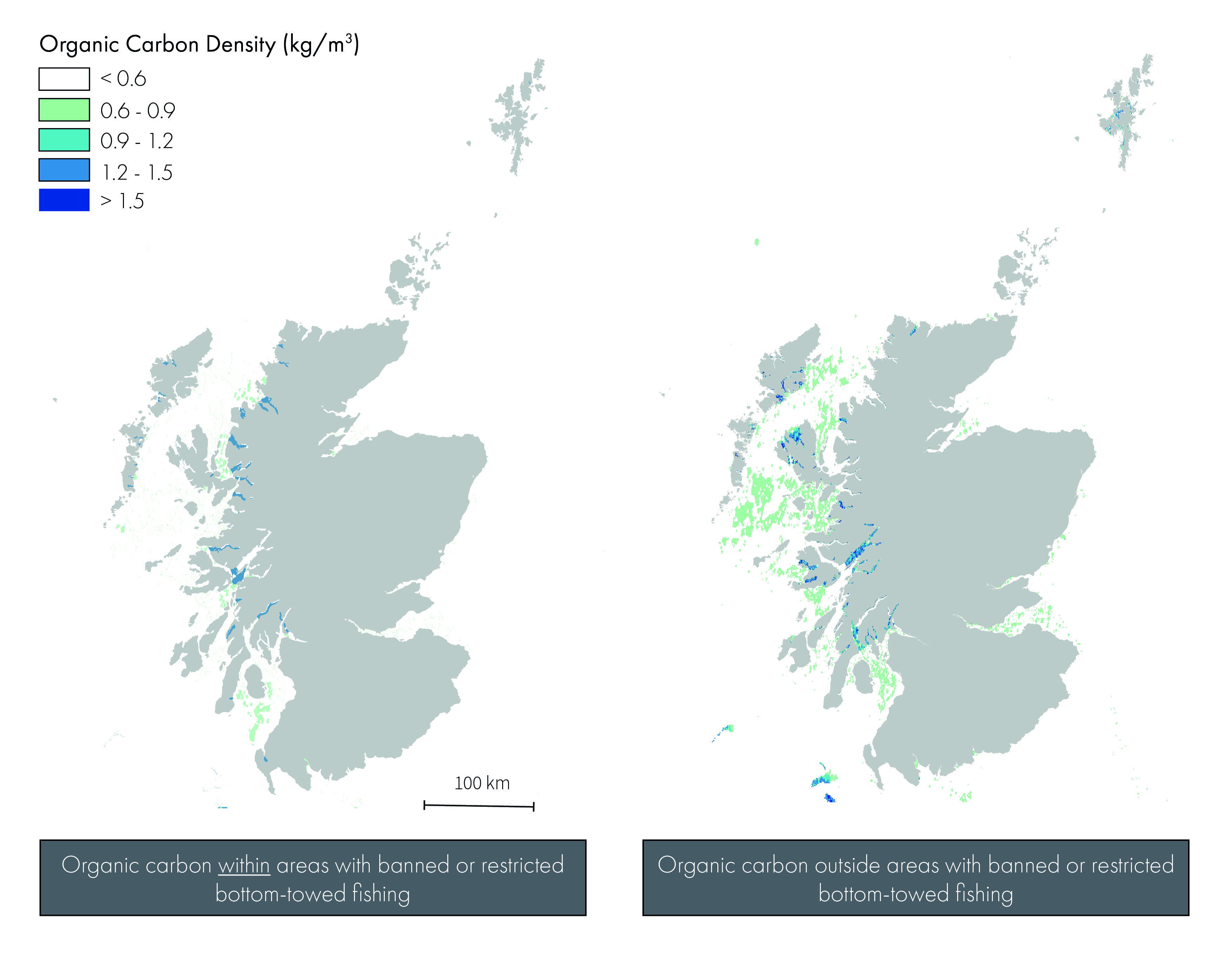
Marine Biological Carbon Stores
The physical disturbance caused by bottom-towed fishing, notably scallop dredging has detrimental impacts on kelp, biogenic reefs and seagrass communities in Scottish waters910. A single dredge-tow can remove up to 70% of maerl and entire flame-shell beds11, taking decades to recover12 and releasing the carbon associated with these deposits13. Maerl beds have declined across the west coast of Scotland in response to the expansion of the scallop industry1115.
Currently, a small proportion of Scotland's blue carbon habitats (within the Priority Marine Features list) lie within regions where bottom-towed fishing activities are banned or restricted. In April 2017, a flame shell bed was damaged in Loch Carron by illegal scallop dredging activity. In response, the Scottish Government began a scoping project to improve protection given to Priority Marine Features (PMFs) outside Marine Protected Areas.
The project identified 11 habitats which are particularly sensitive to impact from bottom contacting mobile fishing gears, of which the following are blue carbon habitats:
Blue mussel beds
Cold-water coral reefs
Flame shell beds
Horse mussel beds
Maerl beds
Maerl or coarse shell gravel with burrowing sea cucumbers
Seagrass beds
Serpulid aggregations
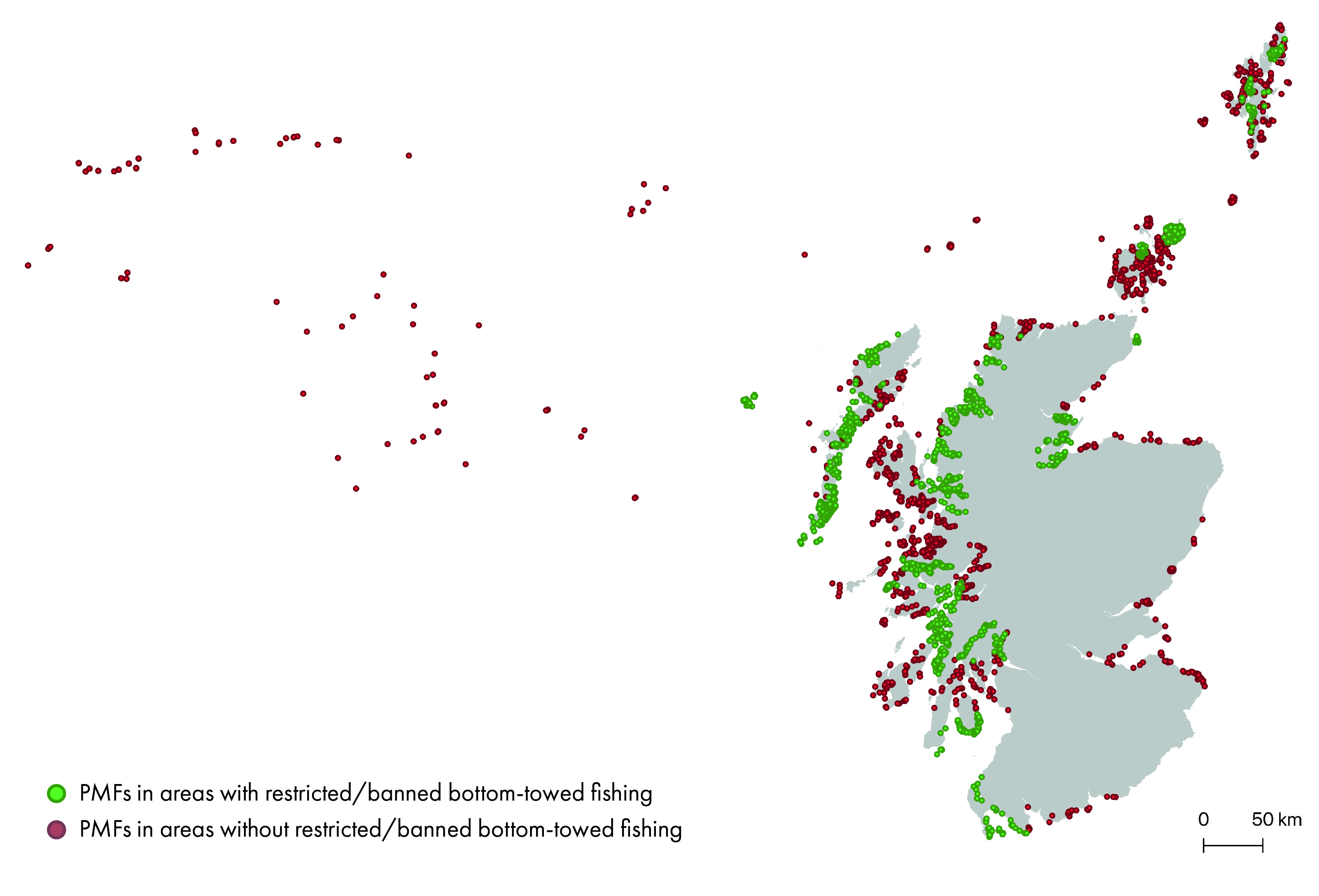
Climate Change
Ocean acidification
Geological Carbon Stores
Ocean acidification is a particular threat to marine organisms which produce shells or external skeletons formed of inorganic carbon (e.g. Biogenic reefs and some phytoplankton). A change in marine organisms' ability to produce inorganic carbon shells or external skeletons may indirectly impact the amount of inorganic carbon delivered to seafloor and sea loch sediments for long-term carbon storage.
Ocean acidification may also directly increase inorganic carbon dissolution in already buried sediments1, releasing stored inorganic carbon. However, as sites monitoring Scottish seawater chemistry have less than 20 years of data2, it is not possible to accurately determine whether there has been a significant change in oceanic pH and carbonate chemistry to cause such effects in Scottish waters.
Biological Carbon Stores
Under all projected ocean acidification scenarios, ideal conditions for organisms which produce shells or external skeletons (such as maerl beds, cold-water corals and flame shell beds) are predicted to decrease in extent34. Cold-water corals found in deep waters, such as the Darwin Mounds to the northeast of Rockall and the Mingulay reef complex in the Sea of the Hebrides, are particularly sensitive to ocean acidification5. Ocean acidification has also been shown to decrease the strength of mussel attachment6, with implications for the ability of mussels to form biogenic reefs. Depending on the rate of ocean acidification, there is some evidence that organisms may adapt to increasing acidification71 but this would only apply to living organisms (e.g. living maerl) and not dead inorganic carbon stores such as maerl beds.
Ocean deoxygenation
Geological Carbon stores
As the ocean warms, its ability to store oxygen decreases, leading to oxygen loss (deoxygenation). Oxygen is required for the breakdown and release of carbon from phytoplankton and kelp biomass. A reduction in oxygen concentrations may therefore promote the preservation of phytoplankton and kelp-derived carbon into seafloor and sea loch sediments. Sea lochs are already prone to undergoing periods of low oxygen, potentially explaining their relatively greater organic carbon burial1. Oxygen levels can vary at different depths2, and the Scottish Marine Assessment 2020 reports there is currently insufficient data to make a robust assessment for near-bed oxygen levels. Therefore the potential for ocean deoxygenation to impact carbon burial in sediments remains unclear.
Biological Carbon Stores
The effect of ocean deoxygenation on blue carbon ecosystems is variable, as the concentration of oxygen required to invoke a toxic effect is species-specific3. Deoxygenation is predicted to negatively impact maerl species richness4, and oxygen depletion will kill living maerl5 and hamper kelp growth6. Historical data over the last century from the International Council for the Exploration of the Sea oceanographic database highlight an increase in seasonal oxygen depletion that is considered low enough to cause detrimental, and potentially lethal, effects on marine ecosystems7.
Sea-level rise and ocean warming
Biological carbon habitats
There is evidence that coastal habitats in Scotland are already experiencing the effects of increased temperatures and sea-level rise12. Increased sea temperatures can reduce the growth of seagrasses3, maerl4 and kelp forests5. In some cases, particularly for kelp, the effect of rising temperatures is uncertain due to sparse data coverage, inconsistent methodology and lack of adequate temperature time-series. Nonetheless, ocean warming has decreased the prevalence of the UK kelp species, Saccorhiza polyschides6. In addition, ocean warming may shift the dominant species composition of kelp5, with potential implications for carbon sequestration rates. A change to the dominant species of phytoplankton has already been identified in the North-east Atlantic area of Scotland's seas by the Continuous Plankton Recorder (CPR). Research is ongoing to identify the factors which drive the change in phytoplankton species in Scotland's marine environment.
Sea-level rise is a particular threat to low-lying coastal habitats such as saltmarshes, machair and sand dunes. Research predicts that sea-level rise will reduce saltmarsh and machair area by 6% by 20608. Other climate-change driven changes, such as changes in rainfall patterns, are expected to have a detrimental effect on sand dune habitats. There has been a 30% decrease in dune slack (low-lying dune areas) extent at certain sites in England, ostensibly due to drying out2.
Other pressures
Land Use Change
Land-use change for human activities is a threat to coastal blue carbon habitats such as saltmarshes, sand dunes and machair. The main threats are land claim for agricultural crop production and grazing livestock, water diversion through dams, dykes and canals, and pollution from both air and water-borne sources. Around the UK, saltmarsh habitat losses have occurred due to drainage and reclamation for agriculture or other coastal development1. In Scotland, large areas of saltmarsh were claimed for agriculture in the past, notably in the Firth of Forth.
Other human developments, such as the installation of coastal defences, can also negatively impact saltmarshes. Providing sediment supply is high, saltmarshes can keep pace with sea-level rise, moving landwards and acting as a natural coastal management strategy. If artificial flood defences, such as sea walls, are present, saltmarshes are prevented from migrating landward naturally, causing them to decrease in size in a process known as 'coastal squeeze'2. Coastal erosion can also negatively impact sand dunes, which are expected to decrease 6% by 20603.
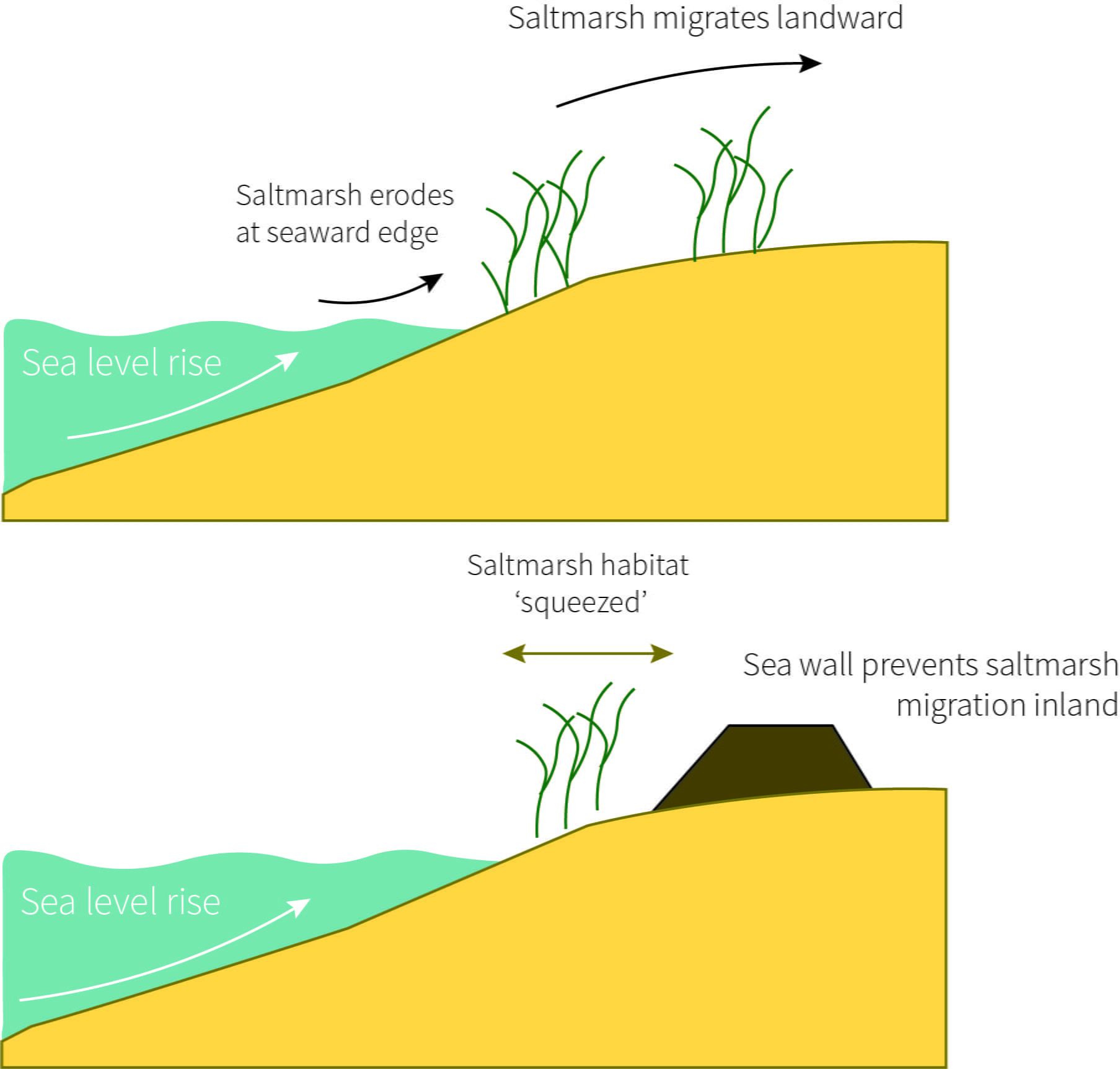
Increased sediment supply
Land reclamation (land gain from the sea or coastal wetlands for agricultural purposes, industrial use or port expansions) may deposit more sediment into nearby coastal waters. This can lead to decreased seawater clarity, which reduces light availability and therefore marine organisms' ability to carry out photosynthesis and sequester carbon. Maerl beds in the British Isles are already restricted to shallow waters, and therefore changes in light availability may adversely affect the depth distribution of maerl4. A reduction in light can also lead to seagrass mortality5 with coastal engineering and dredging implicated in the decline of seagrass beds worldwide67. Climate change-related storm events, which deliver high sediment loads to coastal environments, can also lead to similar effects and result in seagrass mortality8.
Blue Carbon & Conservation Policy
Overview
Some blue carbon habitats are protected by current legislation, based on their contributions to Scotland's biodiversity. However, there are opportunities for blue carbon habitats and stores to be protected given their role in climate change mitigation.
Legal protection of blue carbon habitats and species (based on biodiversity contributions) is underpinned by powers made available to Scottish Ministers through the Marine (Scotland) Act 2010 and Marine and Coastal Access Act 2009 (referred to as the Marine Acts). Some blue carbon habitats are afforded legal protection through the Nature Conservation (Scotland) Act 2004 (Sites of Special Scientific Interest), Conservation (Natural Habitats,&c.) Regulations 1994 (Special Areas of Conservation) and the Scottish Crown Estate Act.
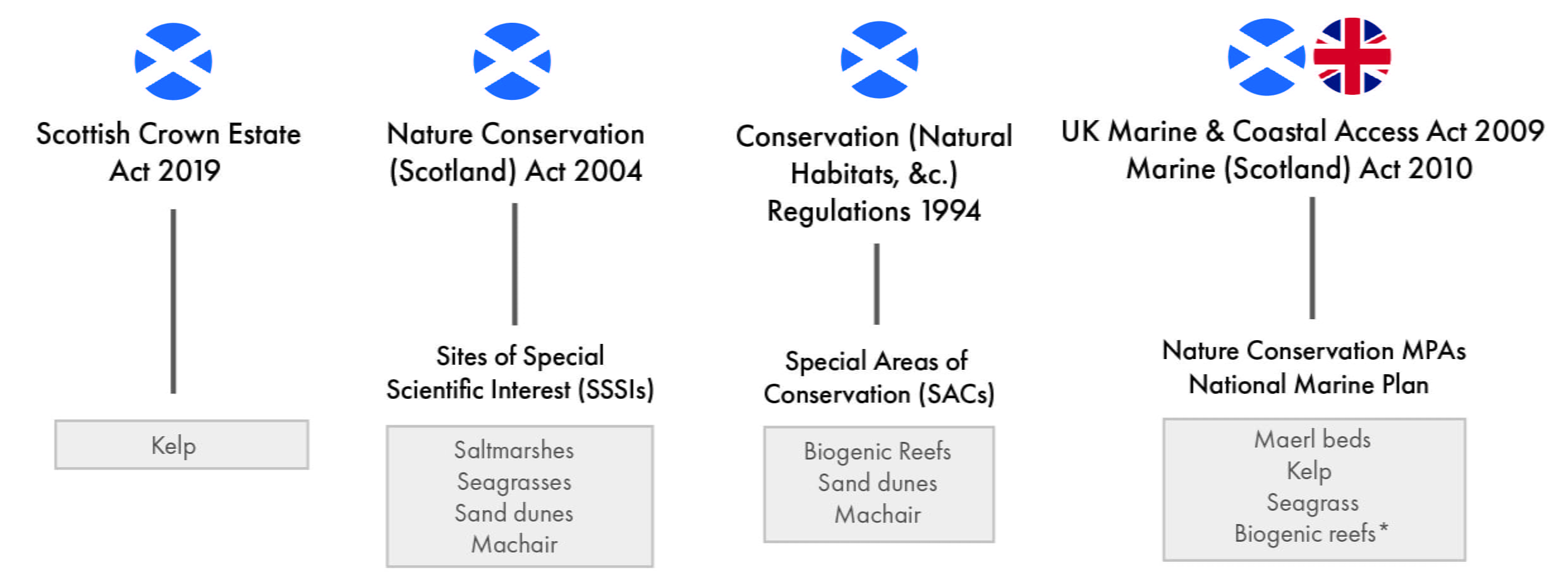
International Commitments
Scotland has a number of international commitments to conserve and protect biodiversity, which encompasses the living biological blue carbon habitats and species outlined in this briefing. These commitments include:
Ramsar Convention
OSPAR Convention
Convention on Biological Diversity (Aichi Targets)
UN Sustainable Development Goals (SDG)
The Marine Acts
Marine (Scotland) Act 2010 is an Act of Scottish Parliament which gives Scottish Ministers powers over Scotland's Territorial waters (waters up to 12 nautical miles off the coastline, known as the Inshore Zone). The Marine and Coastal Access Act 2009 is an Act of the UK Parliament that gives Scottish Ministers power over Scottish offshore waters (the Exclusive Economic Zone and continental shelf). Collectively, these are termed the Marine Acts.
General principles
On a broad level, Section 3 and 4 of the Marine (Scotland) Act 2010 require that when exercising powers under the Act, Scottish Ministers and other public authorities must (emphasis added):
act in the way best calculated to further the achievement of sustainable development, including the protection and, where appropriate, enhancement of the health of that area, so far as is consistent with the proper exercise of that function
and -
act in the way best calculated to mitigate, and adapt to, climate change so far as is consistent with the purpose of the function concerned.
More specific opportunities for blue carbon protection fall under the setting out and implementation of a National Marine Plan and Nature Conservation Marine Protected Areas.
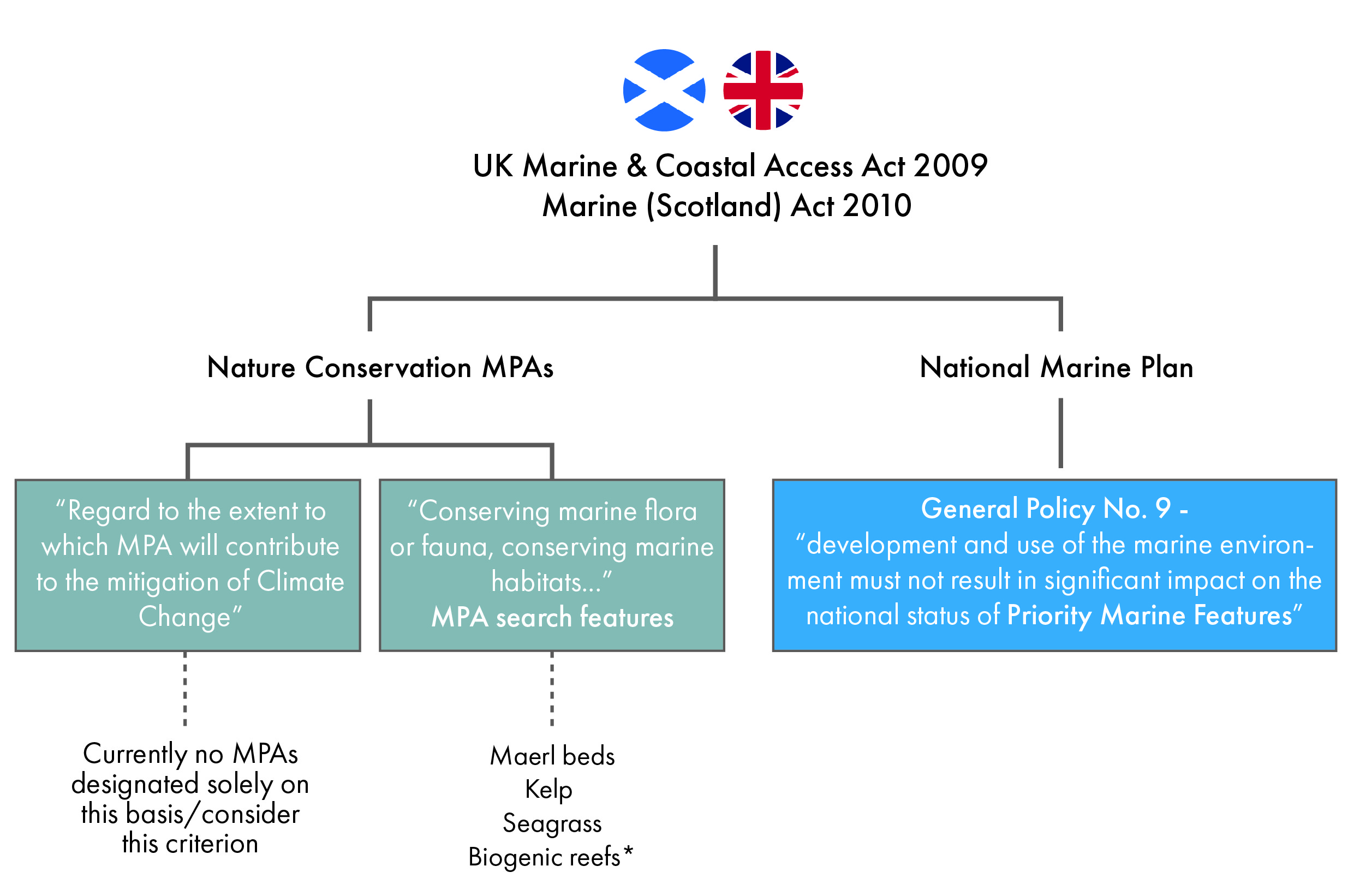
National Marine Plan
Under the Marine Acts, Scottish Ministers must prepare and adopt a National Marine Plan (NMP) which must set:
Economic, social and marine ecosystem objectives,
Objectives relating to the mitigation of, and adaptation to, climate change
And must prepare (as outlined in Assessment of Scotland's Blue Carbon):
An assessment of the condition of the Scottish marine area or, as the case may be, Scottish marine region at the time of the plan's preparation
Summary of significant pressures and the impact of human activity on the area or region.
The Plan may also 'include statements or information relating to policies'.
NMP and Priority Marine Features
The current NMP (published in 2015) sets out policies that aim to enable the sustainable development of Scotland’s marine resources out to 200 nautical miles, framed under a set of general policies that apply across all existing and future development and use of the marine environment.
General Policy number 9 in the NMP is relevant to blue carbon habitats, and states that the development and use of the marine environment must (emphasis added):
Comply with legal requirements for protected areas and protected species.
Not result in significant impact on the national status of Priority Marine Features.
Protect and, where appropriate, enhance the health of the marine area.
What are Priority Marine Features?
Priority Marine Features (PMFs) are habitats and species of conservation importance in Scotland's seas. Scottish Ministers formally adopted the list of 81 PMFs in July 2014, in conjunction with Marine Scotland, the Joint Nature Conservation Committee (JNCC) and Scottish Natural Heritage (SNH, now NatureScot)1.
The Marine Nature Conservation Strategy proposed PMFs to guide the identification of Nature Conservation Marine Protected Areas and provide a focus for marine planning and other activities.
Numerous biological blue carbon ecosystems are listed as PMFs within territorial (within 12 nautical miles) and offshore waters (12 - 200 nautical miles):
| Priority Marine Feature | PMF region |
|---|---|
| Cold-water corals (Biogenic reefs) | Both territorial and offshore waters |
| Coral gardens (Biogenic reefs) | Offshore waters |
| Flame shell beds (Biogenic reefs) | Territorial waters |
| Kelp beds | Territorial waters |
| Kelp and seaweed communities on sublittoral sediment | Territorial waters |
| Maerl beds | Territorial waters |
| Maerl or coarse shell gravel with burrowing sea cucumbers | Territorial waters |
| Seagrass beds | Territorial waters |
The Marine Acts (Section 15 of the Marine (Scotland) Act 2010; Section 58 of the Marine and Coastal Access Act 2009) require that public authorities take authorisation or enforcement decisions in accordance with the NMP (and policies therein) and have regard to the NMP in taking other decisions if they impact on the marine area.
Public authorities must therefore make decisions with regard to, among other things, General Policy Number 9 of the NMP and their impact on the national status of Priority Marine Features (which includes some blue carbon habitats). The NMP elaborates on this:
Development and use of the marine environment must not result in significant impact on the national status of Priority Marine Features. Impacts of development and use on the national status of Priority Marine Features must be considered when decisions are being made, taking account of the advice of Statutory Advisors. Where planned developments or use have potential to impact PMFs, mitigation, including alternative locations, should be considered. Actions should be taken to enhance the status of PMFs where appropriate.
Marine Protected Areas
Marine protected areas (MPAs) play a key role in protecting Scotland's biodiversity and help Scotland achieve its international commitments towards enhancing biodiversity.
For instance, both the UN Sustainable Development Goals and the Convention on Biological Diversity (Aichi Targets) set targets for increasing the percentage of the oceans protected through MPAs. The Aichi target further outlines that these regions 'are conserved through effectively and equitably managed, ecologically representative and well -connected systems of protected areas'.
Once MPAs have been designated, their ability to meet biodiversity goals relies on effective MPA management.
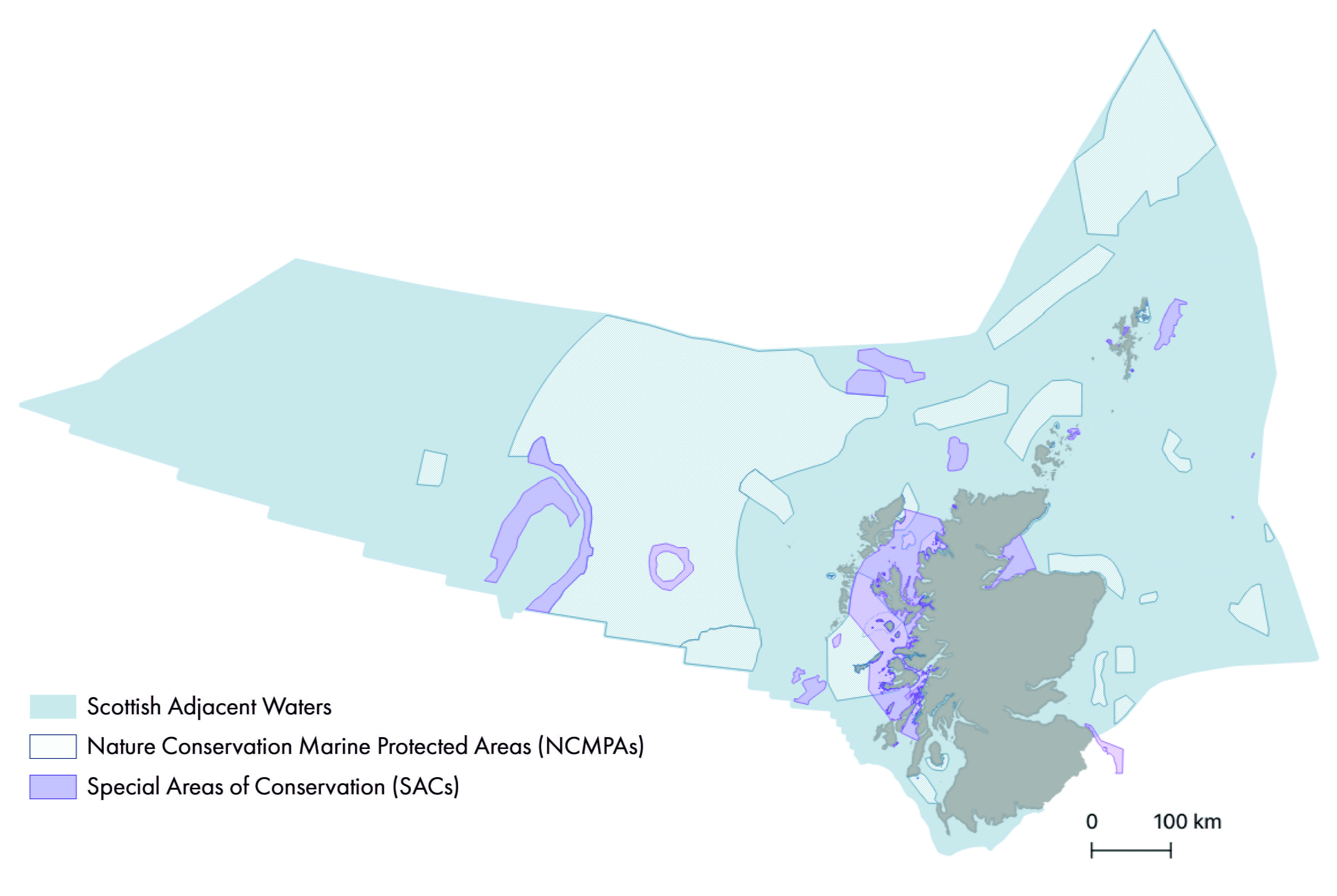
Designation
The Marine Acts include powers for Scottish Ministers to designate Nature Conservation MPAs, based on:
Conserving flora or fauna
Conserving marine habitats or types of such habitat
Conserving features of geological or geomorphological interest
The designation of Nature Conservation MPAs is based on a sub-list (known as MPA search features) of Priority Marine Features (PMFs). Priority Marine Features are a list of habitats of conservation priority including numerous blue carbon habitats such as kelp beds, seagrasses and biogenic reefs1234. Excluding kelp beds, all blue carbon habitats which are PMFs are also MPA search features:
Biogenic Reefs
Horse mussel beds (biogenic reefs)
Fan mussel aggregations
Native oysters
Maerl and Maerl beds
Flame Shell Beds
Coral gardens
Blue mussel beds
Seagrass beds
Kelp on sublittoral sediments
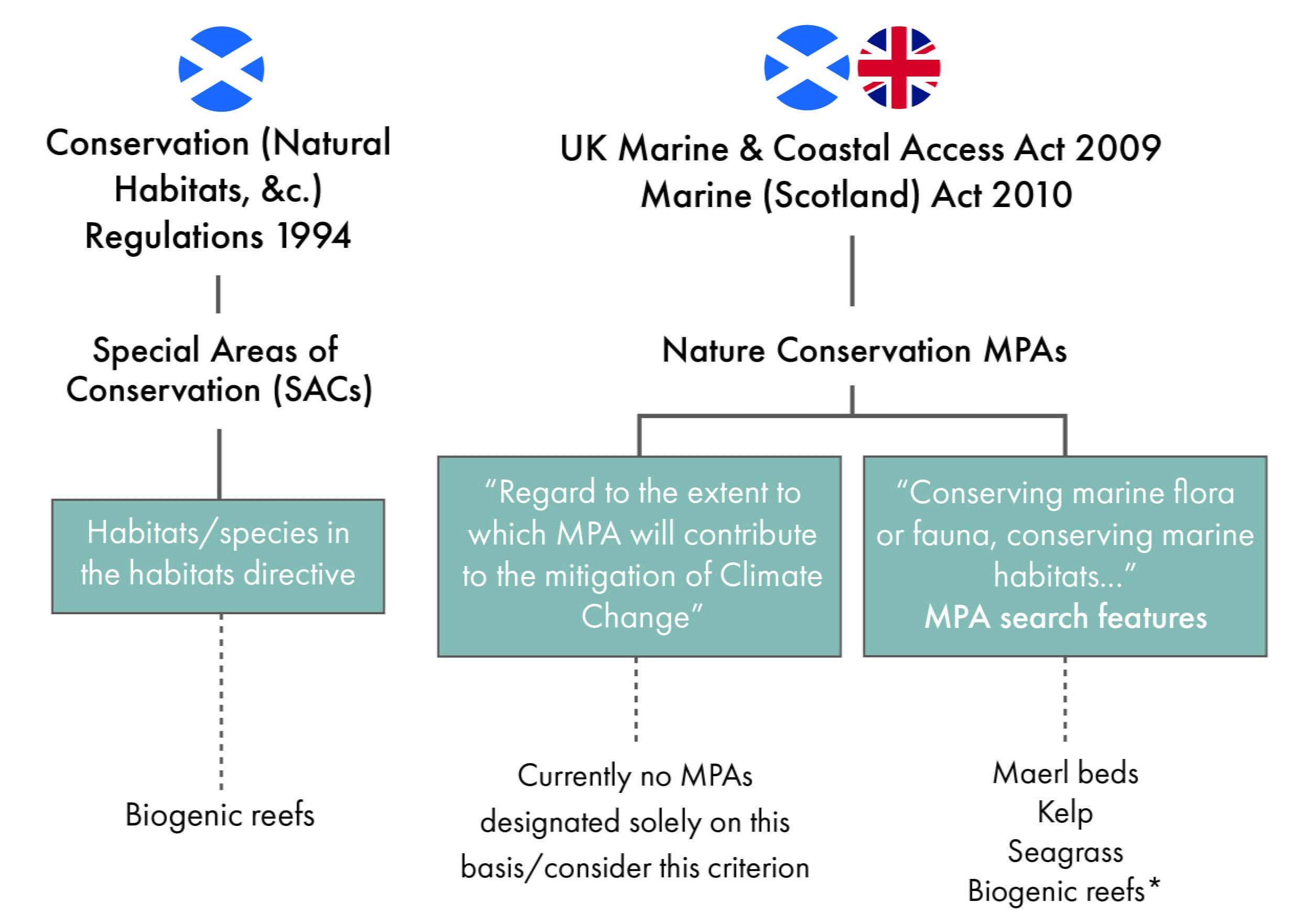
OSPAR guidance for designation of MPAs
In 2003, the UK Government committed as part of the OSPAR convention to establishing a well-managed, ecologically coherent network of MPAs. The designation of Nature Conservation MPAs aims to meet this commitment.
The OSPAR commission set out guidelines for the identification and selection of Marine Protected Areas in the OSPAR Maritime Area (Agreement 2003-17), which outlines the steps to be followed in identifying potential new sites and identifies the criteria which should be met. These criteria are:
Ecological criteria/considerations
Threatened or declining species and habitats/biotopes
Important species and habitats/biotopes
Ecological significance
High natural biological diversity
Representativeness
Sensitivity
Naturalness
Practical criteria/considerations
Size
Potential for restoration
Degree of acceptance
Potential for success of management measures
Potential damage to the area by human activities
Scientific value
Special Areas of Conservation (SACs)
A Special Area of Conservation (SAC) protects one or more special habitats and/or species, listed in the Habitats Directive, receiving protection under the Conservation (Natural Habitats, &c.) Regulations 1994. Currently, SAC designations for blue carbon protection include biogenic reef-forming habitats, sand dunes and machair5(most notably Monach Isles SAC and South Uist SAC6).
Together, SACs and Nature Conservation MPAs make up the majority of Scotland's marine protected network. MPA and SAC management aims to conserve the features on which the MPA has been designated, support the restoration of identified features, and restrict activities that prevent these goals from being reached.
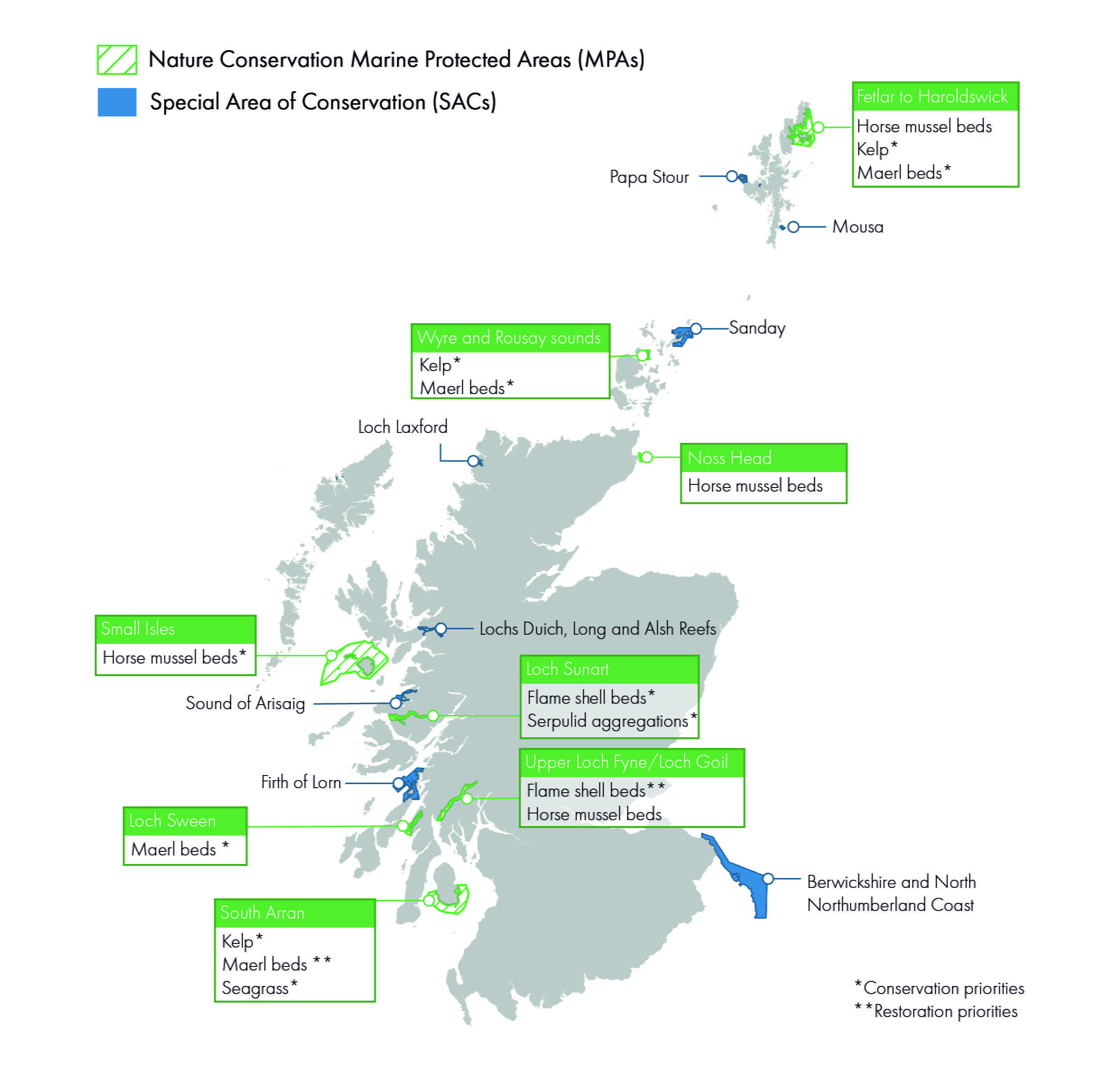
Blue Carbon in Scotland's Marine Protected Areas
In 2017, the Scottish Government commissioned research by NatureScot to assess blue carbon within Scotland's inshore (within 12 nautical miles) Nature Conservation MPAs and Special Areas of Conservation (SACs)6. The research found that inshore protected regions store 1.6% of the organic carbon and 2.7% of the inorganic carbon within Scotland's total blue carbon stores. The report further estimated that habitats within Nature Conservation MPAs and SACs sequester 1.8% of total organic carbon across Scotland's seas. Values of the total amount of inorganic carbon sequestered in these regions is less reliable but is expected to be a larger proportion of the total as maerl beds and cold-water coral reefs tend to be focused in inshore MPAs. This work highlights that most of Scotland's blue carbon stores are not protected within the current network of MPAs.
Management
Once designated, MPAs can be managed in a variety of means to restrict activities that harm designated MPA features. The role of Nature Conservation MPAs is to ensure that protected features 'so far as already in favourable condition, remain in such condition, and so far as not already in favourable condition, be brought into such condition, and remain in such condition' 1.
A 'favourable' condition
A ‘favourable condition’ is defined as ensuring the stability of the protected habitat and also the ‘diversity and abundance of species of marine flora and fauna forming part of, or inhabiting, that habitat’1. Therefore any conservation objectives must encompass the protection of the habitat as an ecosystem.
MPA status does not automatically introduce restrictions on human activities, such as restrictions on bottom-towed fishing. However, activities proposed in the protected area must be shown to have benefits that outweigh the risk of damage. If an authority believes that an activity poses a significant risk to the conservation objectives of an MPA, it is required to notify the Scottish Ministers and NatureScot, and wait 28 days before granting authorisation. Section 95 of the Marine Scotland Act 2010 makes it a criminal offence for a person to intentionally or recklessly carry out a prohibited act (including damaging or destroying any protected habitat or feature of the MPA) in an MPA.
Marine Management Schemes
Under Section 99 of the Marine (Scotland) Act 2010 Scottish Ministers and any public authority exercising functions in a Scottish MPA, can establish a Marine Management Scheme. These schemes aim to fulfil functions such as:
Explaining the conservation objectives for the site
Identifying key threats to the designated features
Listing the actions that should be taken
Setting out how progress will be monitored
The purpose of Marine Management Schemes is to provide a more spatially-tailored management approach which can assess the precise threats posed by activities and be more readily responsive to new information as it comes to light3. However, no marine management schemes have been adopted to date.
Marine Conservation Orders
Under Section 85 of the Marine (Scotland) Act 2010, Scottish Ministers can make Marine Conservation Orders (MCOs) that regulate, restrict or prohibit particular activities to further the conservation objectives of the MPA. These are only recommended where existing measures of regulation, such as licensing, voluntary measures, and marine planning are not sufficient to meet the conservation aims of the MPA.
In 2014, the Scottish Government issued an urgent MCO for the first time to protect the fragile maerl bed ecosystems off the coast of the Isle of Arran, which had 'generally been considered to be in poor condition with a very low proportion of live maerl cover'4. The MCO included a prohibition on anchoring any vessel, depositing anything on the seabed, or removing anything from the seabed within the protected area without Scottish Ministers' authorisation.
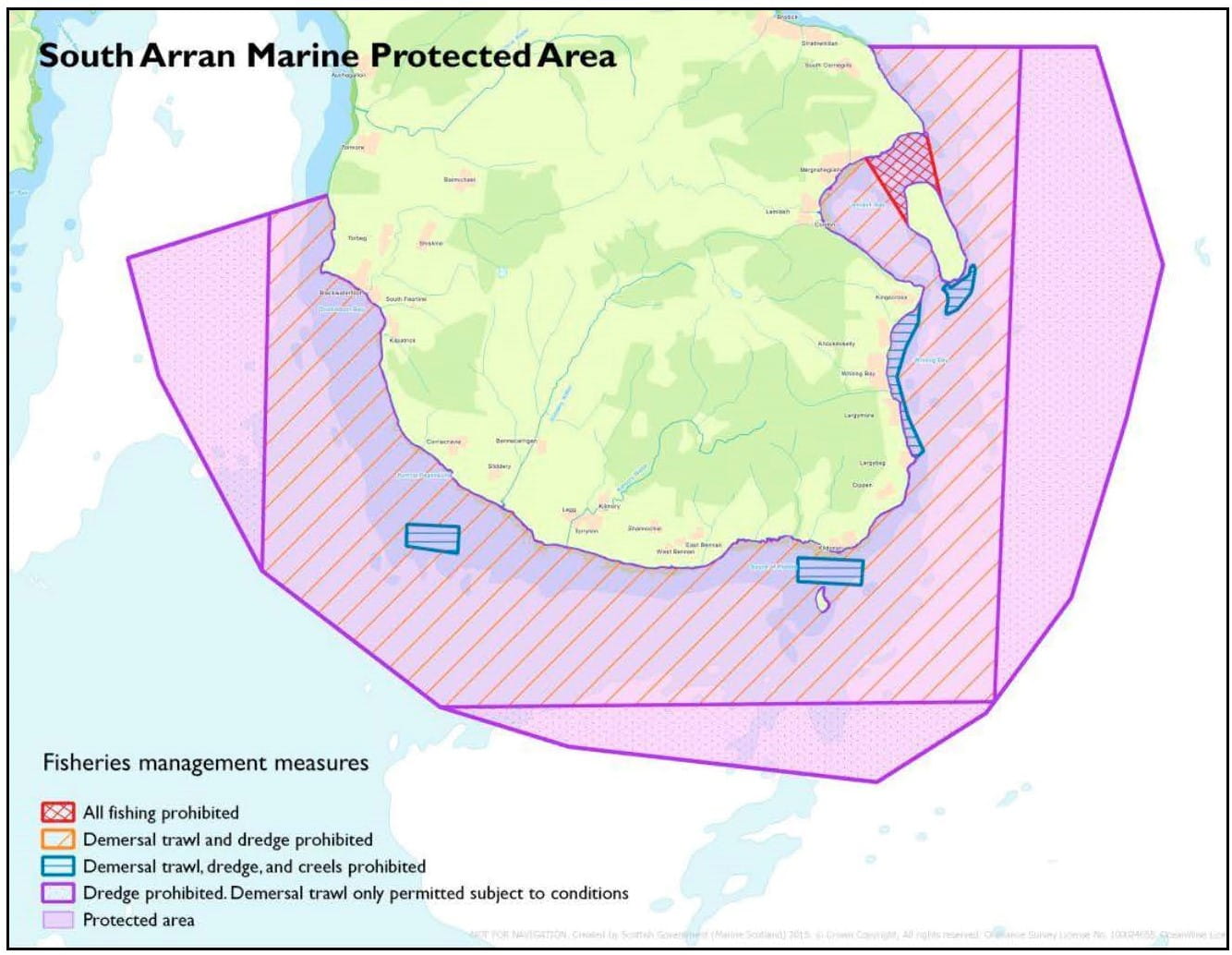
The effectiveness of current MPA management
Scotland has ostensibly already met the 2015 UN Sustainable Development Goal and the 2010 Aichi target for at least 10% of coastal and marine areas to be conserved through MPAs. However, research has raised concerns that current management measures do not do enough to meet conservation goals5. For instance, fishing management measures have been proposed for some sites, such as the Small Isles MPA (which hosts the UK’s only known colony of rare fan mussels) but action has not yet been taken. Research highlights that the Scottish MPA network does often not encompass the known geographical extent of protected species5, despite their extent reported by the OSPAR commission to be in decline7. An example is the fan mussel (biogenic reef-forming habitat), which is only protected by one MPA. However, other reports outline that the protection and coverage provided by MPAs is adequate for most MPA search features or that more data is needed8.
Currently, 2.5% of regions found within Marine Protected Areas are subject to management measures that restrict or ban bottom-towed fishing activities - shown to be the largest source of physical disturbance9. Research indicates that 'protection has been focussed in areas that already act as natural refugia for sensitive benthic species and lie away from the majority of fishing activity'9.
Sites of Special Scientific Interest
Sites of Special Scientific Interest (SSSI) is a statutory designation made by NatureScot under the Nature Conservation (Scotland) Act 2004. Sites are selected after survey and evaluation against the Joint Nature Conservation Committee (JNCC) criteria, on the basis of special interest by reason of flora, fauna, geological, geomorphological or physiographical features. Scotland has 1,422 SSSIs, covering over one million hectares. SSSIs range in size from less than 1 hectare, to 29,000 hectares (the Cairngorms SSSI)1.
Coastal habitats such as saltmarshes, sand dunes and machair are included in the guidelines for selecting SSSIs2. Seagrasses and kelp are also included as 'biotopes of interest' under the guidelines3.
77.4% of Scottish saltmarshes lie with SSSIs4. All sites that are over 1 km2 are under statutory protection. However, several large saltmarshes, such as the largest saltmarsh on the west coast of Loch Carron, are not designated as they are smaller than 1 km25. Seagrass beds within Dornoch Firth, Longman and Castle Stuart Bays, Loch Fleet, and Sunart are also protected as designated SSSIs.
SSSI management
Most SSSIs are in private ownership and the Scottish Government work with their owners and managers to ensure:
Appropriate management of a site’s natural features
All decision-makers are aware of the designation when considering changes in land use or other activities that might affect an SSSI
Under Section 19 of the Nature Conservation (Scotland) Act 2004, it is an offence for anyone to intentionally or recklessly damage the protected natural features of an SSSI.
Nature Conservation Orders
Under Section 23 of the Nature Conservation (Scotland) Act 2004, Scottish Ministers have powers to issue Nature Conservation Orders (NCOs) to protect any natural feature of land that is within an SSSI that is being actively damaged or when there is evidence that it is under threat of damage. The Orders set out certain prohibited operations and the land to which they apply. There are currently 6 NCOs in Scotland, primarily to prevent shellfish extraction or damage to rare fossils.
Scottish Crown Estate Act
In 2017, decision making powers over a collection of rights, functions and assets encompassing the Crown Estate were devolved to Crown Estate Scotland (CES). CES is now responsible for:
Managing approximately half the foreshore around Scotland
Leasing of seabed out to 12 nautical miles
Managing the rights to lease the seabed for offshore renewable energy, gas and carbon dioxide storage out to 200 nautical miles
Mechanical Kelp Harvesting
Kelp harvesting is the subject of another SPICe briefing.
The seabed around the Scottish coast is managed by CES, and any harvesting of seaweed (kelp) below the low tide mark requires a licence from them. Harvesting of seaweed from the foreshore (between the low water mark and the high water mark) may also require a licence in those areas managed by CES, which is approximately 50% of the Scottish coast.
Section 15 of the Scottish Crown Estate Act 2019, which came into effect on 1 October 2020, banned the commercial removal of wild kelp from the seabed in a means that prevents the regrowth of the kelp plant.
During the parliamentary scrutiny of the Scottish Crown Estate Act 2019 a review was announced to gather evidence to help ensure existing seaweed harvesting activity and future proposals are sustainable and Scotland’s marine environment is protected. Accordingly, a Seaweed Review Steering Group was established.
International Commitments
Scotland has a number of international commitments to conserve and protect biodiversity, which includes some of the blue carbon habitats outlined in this briefing.

Ramsar Convention
The Ramsar Convention on Wetlands of International Importance is an international treaty for the conservation and sustainable use of wetlands. It is also known as the Convention on Wetlands.
All Ramsar sites are also Natura 2000 sites (a network of core breeding and resting sites for rare and threatened species and some rare natural habitat types) and/or Sites of Special Scientific Interest (SSSIs) and therefore, these sites often receive statutory protection under the Nature Conservation (Scotland) Act 2004.
OSPAR Convention
The OSPAR Commission
The OSPAR Commission is an inter-governmental body responsible for overseeing the implementation of the 1992 Convention for the Protection of the Marine Environment of the North-East Atlantic (OSPAR Convention) - to which the UK is a party. The OSPAR Convention aims to prevent and eliminate pollution and protect the maritime area against the adverse effects of human activities.
The majority of Scotland's Seas are within OSPAR Region III (Celtic Seas) and Region II (Greater North Sea). There are also parts of Scotland's seas within Region V (wider Atlantic) and Region I (Arctic Waters).
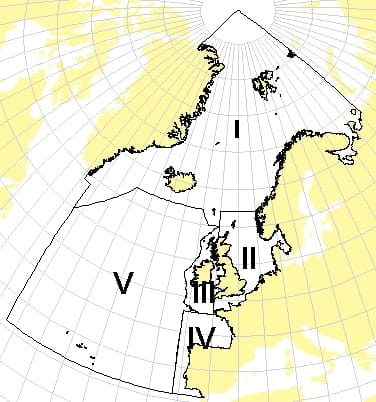
At the OSPAR Commission meeting in Bremen in 2003, the UK committed to the following work being undertaken by 2010:
Setting up a network of ecologically coherent OSPAR (See Marine Protected Areas)
Analysis of listed human activities which are capable of causing adverse damage to the marine environment and the measures necessary to address this in the light of this analysis (See Assessment)
Creation of an effective tool for integrating action across the whole marine environment via the North Sea pilot project, which aims to produce a coherent suite of ecological quality objectives
Taking measures to protect coral reefs
Convention on Biological Diversity (Aichi Targets)
The UK is a signatory of the Convention on Biological Diversity (CBD), which set 20 global targets, known as 2010 Aichi Biodiversity Targets, to be met by 2020. Target 11 is relevant to marine biodiversity:
By 2020, at least 17 percent of terrestrial and inland water, and 10 percent of coastal and marine areas, especially areas of particular importance for biodiversity and ecosystem services, are conserved through effectively and equitably managed, ecologically representative and well connected systems of protected areas and other effective area-based conservation measures, and integrated into the wider landscapes and seascapes.
Scotland's Strategy
In 2013, the Scottish Government published 'The Scottish Biodiversity Strategy: 2020 Challenge for Scotland’s Biodiversity', setting the strategies to achieve the 2010 Aichi biodiversity targets. In relation to Scotland's marine biodiversity, the plan states:
Sustainable management of the seas to deliver multiple benefits will be assured through implementation of the Scottish Marine Nature Conservation Strategy and the National Marine Plan.
An ecologically coherent network of Marine Protected Areas will protect the best of Scotland’s marine nature, promote sustainable use and aid recovery of commercially valuable fish and shellfish.
An innovative system of marine planning will include all those with an interest in the marine environment to ensure the sustainable management of our seas, coasts and islands.
Better understanding of the marine environment will help us identify the marine features most in need of protection, and give better advice on marine and coastal management.
Coasts will be managed to help adapt to pressures from climate change
Scotland's Progress
In 2021, NatureScot published the latest update on Scotland's progress towards the Aichi targets. In the report, the following progress in relation to marine biodiversity is outlined:
| Aichi Biodiversity Target | Scotland's Progress |
|---|---|
| Strategic Goal B: Reduce the direct pressures on biodiversity and promote sustainable use | |
| B5 Habitat loss halved or reduced | Work is ongoing to improve protection of Priority Marine Features and the Scottish MPA network through implementing fisheries management measures. |
| B6 Sustainable management – marine | The development of Scotland’s National Marine Plan, and Aquaculture, Seaweed Harvesting and Fisheries Strategies along with the UK Marine Strategy are all helping to focus efforts towards sustainable management in the marine environment. |
| B10 Pressures on vulnerable ecosystems reduced | Coastal habitats such as machair and saltmarsh as well as intertidal habitats are particularly vulnerable to sea-level rise and increased air and water temperature. Many marine habitats and species such as cold water corals, maerl beds, serpulid reefs, horse mussel and flame shell beds are considered vulnerable to various factors 7 such as temperature increase and ocean acidification. Steps are being taken to identify pressures and to make ecosystems more resilient through protecting sites, voluntary codes and enacting legislation. |
| Strategic Goal C: Improve the status of biodiversity by safeguarding ecosystems, species and genetic diversity | |
| C11 Protected areas increased and improved | By March 2019 some 22.7% of terrestrial and inland water areas and 17.6% of marine areas had been brought under site protection, with 78.9% of designated features in favourable (including recovering) condition. |
UN Sustainable Development Goals (SDG)
The United Nations Sustainable Development Goals are a collection of 17 goals set in 2015 designed to be a 'blueprint to achieve a better and more sustainable future for all', intended to be achieved by 2030. These Goals underpin the Scottish Government's National Performance Framework.

The 14th goal 'Life Below Water' aims to 'Conserve and sustainably use the oceans, seas and marine resources for sustainable development'. The goal is formed of 10 further targets split into:
Outcome targets:
Reduce marine pollution
Protect and restore ecosystems
Reduce ocean acidification
Sustainable fishing
Conserve coastal and marine areas
End subsidies contributing to overfishing
Increase the economic benefits from sustainable use of marine resources
Means of achieving targets:
To increase scientific knowledge into research and technology for ocean health
Support small scale fishers
Implement and enforce international sea law
The 'Life Below Water' UN SDG targets which are most pertinent to the conservation of blue carbon habitats are:
By 2020, sustainably manage and protect marine and coastal ecosystems to avoid significant adverse impacts, including by strengthening their resilience, and take action for their restoration in order to achieve healthy and productive oceans
By 2020, conserve at least 10 per cent of coastal and marine areas, consistent with national and international law and based on the best available scientific information
Blue Carbon & Climate Change Policy
The management of blue carbon habitats and stores with regards to their role in climate change mitigation can be considered to fall under two areas:
Protection of current carbon stores and habitats from key threats to maintain their storage of carbon and carbon sequestration rates, such that they do not become a source of carbon emissions in the future. Both the Marine Acts and Climate Change Acts provide opportunities for the policies and proposals to protect blue carbon, given its role in climate change mitigation.
The use of blue carbon habitats and ecosystems as a strategy to offset carbon emissions from human activities by increasing their sequestration potential through nature-based solutions or geoengineering. This also includes the protection and enhancement, for instance through restoration of coastal ecosystems, as a means to increase climate change resilience and adaptation.
Protection
Marine Acts & Climate Change
Overview
Marine (Scotland) Act 2010 and Marine and Coastal Access Act 2009 (referred to as the Marine Acts) require Scottish Ministers to consider climate change mitigation and adaptation in setting out the objectives of the National Marine Plan and designating Marine Protected Areas. More generally, the Acts require Scottish Ministers and other public bodies when exercising powers to:
act in the way best calculated to mitigate, and adapt to, climate change so far as is consistent with the purpose of the function concerned.
This means that Scottish Ministers and public authorities must consider climate change mitigation and adaption during marine planning and management decisions.
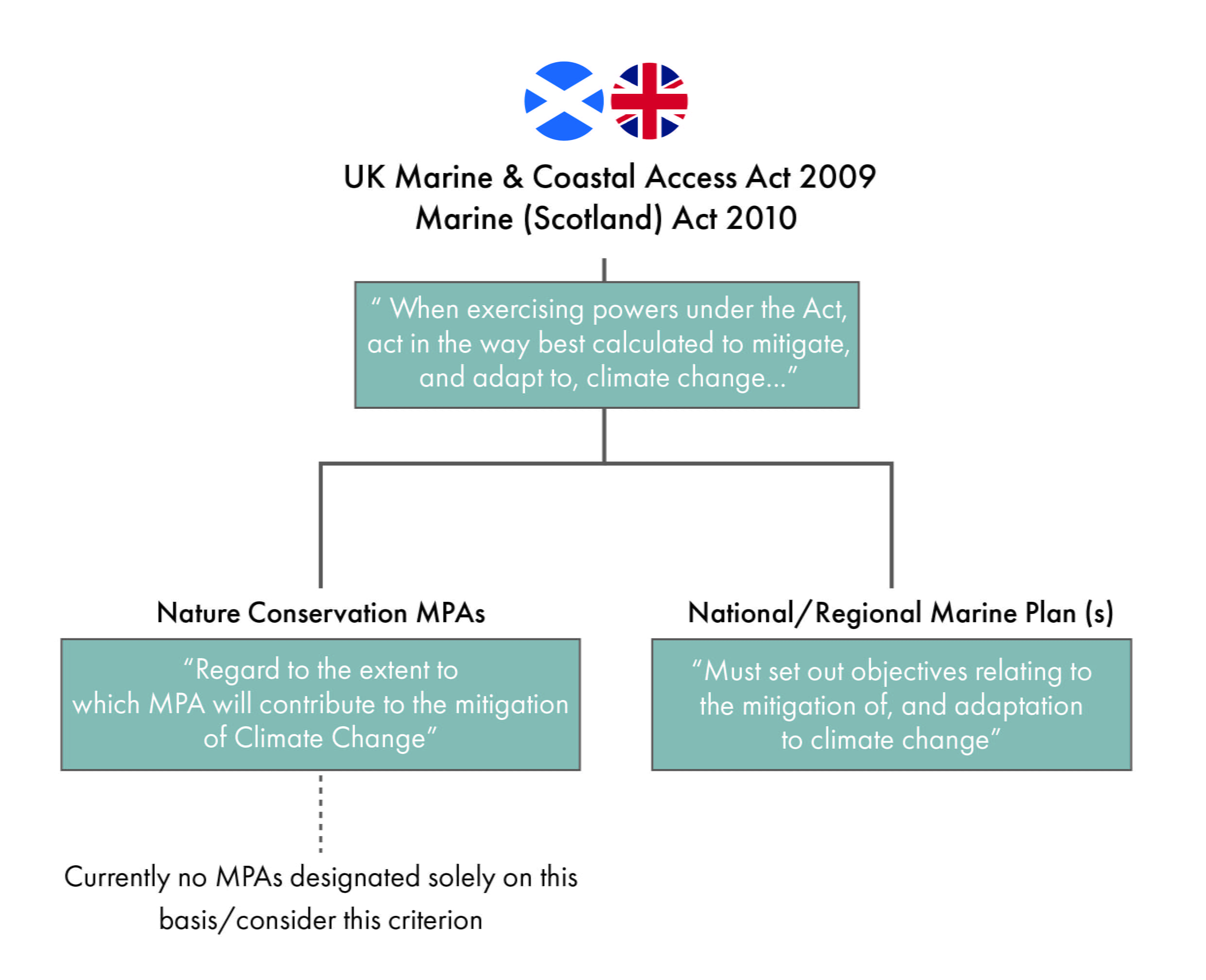
National and Regional Marine Plans
National Marine Plan
The Marine Acts require Scottish Ministers, when setting out National and Regional Marine Plans, to outline:
objectives relating to the mitigation of, and adaptation to, climate change
The current National Marine Plan (NMP), due for review in 2021, considers climate change in two distinct ways. Firstly, the NMP considers how actions under the Plan might help mitigate the degree of human-induced climate change. Secondly, it considers how actions under the Plan need to be adapted to take into account the effects of climate change.
Concerning blue carbon stores, the NMP states, under General Policy Number 5 (4.19):
Reducing human pressure and safeguarding ecosystem services such as natural coastal protection and natural carbon sinks (e.g. seagrass beds, kelp and saltmarsh) should be considered. In some cases, compensatory habitat creation or enhancement may be possible and should be considered as a last resort if significant harm cannot be avoided. Appropriate proactive opportunities for enhancing natural carbon sinks and allowing natural coastal change where possible should also be considered.
The NMP draws attention to the role of regional marine planning in safeguarding carbon stores, stating that Regional Marine Plans should:
Identify significant natural carbon sinks and seek to avoid co-location with potentially damaging activity; then
Assess the acceptability of any proposed partial loss or damage to natural carbon sinks (including any compensatory measures) through licensing or management of marine activities, balanced with priorities presented in this Plan and respective regional marine plans.
Explain how they have taken into account future climate change in terms of climate change adaptation. <applies to inshore waters only>
Regional Marine Plans
Section 5 of the Marine (Scotland) Act 2010 allows Regional Marine Plans to be developed by Marine Planning Partnerships (see MPA management). Regional Marine Plans are designed to take account of local circumstances and smaller ecosystem units, providing a more localised approach to assessing the marine environment.
There are currently no finalised regional marine plans. However, pre-consultation drafts of Regional Marine Plans for Clyde (Clyde Regional Marine Plan) and Shetland (The Shetland Islands' Marine Spatial Plan) have been developed. Both drafts outline policies for climate change mitigation in relation to the protection of known carbon stores.
For instance, the pre-consultation draft of the Clyde Regional Marine Plan states the following objectives and policies in relation to climate change mitigation and carbon stores:
Objective CC.2: Natural carbon sinks and the associated benefits and services they provide are maintained and/or where possible enhanced in the Clyde Marine Region.
Policy CC.2: Development(s) and/or activities will be supported where they can demonstrate that they will avoid damage to and/or, where possible, enhance the capacity of recognised carbon sinks in the Clyde Marine Region.
In addition, the draft Shetland Islands' Marine Spatial Plan states:
Policy MP CLIM1: Developments which have the potential to impact habitats which act as a carbon sink or protect against coastal erosion may be refused. In determining applications for development, consenting authorities should, where relevant, consider the likely impact of the proposed development on climate change, including any management and/or mitigation measures proposed by the developer. Developers may be asked to consider impacts on habitats which act as a carbon sink e.g. kelp forests and horse mussel beds.
Marine Protected Areas
In relation to the designation of Nature Conservation MPAs, Section 68 of the Marine (Scotland) Act 2010 states that:
In considering whether to designate an area, the Scottish Ministers may have regard to the extent to which doing so will contribute to the mitigation of climate change.
Scottish Ministers are therefore empowered to protect blue carbon, such as carbon 'hotspots' in seafloor sediments, on the basis that their disturbance (through a lack of protection) has the potential to result in significant CO2 emissions. However, based on a search of key public-facing documents and research on Scotland's MPA network12345, MPAs do not appear to have been designated on the basis of their contributions to climate change, and it is not clear that carbon storage/sequestration (within the context of climate change mitigation) has been considered in the designation of current or proposed future MPAs.
Currently, Nature Conservation MPAs are primarily designated on their basis of containing an MPA search feature, which protects some biological blue carbon habitats - but on the basis on their contribution to Scotland's biodiversity.
Climate Change Policy
Climate Change - the legal basis in Scotland
The Climate Change (Scotland) Act 2009 and the Climate Change (Emissions Reduction Targets) (Scotland) Act 2019 create the framework for achieving greenhouse gas emissions reductions and ensuring that Scotland is prepared for the effects of climate change.
Climate Change Plan: The Climate Change Acts require Scottish Ministers to produce a Climate Change Plan (known as the CCP) outlining specific proposals and policies for meeting greenhouse gas emissions reductions targets. A key objective of the plan is to allow Scotland to contribute to the Paris Agreement reached at the 21st Conference of the Parties of the United Nations Framework Convention on Climate Change in 2015.
Climate Change Adaptation Programme: The Climate Change Acts require Scottish Ministers to produce a Climate Change Adaptation Programme addressing the risks outlined by the UK Climate Change Risk Assessment (UK CCRA) 2017, published under section 56 of the UK Climate Change Act 2008.
Scotland's Climate Change Plan, published in 2018, acknowledges the importance of blue carbon stores but does not contain any specific policies or proposals to protect known blue carbon stores or habitats. The Plan outlines the Scottish Government's £570,000 commitment to the Scottish Blue Carbon Research Forum, which aims to understand how marine and intertidal habitats sequester and store carbon and the effects of human activities on these habitats, to inform future policy.
Climate Change Plan 2018–2032 - Update
In late 2020, the Scottish Government published the draft update to the Climate Change Plan 2018 – 2032 (CCPu), setting out the strategy to meet the new emissions targets stipulated by the Climate Change (Emissions Reduction Targets) (Scotland) Act 2019. The update aims to achieve the dual targets of lifting an economy out of recession following the COVID-19 pandemic whilst protecting and improving the environment at the same time.
As with the CCP, the draft CCPu does not contain any specific policies or proposals relating to blue carbon stores. Instead, the CCPu refers to the Scottish Government's upcoming Blue Economy Action Plan, announced in the 2020-21 Programme for Government, in which the Government will:
Provide leadership through collaboration and innovation, maximising the impact of public investment and developing better regulation to help manage the shared use of the seas by Scotland’s marine sectors, communities and ecosystems.
Optimise opportunities in order to unlock the significant inclusive growth potential of Scotland’s marine space whilst supporting a transition to net zero.
Climate Change Policy and Marine Protected Areas
Since the publication of the Climate Change Plan in 2018, the Climate Change (Emissions Reduction Targets) (Scotland) Act 2019 was passed, setting greater targets for emissions reductions. The Act prompted the publication of the draft Update to the Climate Change Plan 2018–2032 (CCPu).
The Act additionally highlights the role of Marine Protected Areas in the protection of carbon stores and their consideration in subsequent climate change plans, stating under section 35(15) that:
The [Climate Change] plan must also set out the Scottish Ministers’ proposals and policies regarding the consideration of the potential for the capture and long-term storage of carbon when designating marine protected areas under section 67 of the Marine (Scotland) Act 2010.
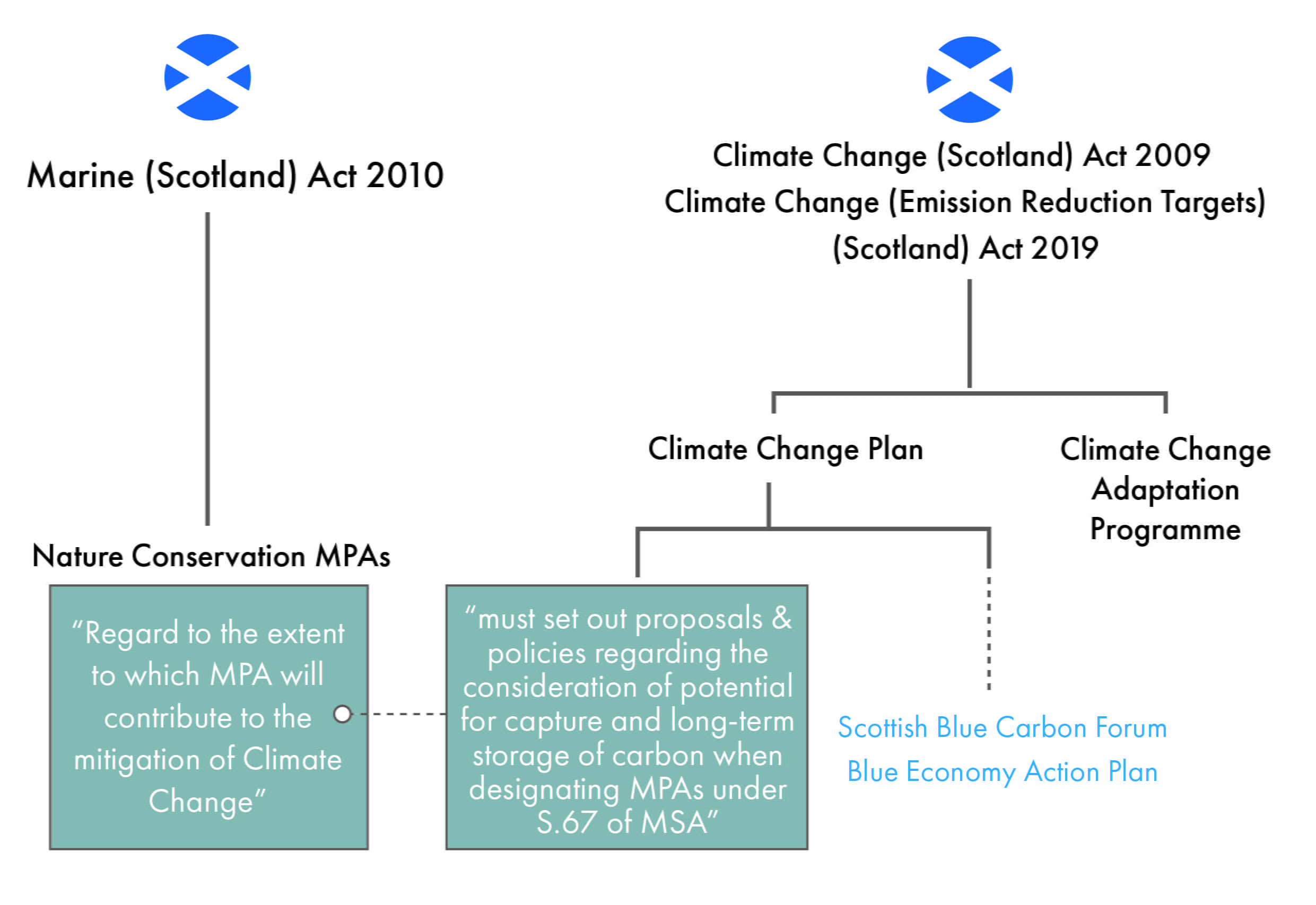
During the 2021 parliamentary scrutiny of the draft CCPu, the Environment, Climate Change and Land Reform (ECCLR) committee heard evidence that the Scottish Blue Carbon Research Forum has provided a good understanding of where ‘carbon hotspots’ can be found in the marine environment1. It further heard that the 2021 review of the National Marine Plan is an opportunity to examine spatial management of marine carbon and review how fisheries are managed. Therefore, as part of a broader suite of recommendations, the ECCLR committee recommended that the Scottish Government:
Provides clear guidance on the role of spatial management in protecting blue carbon hotspots from pressures such as mobile bottom-contacting fishing gear.
Ensures that blue carbon storage and sequestration capacity is taken into account in proposals for management measures in Marine Protected Areas.
Parliamentary scrutiny of the CCPu
During parliamentary scrutiny of the draft CCPu, the Environment, Climate Change and Land Reform Committee (ECCLR) drew attention to the lack of policies and proposals relating to the protection of blue carbon in the CCPu. The ECCLR committee heard evidence of the research emerging from the Scottish Blue Carbon Forum of 'hotspots for carbon burial' in Scotland's seas134. The scrutiny culminated in the Environment, Climate Change and Land Reform Committee (ECCLR) recommending that the Scottish Government5:
Brings forward policies on how to protect blue carbon stores through the forthcoming update of the National Marine Plan and the development of the Blue Economy Action Plan and reflects this intention in the final CCPu.
Provides clear guidance on the role of spatial management in protecting blue carbon hotspots from pressures such as mobile bottom-contacting fishing gear.
Ensures that blue carbon storage and sequestration capacity is taken into account in proposals for management measures in Marine Protected Areas.
Provides further information on how it will ensure that the Blue Economy Action Plan reconciles the need to ensure protection of natural capital such as blue carbon and marine biodiversity hotspots with socioeconomic priorities of coastal communities.
Works with the UK Department for Business, Energy and Industrial Strategy to incorporate blue carbon in saltmarsh and seagrass ecosystems into the UK's National Atmospheric Emissions Inventory and therefore Scotland’s greenhouse gas inventories.
Takes a leadership role in promoting the opportunities of blue carbon and presses for the inclusion of blue carbon in the GHG inventory, including with the UK Government and in the COP26 negotiations.
(Hyperlinks not in original)
During ECCLR scrutiny of the CCPu, in response to why the CCPu does not include specific policies and proposals on blue carbon the Cabinet Secretary for Environment, Climate Change and Land Reform responded that:
The Scottish Government is doing significant work to protect these important habitats through wider policy frameworks - for example through our Marine Protected Area (MPA) network. On 25 September 2020, we designated the West of Scotland MPA, which is the largest MPA in national waters in North-East Europe with an area of over 100,000 square kilometres. This designation locks in protection for deep sea sediment, which has been shown to be an important blue carbon habitat. Many blue carbon habitats are Priority Marine Features (PMFs), and we are seeking build on existing protections from the impact of human activities through the marine licencing process by adopting proposals to introduce fisheries management measures in our MPA network, and for PMFs outside the MPA network, as well as through the Future Fisheries Management Strategy.
Greenhouse Gas Inventories
In it's 2021 recommendations to Government on the Update to the Climate Change Plan (CCPu), the Environment, Climate Change and Land Reform (ECCLR) Committee recommended that the Scottish Government:
Works with the UK Department for Business, Energy and Industrial Strategy to incorporate blue carbon in saltmarsh and seagrass ecosystems into the UK's National Atmospheric Emissions Inventory and therefore, Scotland’s greenhouse gas (GHG) inventories.
Takes a leadership role in promoting the opportunities of blue carbon and presses for the inclusion of blue carbon in the GHG inventory, including with the UK Government and in the COP26 negotiations.
What is a greenhouse gas (GHG) inventory?
A greenhouse gas (GHG) inventory is an accounting of all the emissions and uptake of greenhouse gases and is central to developing strategies to reach net-zero. Blue carbon ecosystems are not currently incorporated into Scotland's GHG inventories, and therefore are not considered in Scotland's targets towards reaching net zero.
Scottish greenhouse (GHG) inventories are calculated by the National Atmospheric Emissions Inventory (NAEI), led by the UK Department for Business, Energy, and Industrial Strategy (BEIS). The data and methods used to derive GHG inventories have been developed to be consistent with methods defined within international guidance provided to all countries via the Inter-governmental Panel on Climate Change (IPCC). All countries that report to the United Nations Framework Convention on Climate Change (UNFCCC) must use these estimation methods from the agreed guidelines and good practice to ensure that the GHG emissions for each country are complete and comparable.
Blue Carbon and GHG Inventories
Currently, the UK's NAEI does not include biological or geological blue carbon ecosystems to calculate GHG inventories. However, on an implementation level, mangroves, salt marshes and seagrasses can be included in national accounting, according to the IPCC 2013 Supplement to the 2006 Guidelines for National Greenhouse Gas Inventories: Wetlands1. This supplement has been used by BEIS to develop and implement a new method for reporting GHG emissions from peatlands in the UK’s emissions inventory. These guidelines provide ready opportunities for BEIS to incorporate saltmarshes and seagrasses into UK GHG inventories. Currently, there are no internationally-recognised frameworks for incorporating sedimentary carbon stores into the calculation of national GHG inventories.
During ECCLR scrutiny of the CCPu, in response to why the CCPu does not include specific policies and proposals on blue carbon, the Cabinet Secretary outlined that:
Blue carbon is not currently included in the UK greenhouse gas inventory. This means that policies and proposals in this space could not contribute to progress to meeting Scotland’s statutory emissions targets, which in turn means that they fall outside the formal scope of the CCPu.
Scottish Government officials are also working with UK counterparts on developing the evidence base to support including two blue carbon habitats (saltmarsh and seagrass) within the UK emissions inventory as soon as it is appropriate to do so. Decisions on technical changes to the UK inventory are, however, made solely by BEIS.
Enhancement and Restoration
Nature-based Solutions
What are Nature-based Solutions?
Nature-based Solutions (NbS) are defined by the International Union for the Conservation of Nature as:
actions to protect, sustainably manage, and restore natural or modified ecosystems, that address societal challenges effectively and adaptively, simultaneously providing human well-being and biodiversity benefits.
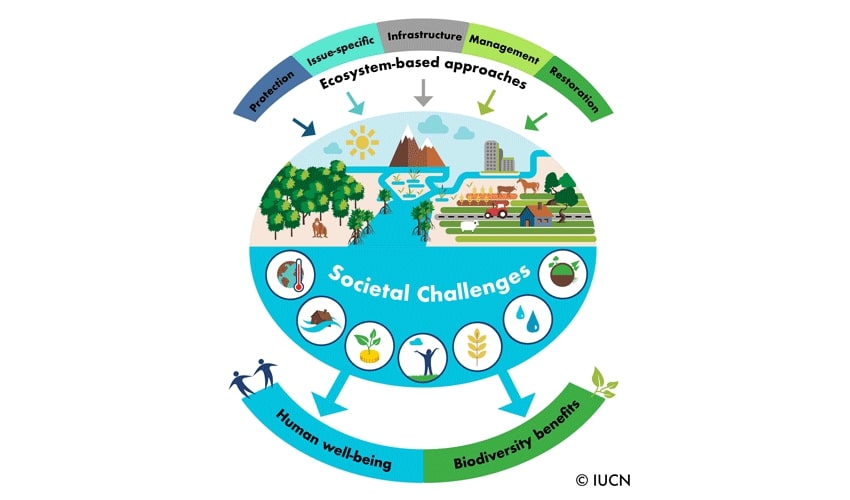
It is estimated that annually 1,000 km2 of coastal blue carbon habitats are lost across the globe, emitting 500 Mt CO2 per year1. Therefore, restoration of blue carbon habitats is recognised as an effective nature-based solution (particularly mangroves, saltmarshes and seagrasses), not only a means to prevent additional emissions and increase carbon sequestration globally but to also increase the climate-change resilience for local communities (see Climate Change Adaptation Programme). This is alongside a host of other biodiversity and ecosystem benefits.
Coastal ecosystems, in particular, are seen as an attractive nature-based solution, as their carbon sequestration per unit area of restored land is often high compared with terrestrial environments. This is demonstrated in Scotland: healthy saltmarshes are predicted to sequester around 440 g CO2-eq per m2 per year, greater than the sequestration potential of Scottish peatlands (48 - 280 CO2-eq per m2 per year) and similar to Scottish forestry sequestration (190 - 700 CO2-eq per m2 per year).
The recognition of blue carbon habitats as effective nature-based solutions has led to the development of international frameworks to facilitate restoration projects. For instance, The Nature Conservancy has partnered with The International Union for Conservation of Nature IUCN) to develop a global model and map of mangrove restoration potential to help practitioners prioritise areas2, and as a way to support and encourage mangrove restoration projects globally.
Nature-based solutions & Climate Change Plan
Scotland's Climate Change Plan (CCP) does not currently contain policies or proposals for blue carbon NbS, but contains policies for forestry and peatland NbS. In the draft update to the Climate Change Plan, the Scottish Government states it:
is committed to deploying nature-based solutions at scale and in a sustainable and managed way and that nature-based solutions will form a key part of the coordinated approach to climate change, biodiversity, infrastructure, planning, land use, marine and economic strategies
The CCP and CCPu specifically set out to use NbS in two key ways: restoration of 250,000 ha of degraded peatland and increasing forest cover by 21% by 2032.
Saltmarsh Restoration
There are currently no policies to manage coastal wetlands (such as saltmarshes) as Nbs approaches. However, during 2021 scrutiny of the update to the climate change plan, the Environment, Climate Change and Land Reform (ECCLR) Committee heard evidence that saltmarshes can be managed through coastal realignment1, which also provides benefits for biodiversity, providing multiple ecosystem services. The ECCLR Committee heard that that linking rural policy and environmental land management schemes is a mechanism for delivering this1.
Despite not being included in policies and proposals, restoration of blue carbon ecosystems is ongoing in Scotland. Saltmarsh restoration in Scotland is already showing evidence of benefits to carbon storage and biodiversity. However, it is uncertain whether saltmarsh restoration in Scotland alone offers a significant additional carbon sequestration capacity in the context of Scotland's net-zero ambitions, as Scotland only has 14% of the UK's saltmarsh areal extent. There has also been little research into whether other coastal and marine habitats in Scotland are viable NbS. Regardless of the impact of restoration on additional carbon sequestration, restoration still provides known benefits for coastal protection and resilience and biodiversity.
Current saltmarsh restoration projects
Saltmarsh restoration projects are ongoing as a natural solution to the increasing problem of coastal erosion, and provide opportunities to increase carbon sequestration of coastal ecosystems. Saltmarsh restoration efforts on the Eden Estuary in Fife have taken place since 1999, using direct transplants from donor marsh sites within the estuary to enhance degraded saltmarsh and extend areas of saltmarsh3. Restoration projects provide a valuable system in which to study the development of restored areas to sequester and store carbon. Restoration has increased the total amount of carbon stored in sediment and vegetation by over 0.5 t, by promoting greater carbon burial4. However, given the relatively small spatial extent of saltmarshes, saltmarshes' utility as a significant additional carbon store is predicted to be small4. In the future, it is projected that the value of saltmarshes as a carbon store will increase as their area and health increases.
Saltmarsh restoration is also predicted to provide additional benefits such as enhanced biodiversity and coastal flood protection, which remain active areas of research. Saltmarsh restoration in the Eden Estuary found that 2-3 years after restoration the abundance and diversity of benthic macrofaunal organisms (organisms greater than 0.5 mm that live on, in, or at the sediment-water interface) was comparable to natural salt marsh sites6. The coastal defence provision of restored saltmarshes was equivalent to natural salt marsh sites following 10 years. The research also indicated that local communities prefer and are willing to pay more to support nature-based coastal defences, like saltmarshes, within the Eden Estuary.
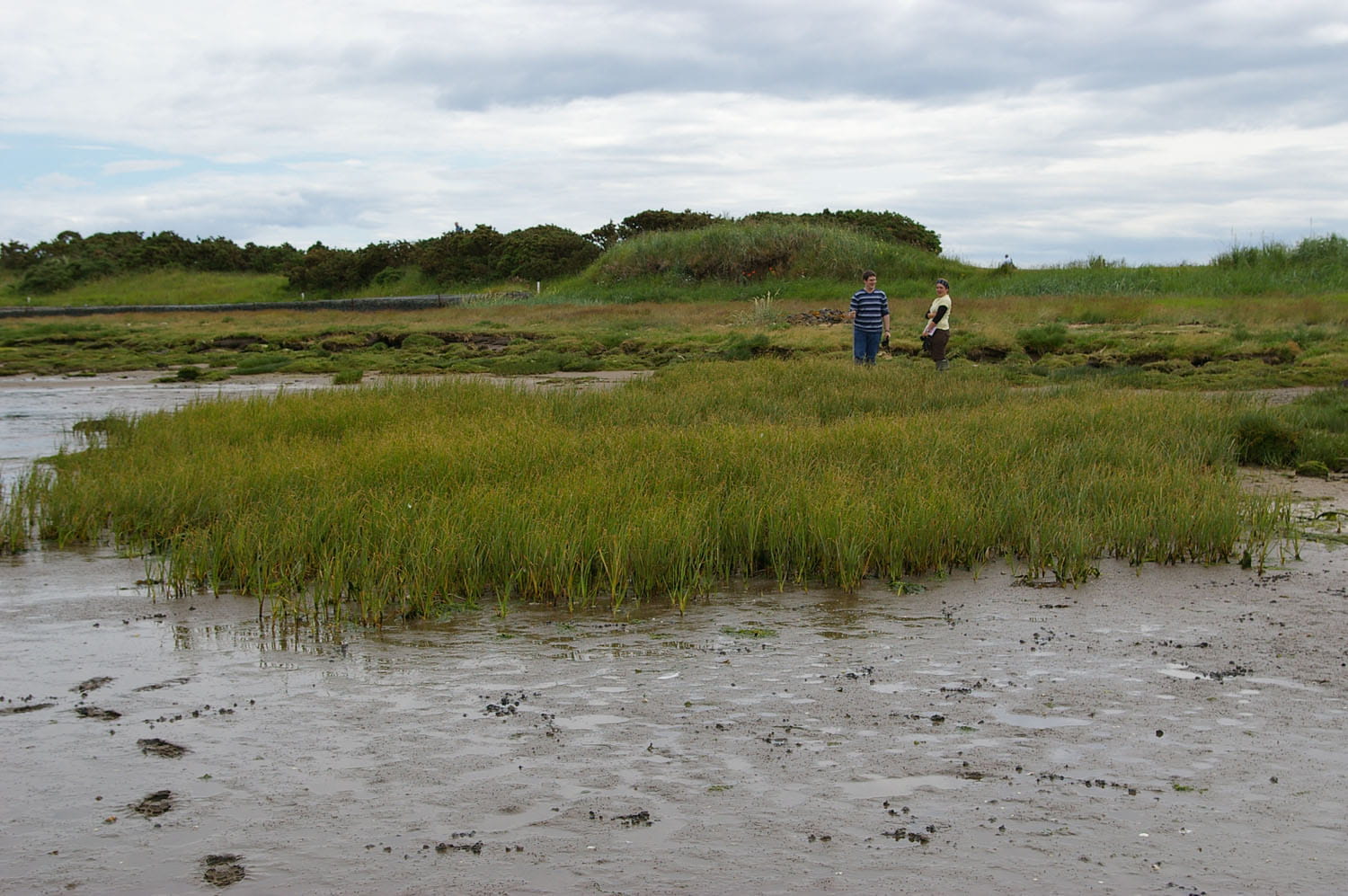
Climate Change Resilience
In addition to storing carbon, coastal ecosystems (such as saltmarshes, dune and machair) play a key coastal defence role by dissipating wave energy. Climate change is associated with changes in sea storminess and wave intensity, and therefore the importance of coastal wetlands in climate change resilience has been acknowledged in Scottish Government's Climate Change Adaptation Programme.
The Climate Change Adaptation Programme does not lay out any specific policies or proposals which protect coastal wetlands but draws attention to measures in place to protect marine environments and habitats through the National Marine Plan and the Scottish Biodiversity Strategy.
Protection of Coastal Environments
Scotland's Dynamic Coast project, a project commissioned by the Scottish Government to deliver an assessment of coastal changes, to support Scotland's Climate Change Adaptation Programme recently reported that1:
Whilst consideration of coastal erosion and its links with coastal flooding and the combined anticipated increase associated with climate change is acknowledged within national policies, there appears to be little or no consideration given to the types of adaptation policies and financial levers which will be required to manage both existing and future risk.
Climate Change Mitigation Technologies
The transition to net-zero has given rise to a number of technological advancements to enhance carbon sequestration or store carbon. For example, the Scottish Government's draft Climate Change Plan Update relies on the use of negative emissions technologies (NETs) such as carbon capture and storage, where emissions from fossil fuels are injected into geological stores (e.g. empty oil and gas reservoirs).
Another strategy to enhance atmospheric carbon removal is geoengineering. Geoengineering is the deliberate large-scale manipulation of an environmental process that affects the earth's climate in an attempt to counteract the effects of global warming.
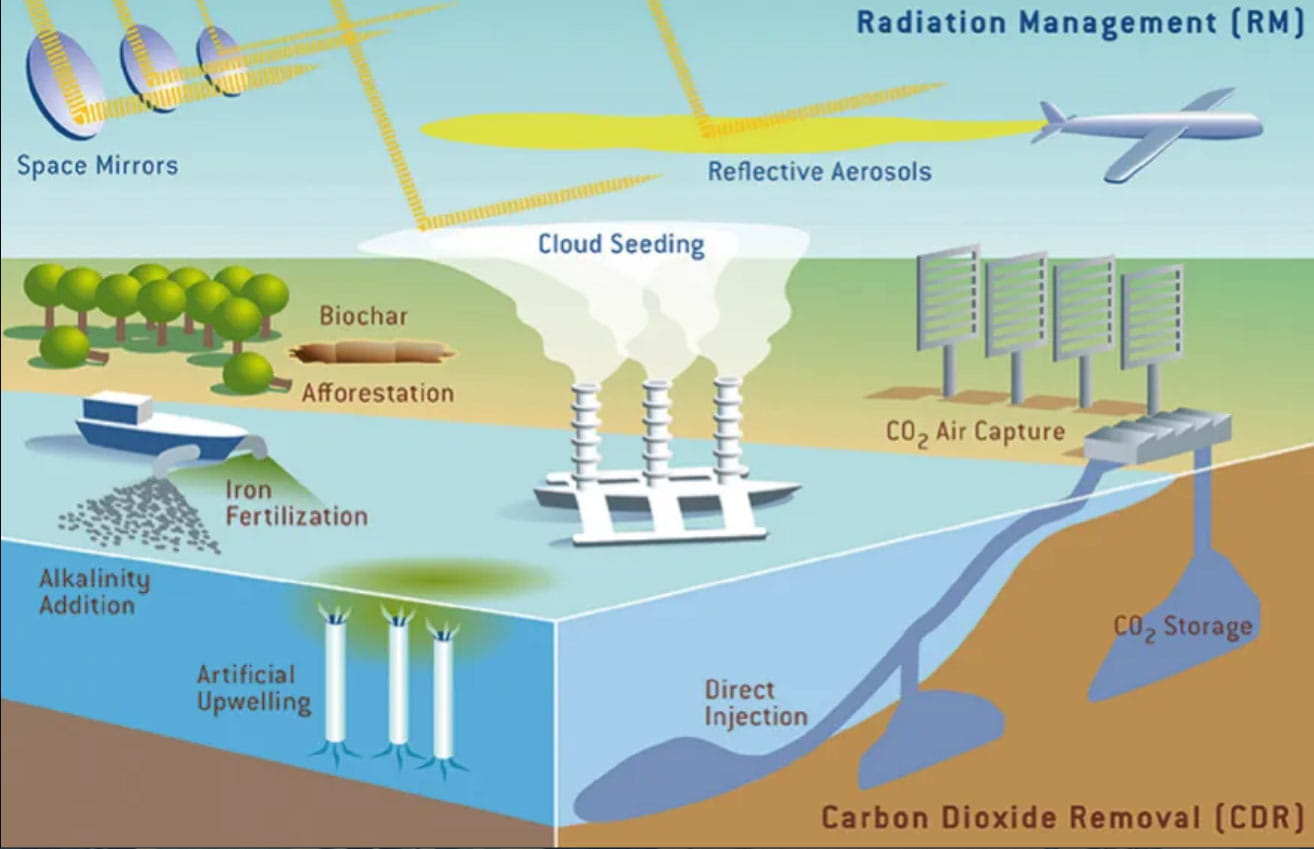
Blue carbon habitats with their natural carbon sequestration capacity have inspired the development of geoengineering strategies. For example, blue carbon-based geoengineering techniques include mass macroalgal(kelp) cultivation and ocean fertilisation to stimulate phytoplankton blooms. However, the success of these techniques depends on the fate of the carbon once it has been sequestered from the atmosphere. To be effective, the carbon in living biomass must either:
Enter long-term carbon storage (i.e. into geological seafloor sediments1) or
Be harvested before it degrades (e.g. harvesting kelp for aquaculture).
Numerous factors influence how much carbon from kelp or phytoplankton biomass is subsequently stored long-term in marine sediments, such as oxygen levels in the water column, productivity, and mixing processes2. If not managed correctly, promoting kelp or phytoplankton can lead to negative impacts. For instance, if phytoplankton (microalgae) blooms do not sink through the water, they can degrade on the sea surface, rapidly consuming oxygen and leading to mass fish mortality. Ensuring that blue carbon based geoengineering strategies do not have detrimental effects is an area of ongoing research.